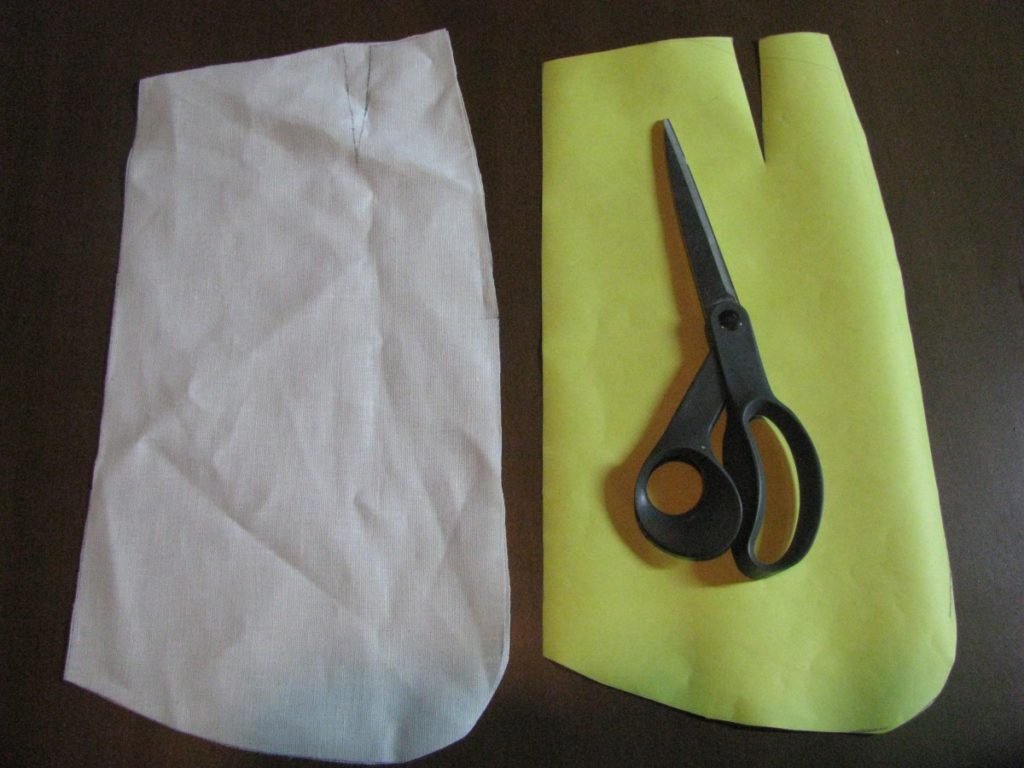Month: November 2019
Cutting the Facings
Drafting a pattern for the forepart facings is quite simple to do and relies more on your coat size and artistic skill than on specific numbers and measurements. At the shoulder, about 2 – 2 1/2 inches from the neck point, begin drawing your facing, following the general shape shown, and ending at the waistline, about 2 1/2 – 3 inches from the edge of the coat.
I usually just account for the seam allowance along the inside edge as I’m drawing, but you can add the 1/4″ seam allowance afterwards, if you prefer. It’s also a good idea to add an inlay to the top of the shoulder, and the bottom of the facing, and possibly along the neck and top of the lapel.
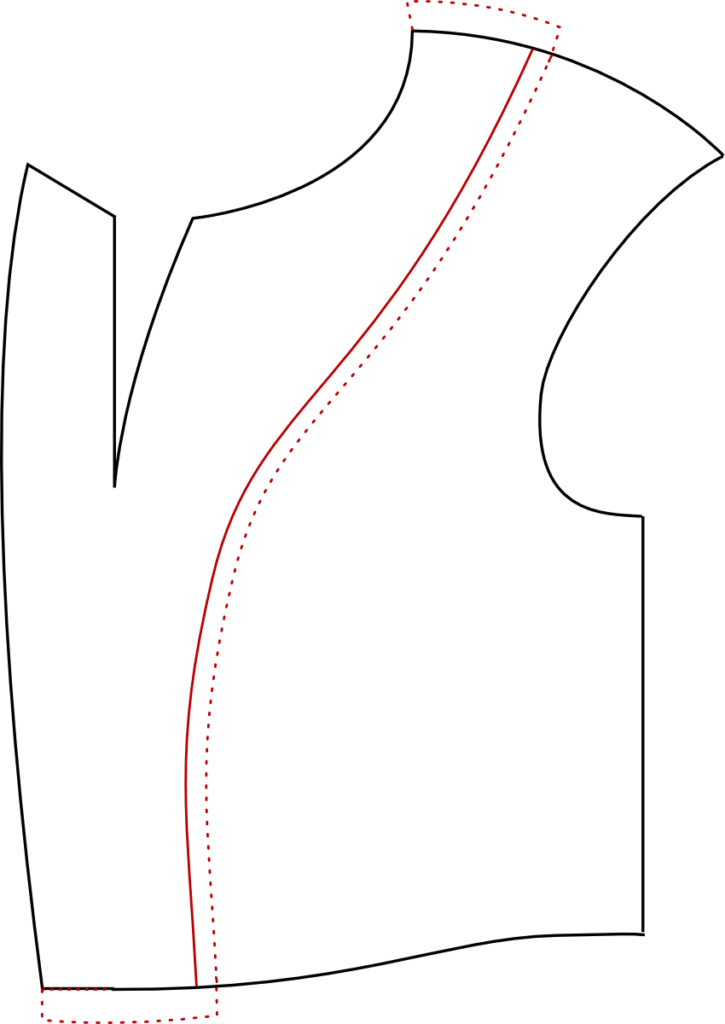
The first thing I did in actually drawing the lapels was to trace the outline of my forepart onto the linen. Remember to include all darts – lapel and gorge – and the roll line.

Here’s the bottom front edge of the facings drawn. I only traced in about 3 inches for the bottom of the facings. I accidentally left out the inlay at the bottom, which worked out okay anyway, but it’s best to put one in just in case.
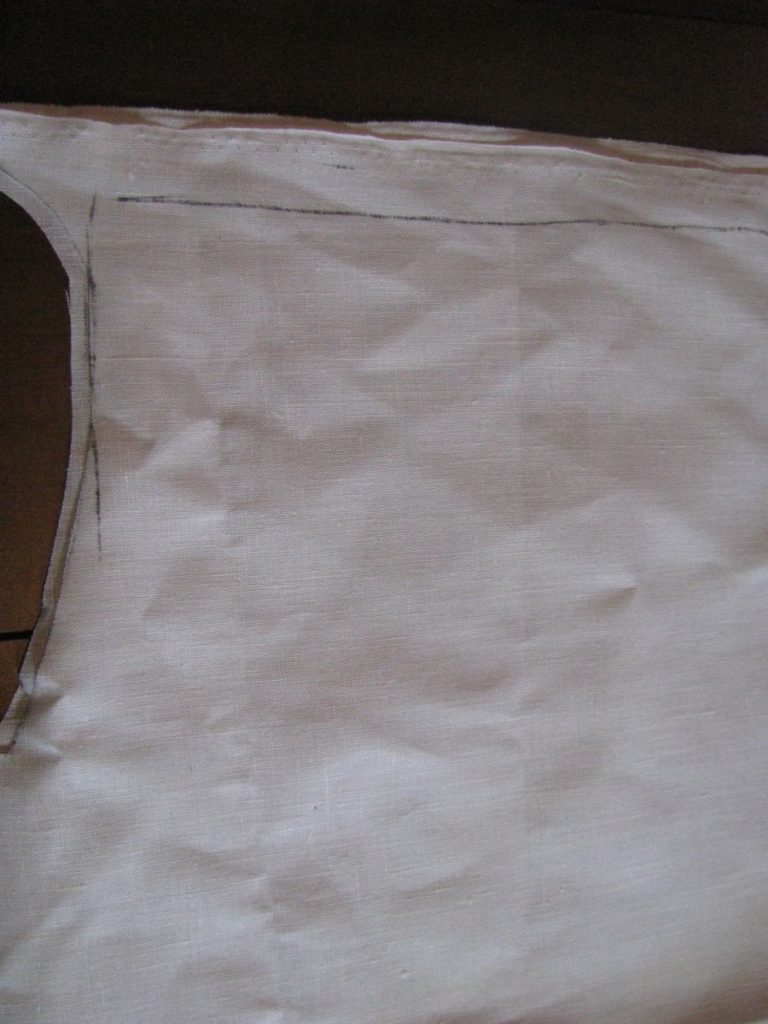
Here I used a curved ruler to draw in the inside edge of the facing. You can see how open it is to personal preference, as I changed it two or three times before I was happy.
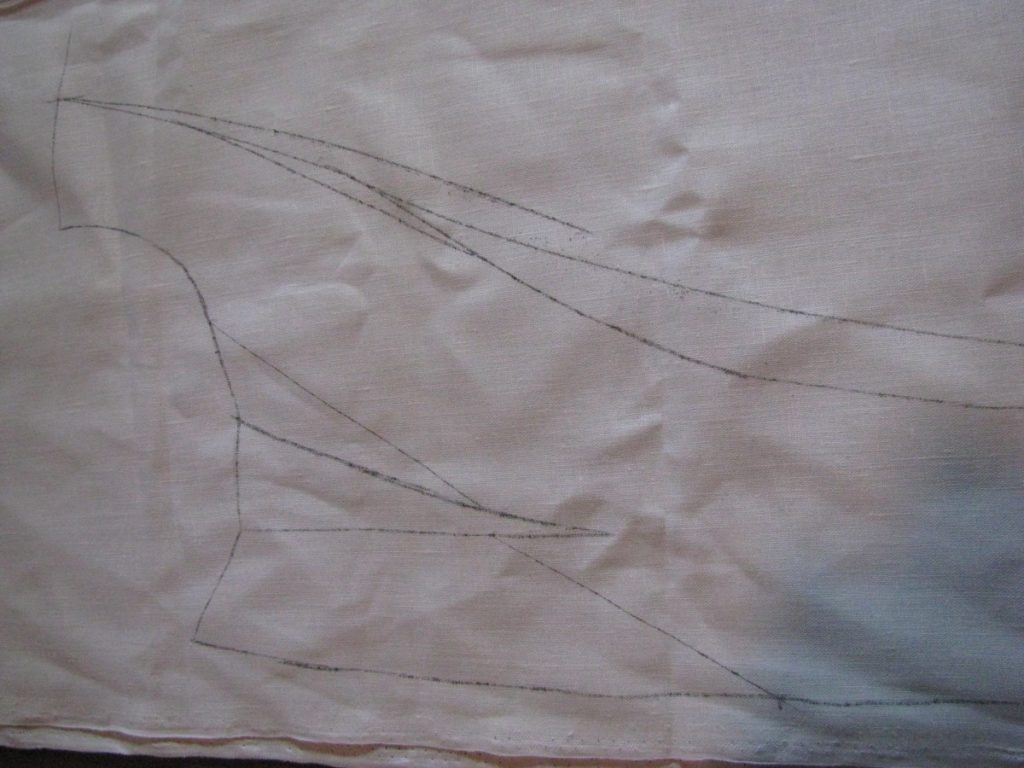
Here are the facings cut out. At this point, you’d add the tailor’s tacks and sew the darts as you did on the forepart.
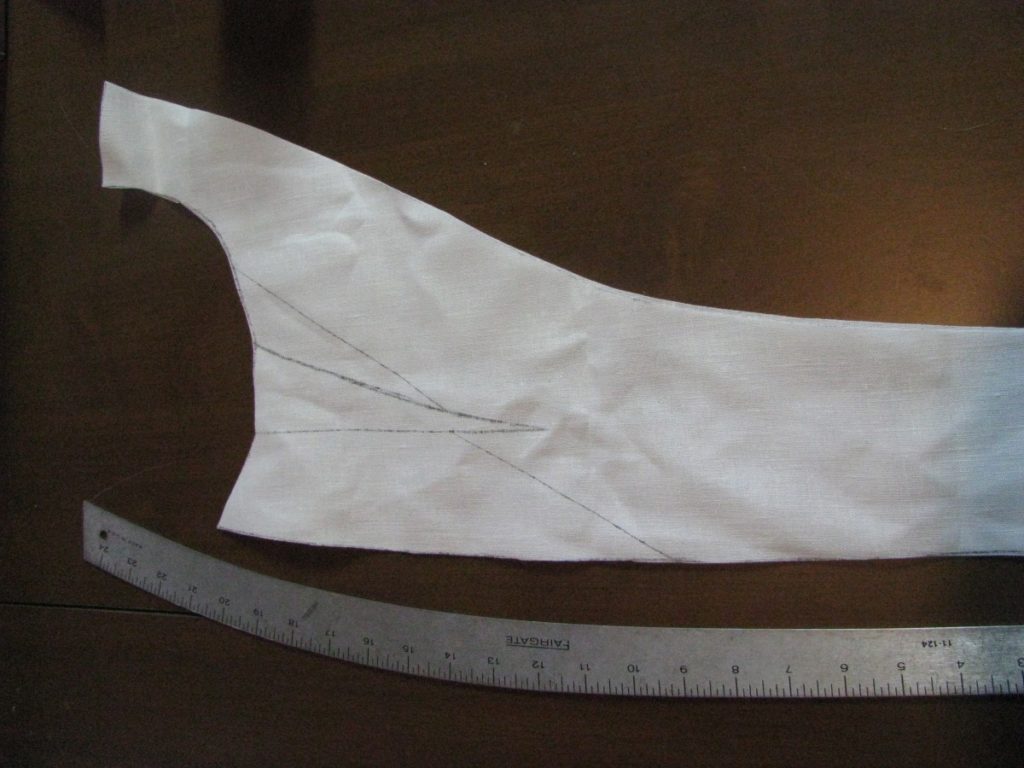
Hemming the Skirts
Before attaching the facing, it’s a good idea to finish the hem of the coat before things get covered up. First, lay both halves of the coat on the table, with the back seams next to each other, and ensure that the back skirts are of equal length. Mark any adjustments, if necessary. Then take a look at the skirt and back skirt hems. Ideally, they would be equal, or the back piece slightly longer, but as you can see here, I must have made a measuring mistake, as I’m off by an inch.
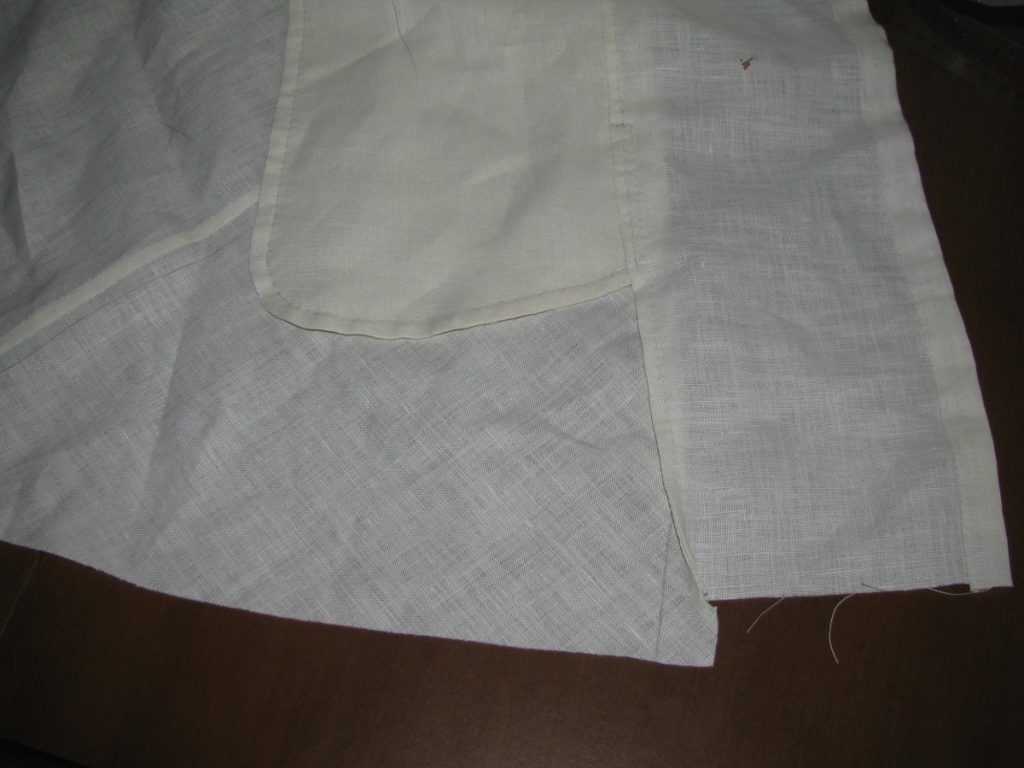
Variations in length can also occur during the sewing process, as things can get accidentally stretched out of shape if you’re not careful.
Redraw the hemline on both sides as necessary. You can see why adding an inlay to the back is a good idea – it would have saved me redrawing the skirt hem, and would have been easier to shorten the back piece, which is just a straight seam.
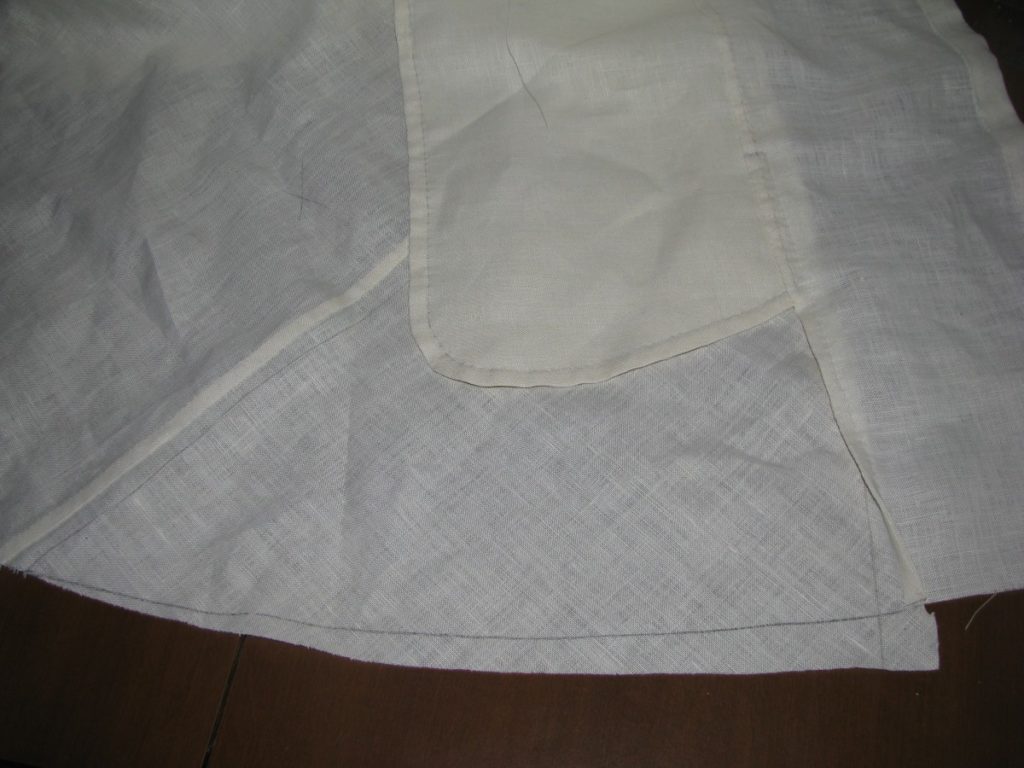
Cut off the excess fabric from either the skirt or the back skirt, as necessary.
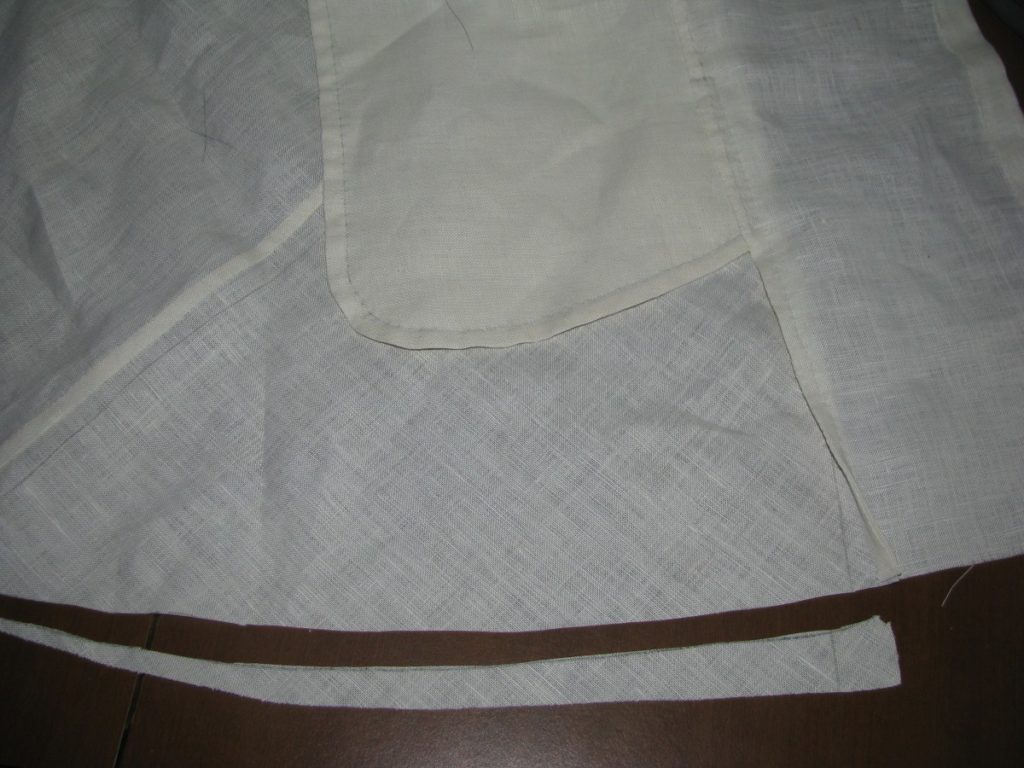
Mark a line 1/2″ from the bottom of the skirt, as a guide when folding over the hem.
Hemming the Skirt – Method One
There are two methods to hemming the skirt, choose which ever one you prefer. The first is the simplest, and simply involves folding up the bottom hem 1/4″, and then folding that over again, concealing the raw edge. Baste and then fell down, ensuring the stitches catch only a thread or two of the right side of the coat.
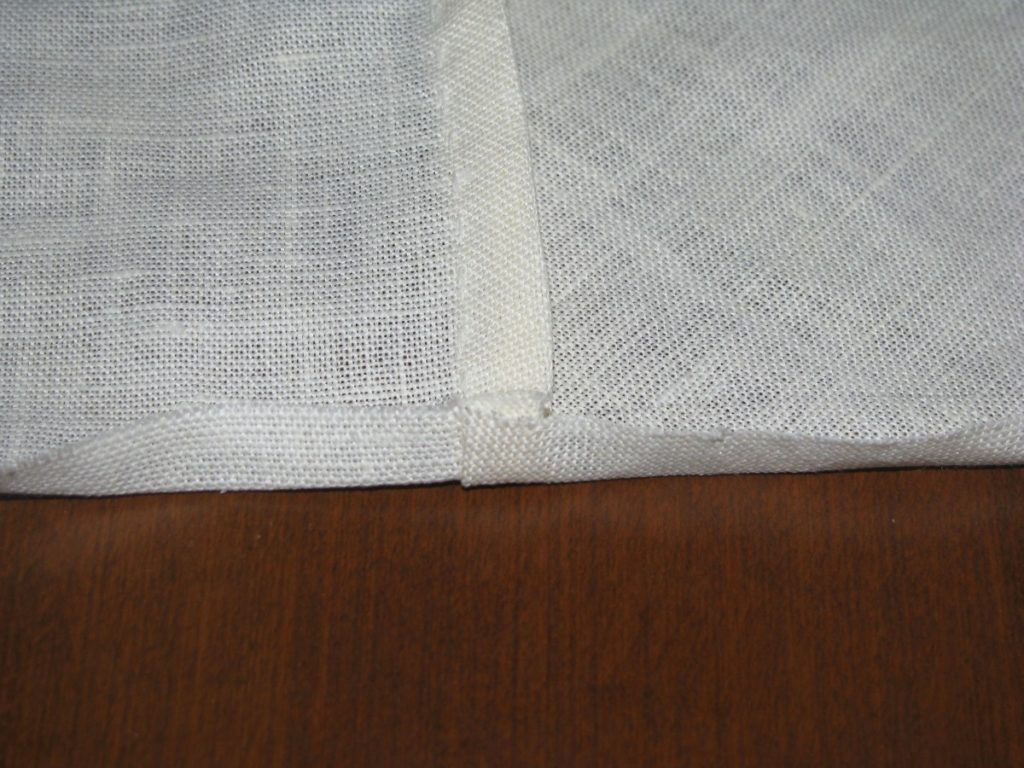
When you get to the back pleat area, the pleat is opened up completely and then the hem folded over. While this method allows the pleats to drape more freely, it is also somewhat more rumpled looking near the bottom, and you’ll have to press the area more frequently.
Hemming the Skirt – Method Two
The second method, and the one I decided to use for this coat, involves first basting the pleat closed. The pleat should be the same width at the bottom as it is at the top. Baste from the bottom of the skirt to the bottom of the pockets. Here’s the view from the outside back of the coat.
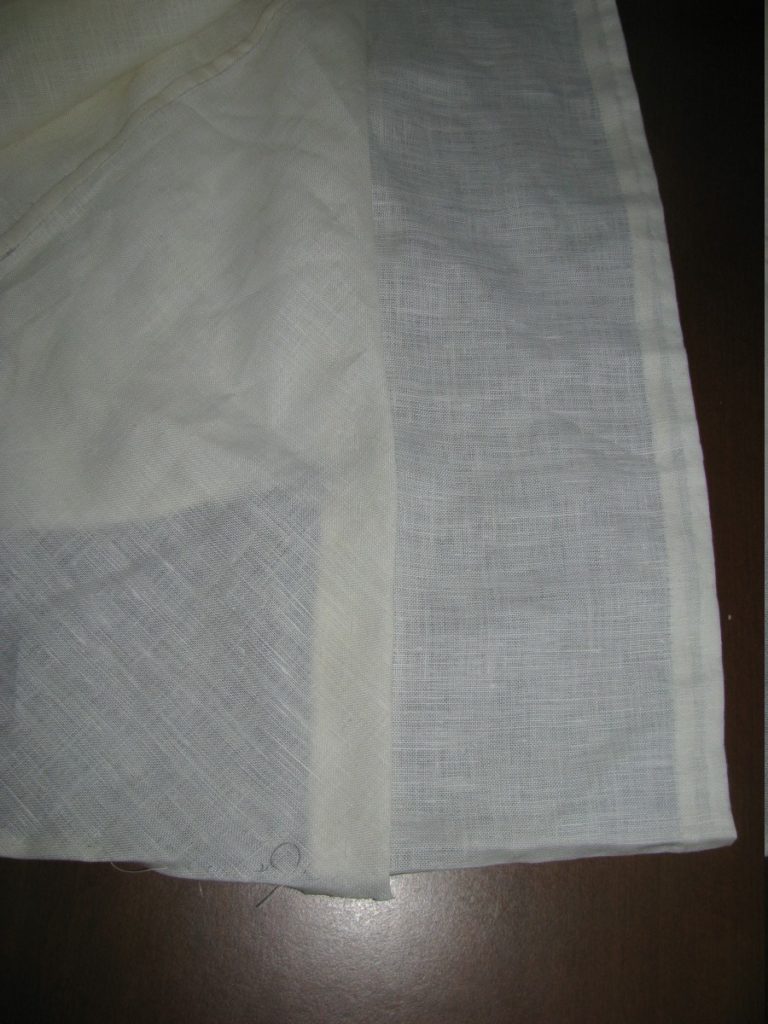
The inside of the coat, showing the basting stitches holding down the pleat.
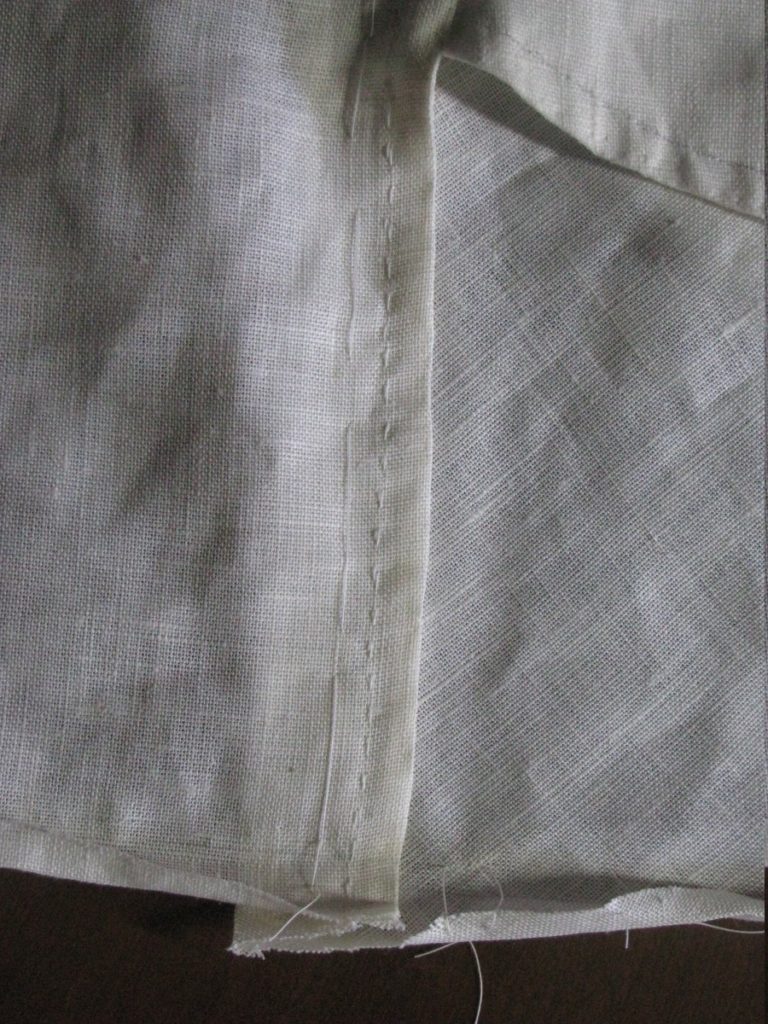
The hem is then folded up 1/4″ as in the first method, this time catching all layers of the plait at once. Fold the hem once more to conceal the raw edge, baste, and fell.
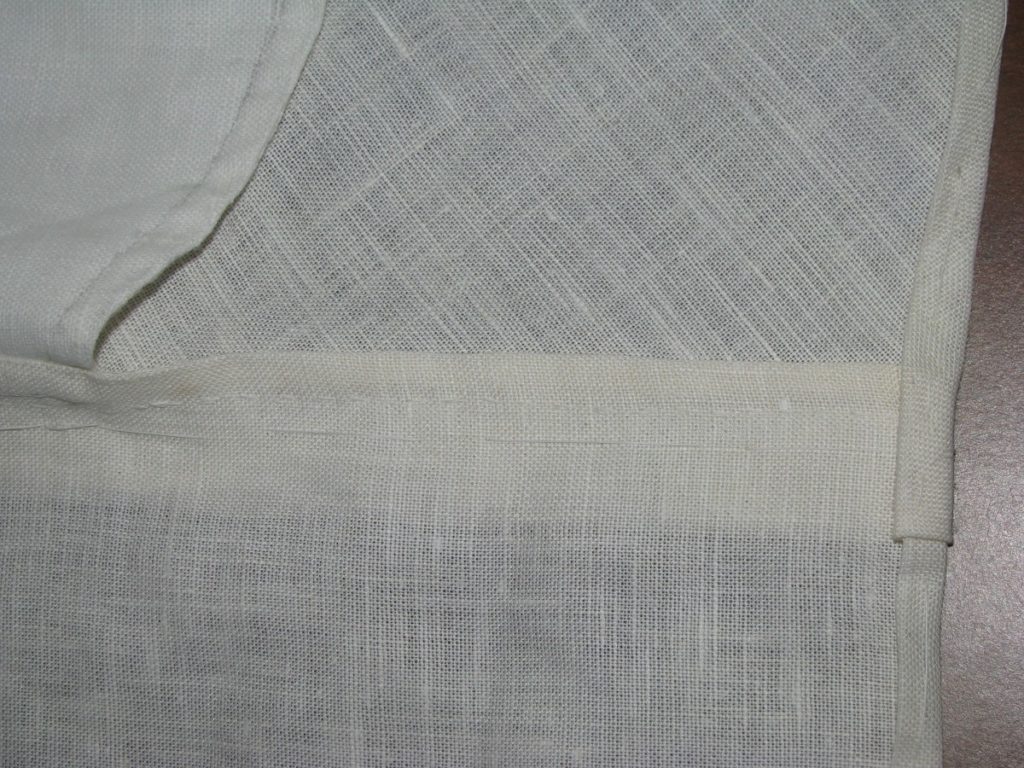
Taping the Fronts
Now we will apply stay tape along the center front of the coat, and the top of the lapel. This has a couple of purposes: it gives strength to the area and prevents the front from stretching out of shape, and it also provides a crisp and firm edge to the coat.
Beginning about 5/8 from the bottom of the coat, lay the stay tape onto the front, just behind the seam line you marked earlier. Baste in place as you work your way up the coat.
Ignore the lower line in this photo, that was an error on my part.
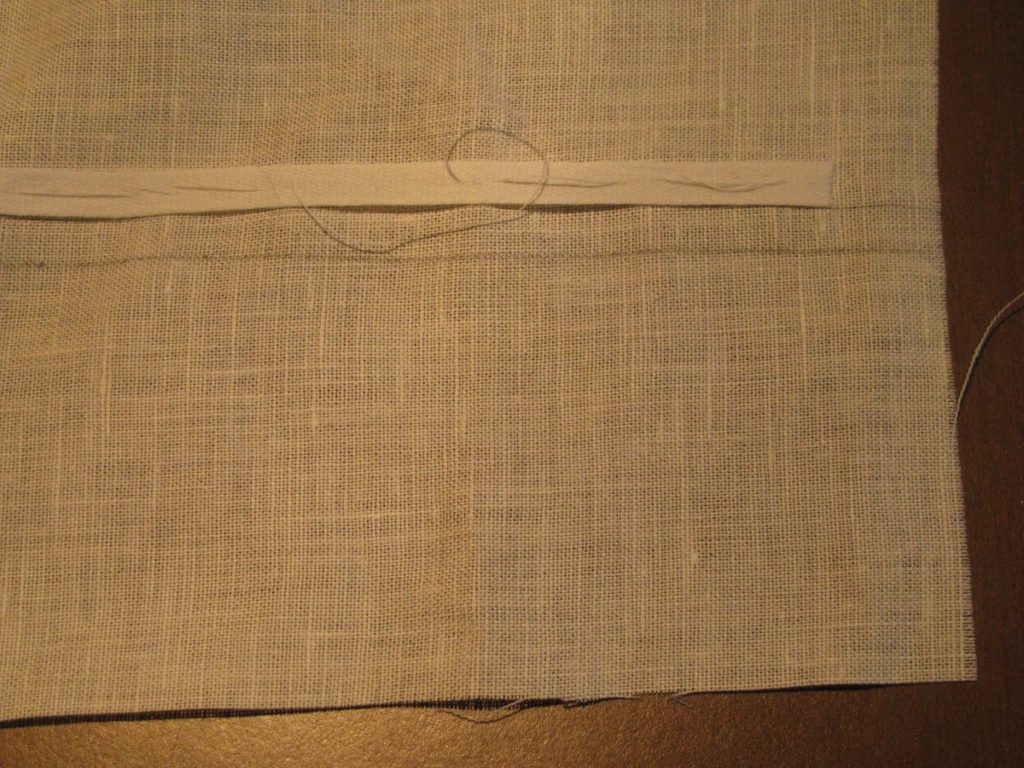
Continue basting up the skirt, past the waist.

This photo gives a good idea of the placement of the stay tape behind the seam line. It is not quite touching the line. I accidentally left this step out, but there should be a button stay under the stay tape at this point. The stay tape should extend off the edge of the linen stay by about a 1/16 of an inch. Pictures below for clarification.
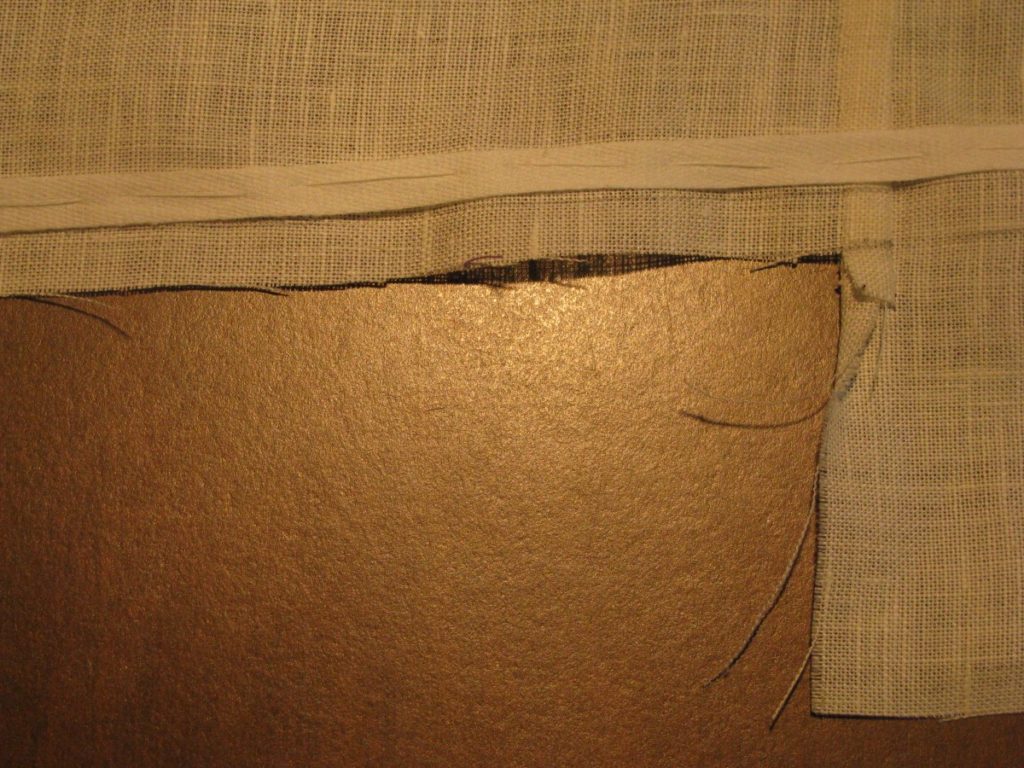
Just below the roll line, make a back stitch in place to keep the tape from moving, and then work a little fullness into the stay tape, so that the lapel can roll freely.
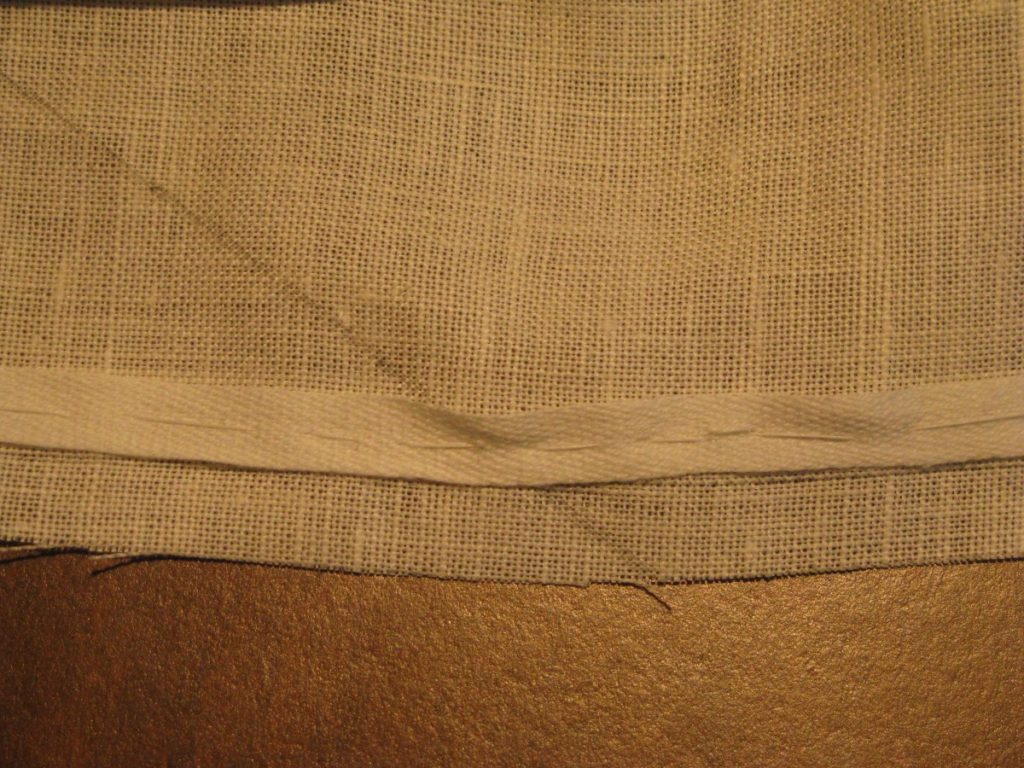
At the top corner, the stay tape must be mitered to prevent bulk in the area. First trim diagonally to the corner of the lapel, stopping just at the edge (don’t cut all the way through the stay tape). The fold the tape into position along the top of the lapel, and trip off the overlapping area. This is hard to explain, so please watch the video below for a demonstration.
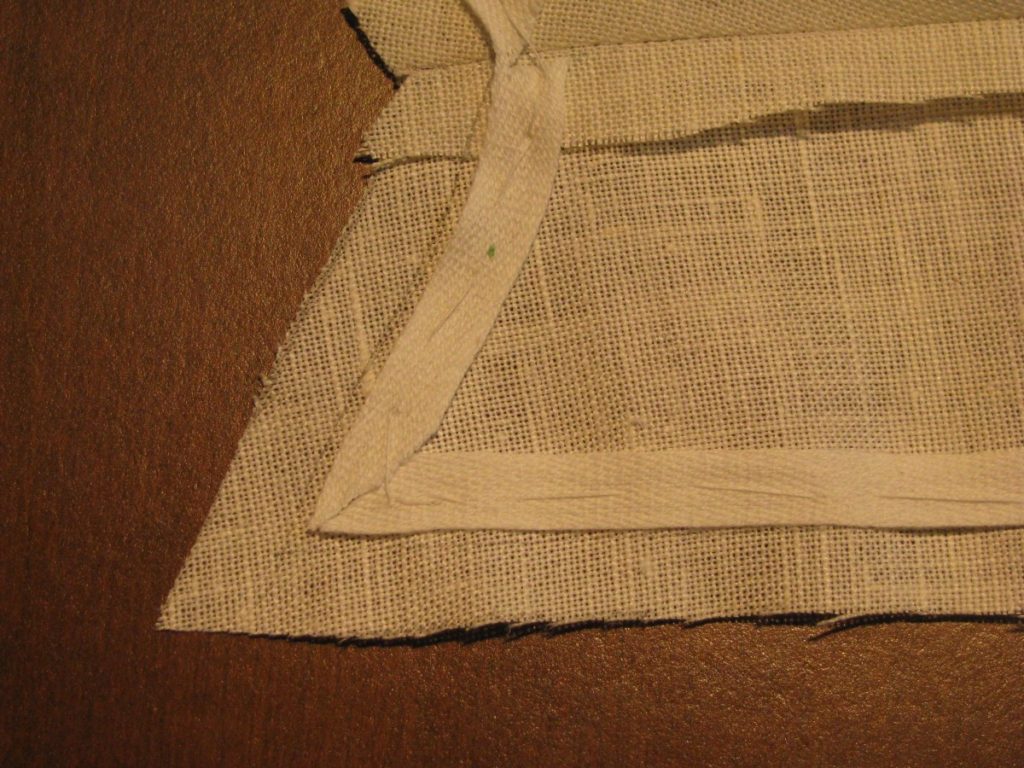
At the top of the lapel dart, trim the tape nearly all the way through, and place the remaining tape into position. The end of the stay tape should extend 1/2″ beyond the top of the roll line.
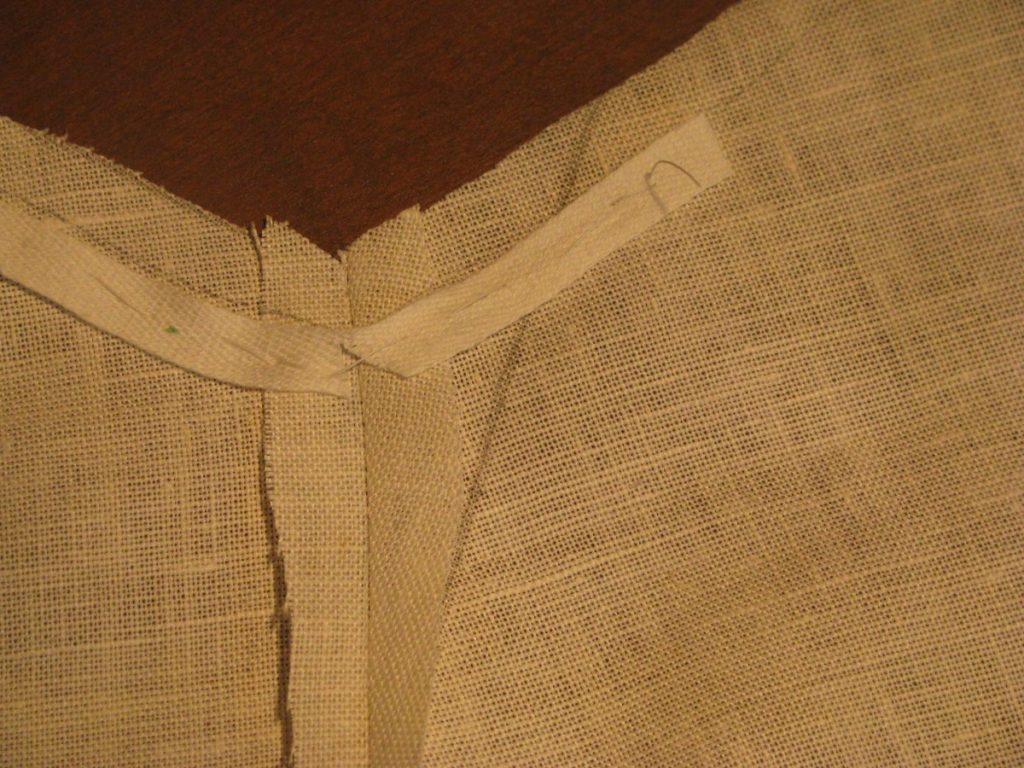
Fell down the stay tape along both edges, catching just a thread or two of the right side of the fabric. The stitches are about 3/8″ apart. The following photos show the stitching, as well as the placement of the stay tape on top of the button stay.

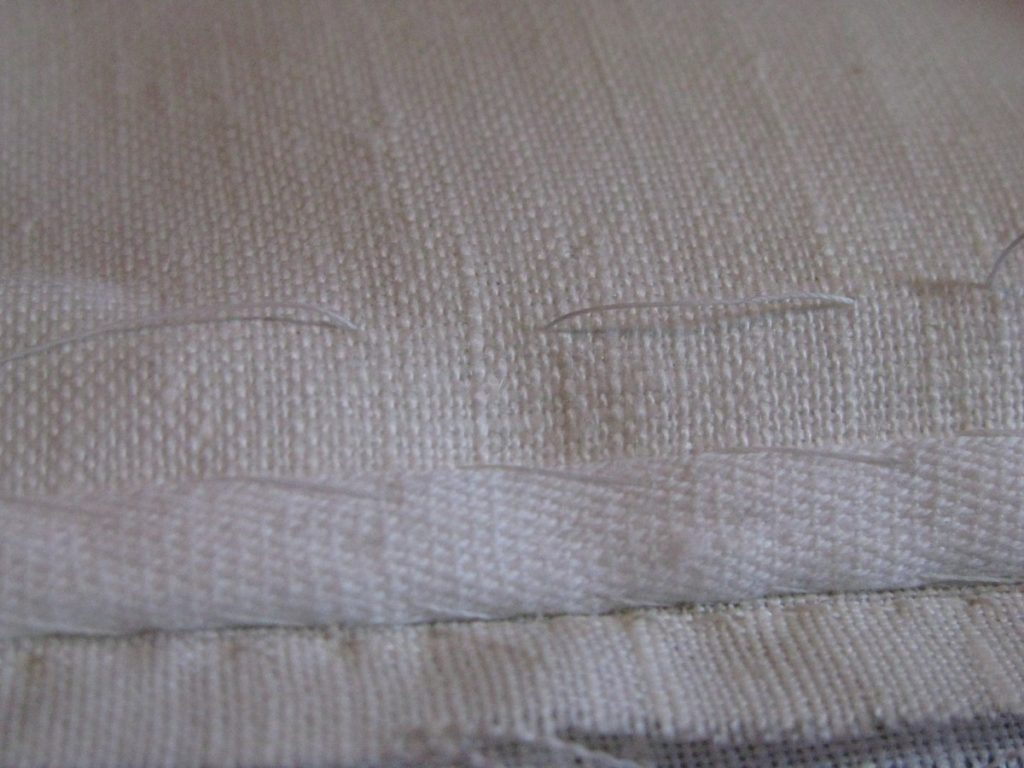
Button Stay
The top of the lapel dart is a weak point, especially during construction of the facing, so it should be reinforced with a couple of stitches in place, right at the seam allowance.

The stitches should ideally go through just the seam allowance of the dart, and be hidden in the crease underneath, but if they do show through it is not a major problem. That edge will be hidden from view under the lapels anyway.
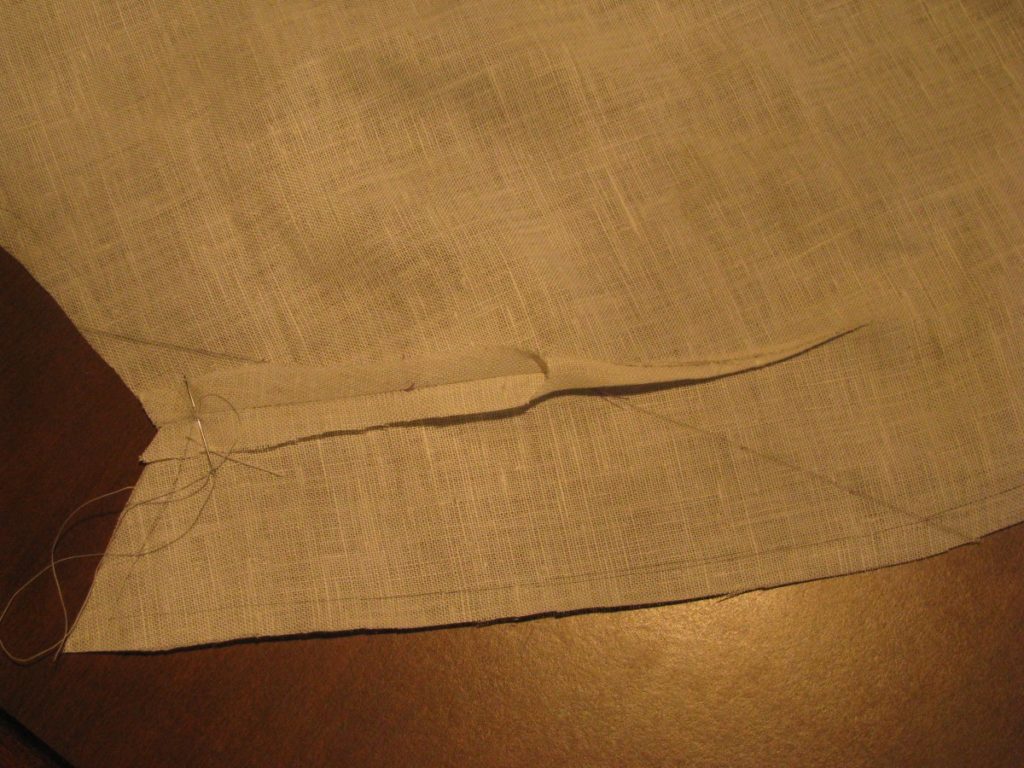
The Button Stay
Since we are using lightweight fabrics in this coat, it is very important to give some extra support to the area where the buttons will be attached. If this is left out, the buttons will eventually tear holes in the fabric.
Cut a piece of linen the about an inch longer than the distance between the waist and the bottom of the lapel, by about 5 to 6″ in width. Press the linen in half lengthwise. If you are using an extra fine linen, you could make the linen piece wider and triple the thickness of the stay. In either case, the final width should be about 2 – 3 inches.
Lay the button stay on the inside, on the right half of the coat. The bottom of the stay should be about 1/4″ above the waist just to reduce bulk in the area. At the top, trim the stay back from the roll line by about 1/4″. As you can see in the photo, I should have trimmed mine a little further away from the roll line where it meets the edge of the coat. The button stay should be just behind the seam line you drew previously. Baste it down along both edges.
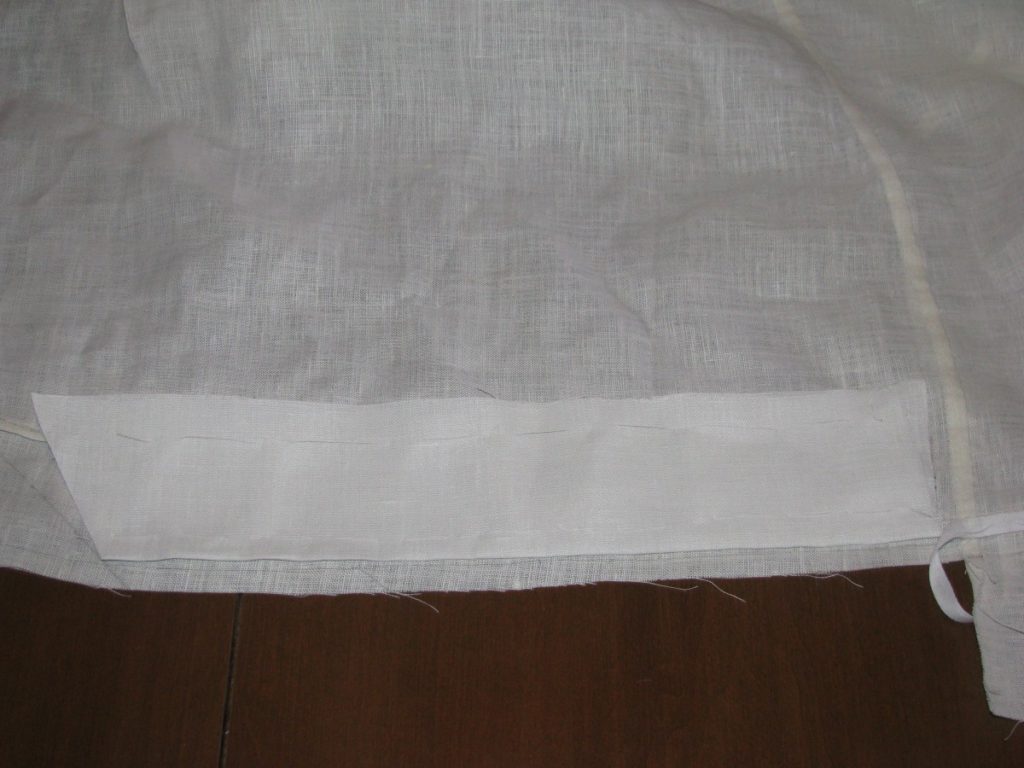
The folded edge should be towards the outside of the coat.
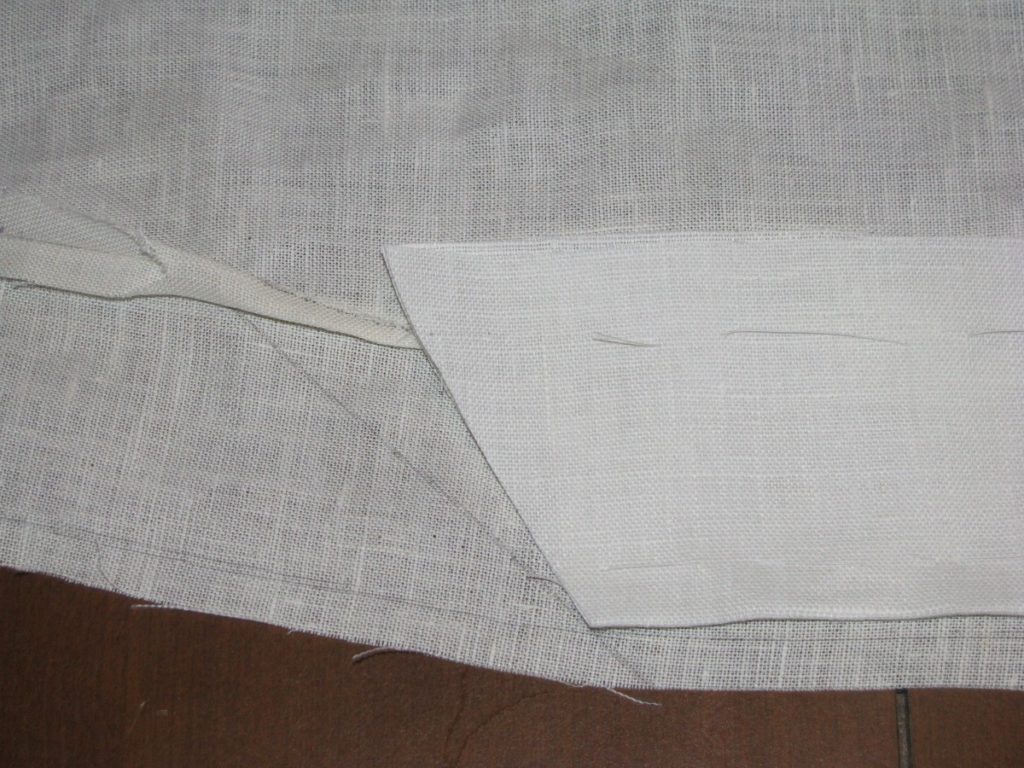
Along the inside edge of the stay, cross stitch the raw edge to the forepart of the coat. These stitches can be seen outside, so try to catch only a thread or two of the forepart with each stitch.
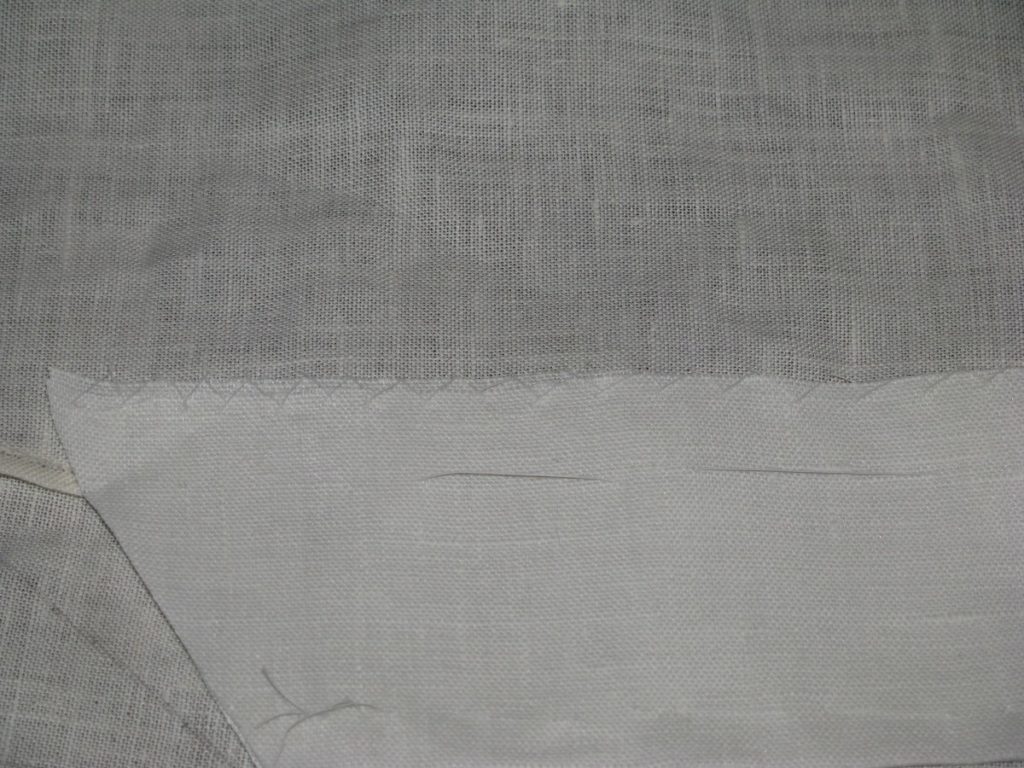
You can repeat the process on the other half of the coat, this time only using a single layer (or two if it’s a fine fabric) of linen, to form the buttonhole stay.
Optional Fitting and Seam Lines
Before we start the facings, it is a good idea to once more do a quick fitting, by merely sewing the shoulder and center back seams together, and of course putting the stay tape on the armscyes and around the neck. The purpose of this fitting is to check that the center front of the coat closes properly. The center should meet at the waist with a 1/4″ seam allowance, extending up to the roll line in a similar manner.
Pin the center front closed to be able to get a better view.
If above the roll line, you notice an excess of fabric, you may wish to put in a gorge dart, as shown in the drafting tutorial. This will not only take away some of the excess, but also enable the lapel to roll more gracefully and to stay in place. I highly recommend taking a photo of this fitting and posting it on the forum, so I can better help you determine if this gorge dart is necessary.
Marking the Seam Allowances
On a woolen frock coat, there would be a canvas inserted into the chest area which would give us the exact seam allowance, but seeing as we have no canvas, the seam allowance must be marked on the coat.
First trim off any inlays that you did not need along the neck and center front, if you had them.
Then mark the seam allowance (in my case, I used 1/4″), starting at the top of the neck, down towards the lapels . . .
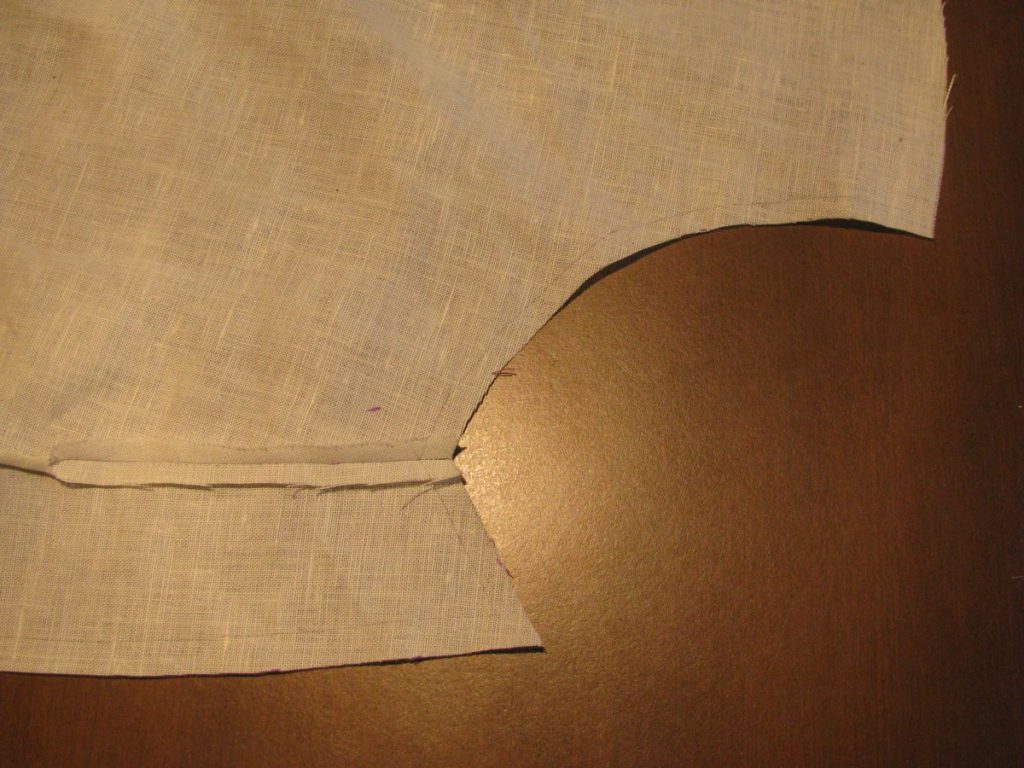
and along the front of the coat.
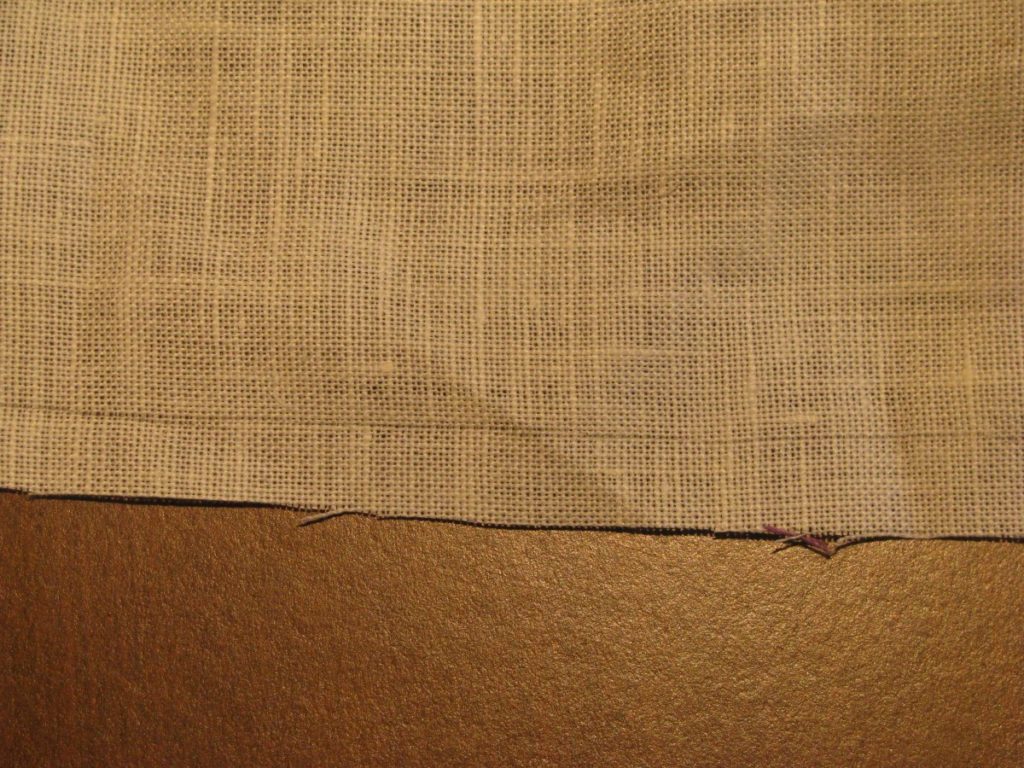
Stop at the waist line.
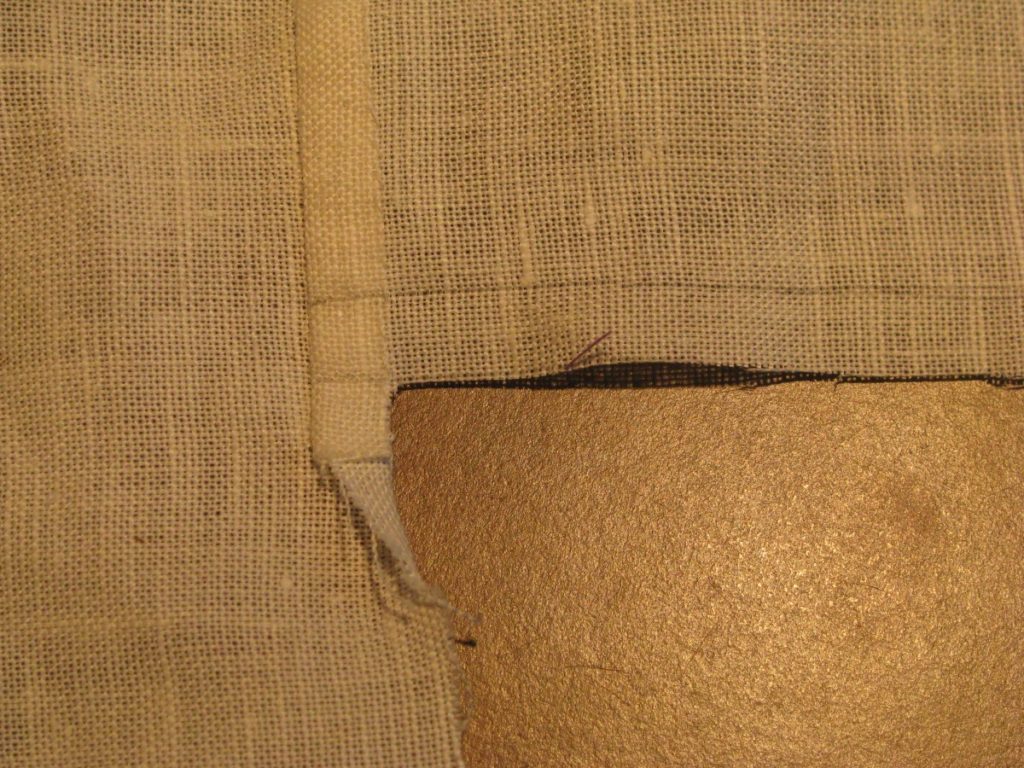
Continue the line down the front of the skirt, remaining parallel to the front edge.
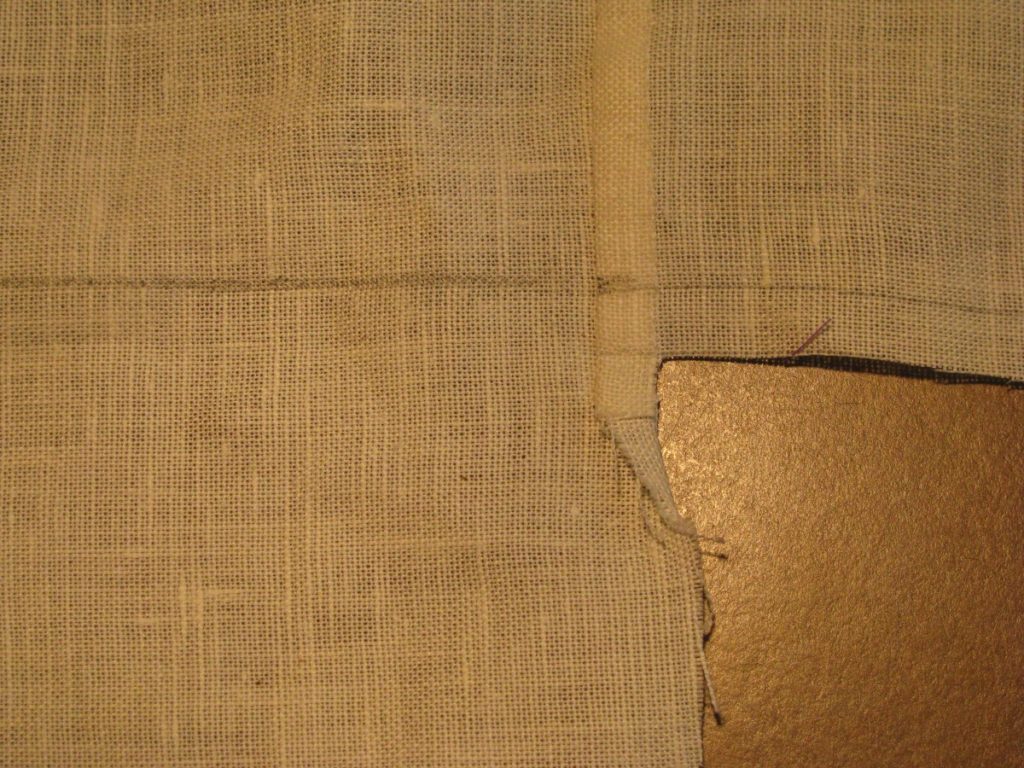
The line should be the same distance from the edge at the top and bottom of the skirt – then you know you are parallel.
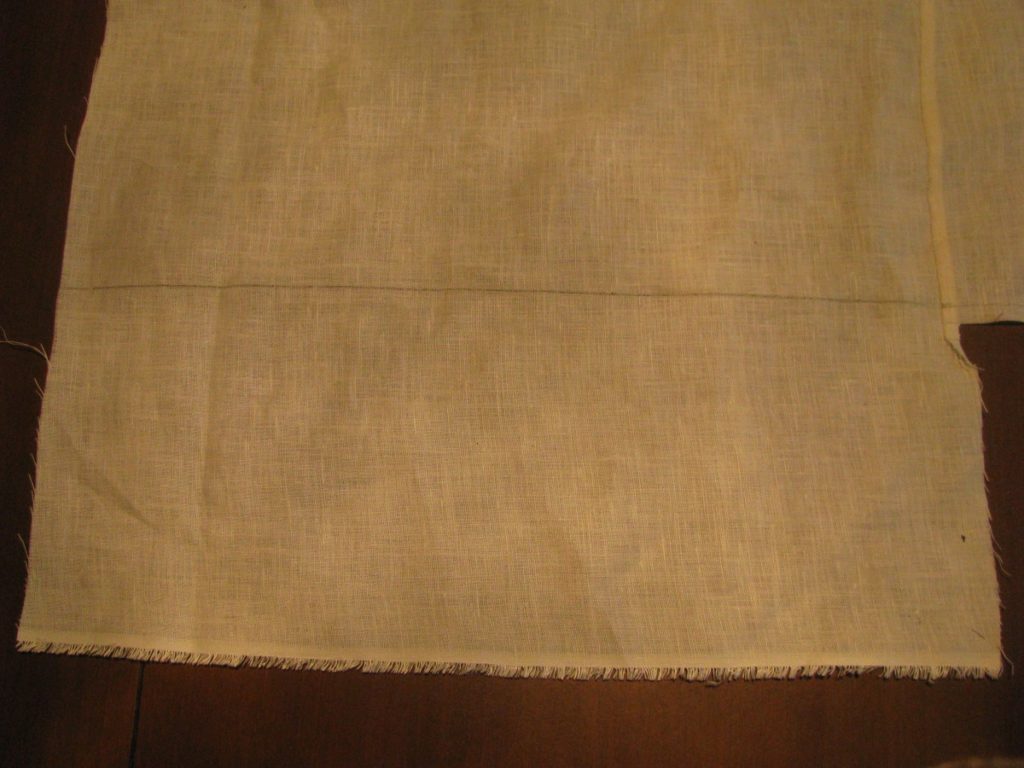
Draw another line parallel to the edge, about 2 1/2″ from the edge. This is variable, and is equal to the final width of the skirt facing plus an allowance to turn under the raw edge.
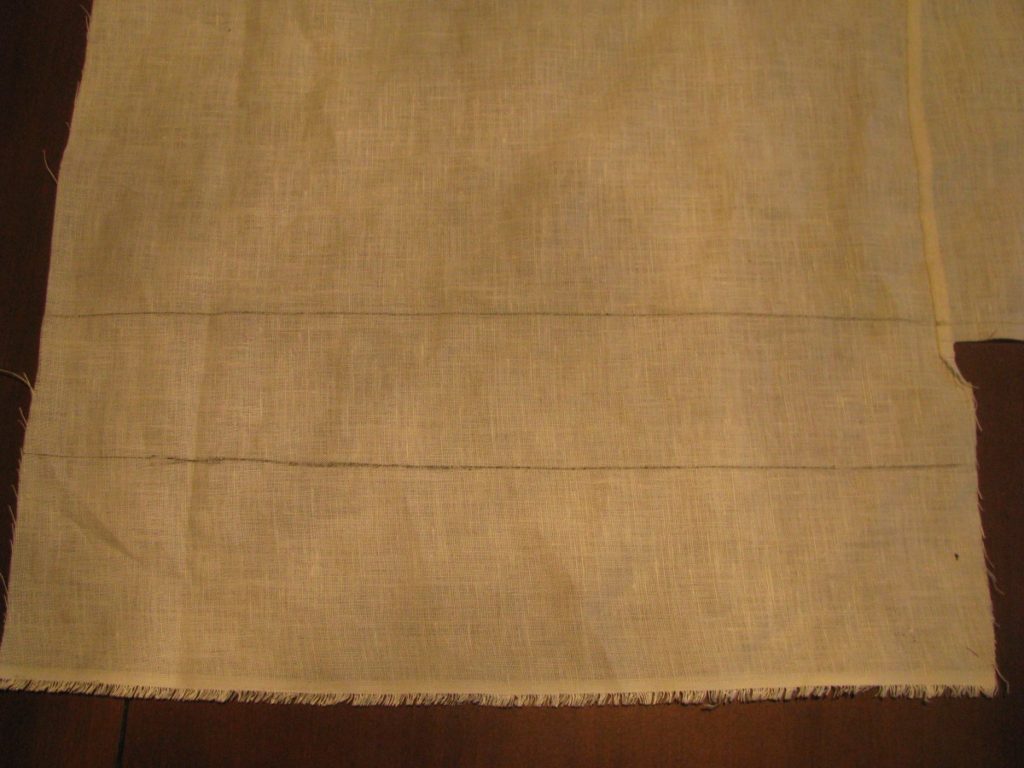
Trim off the excess fabric along this second line.
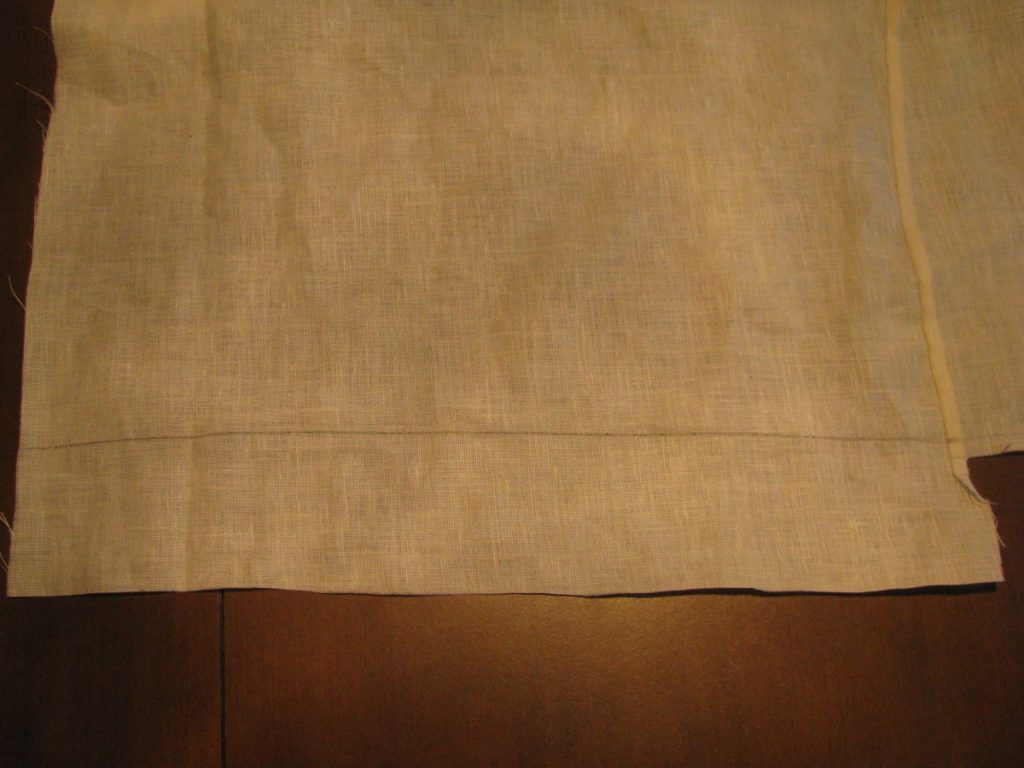
The Back Seam
Trim the seam allowance of the side body to 1/4″, starting at the armscye.

Stop just above the waist seam, and avoid trimming through any of the stitches.
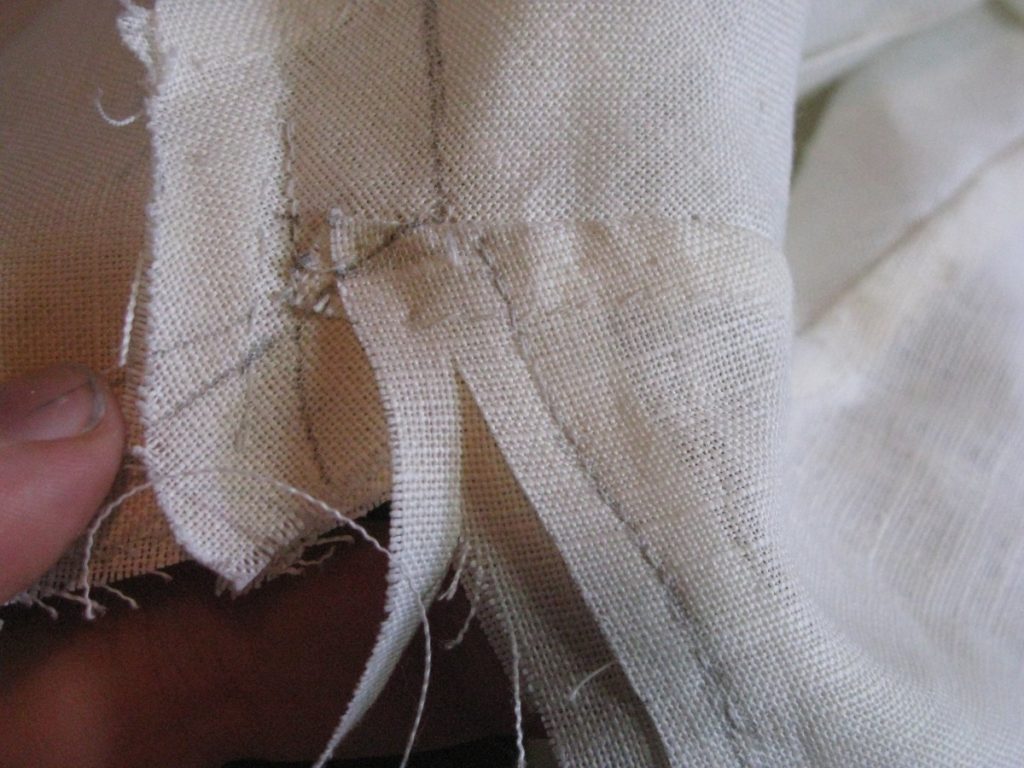
Trim off the excess at a slight angle, as shown.
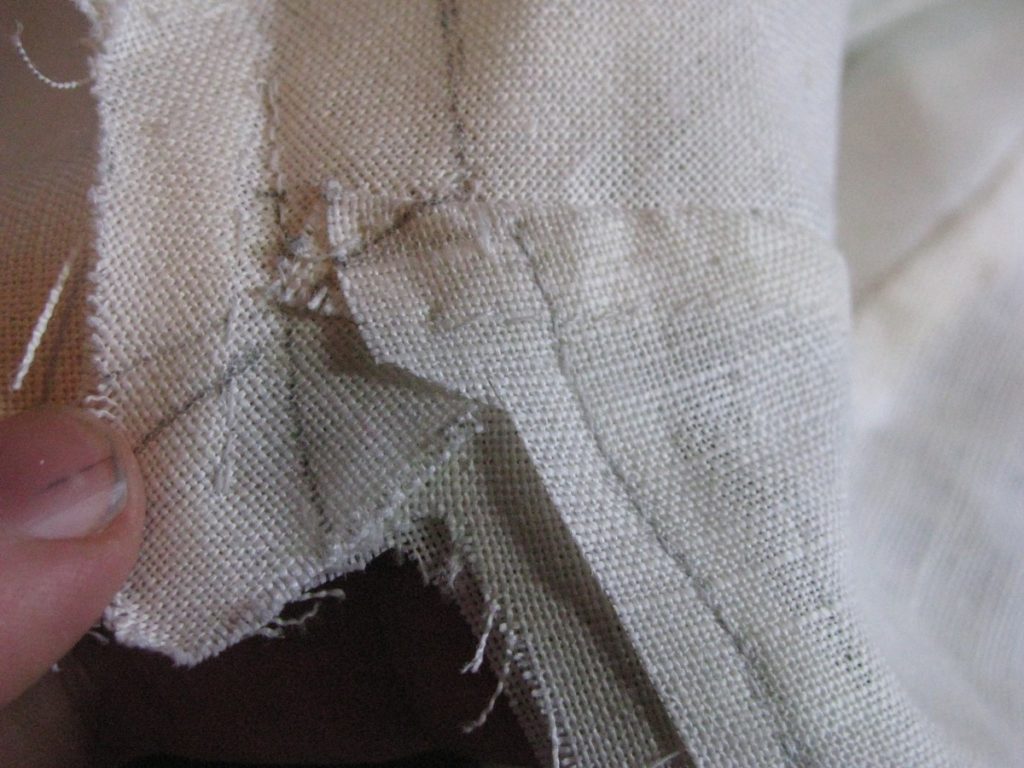
Press the seam back towards the side body.
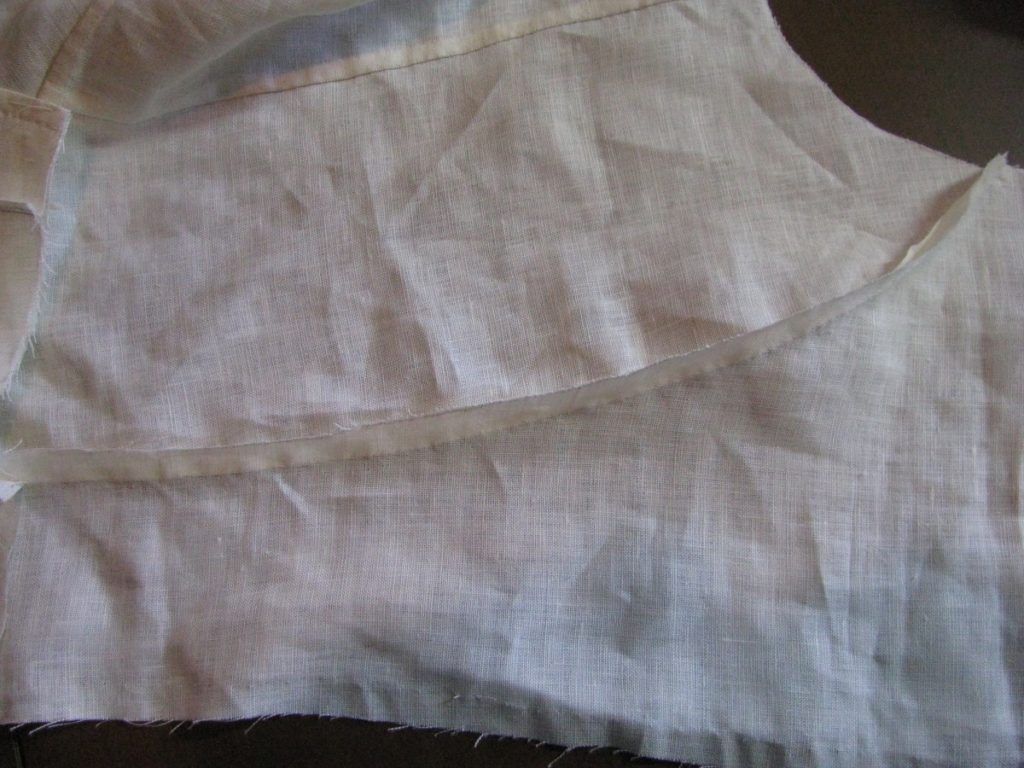
You’ll be folding this seam over to finish it, and if you take a look at the top of the pleat area, you’ll notice that you won’t be able to fold this area under.
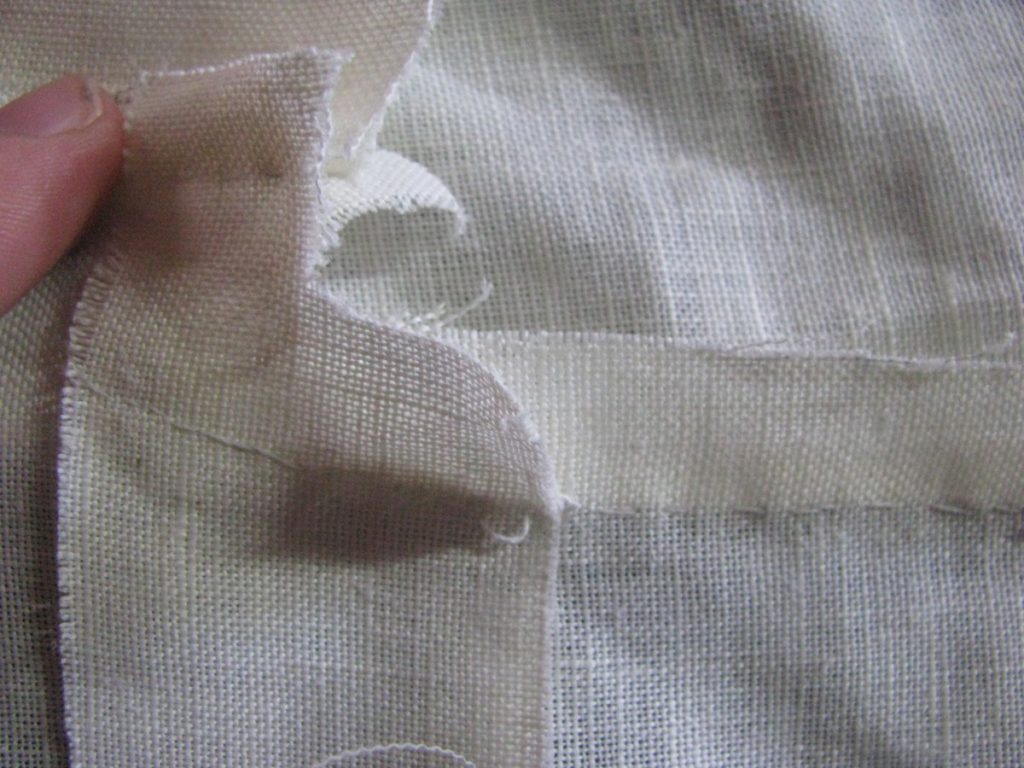
To free up the seam allowance and allow it to be folded, snip the seam allowance of the back piece and the linen stay at the inner corner of the pleat. The cut should be only 1/4″ in length.
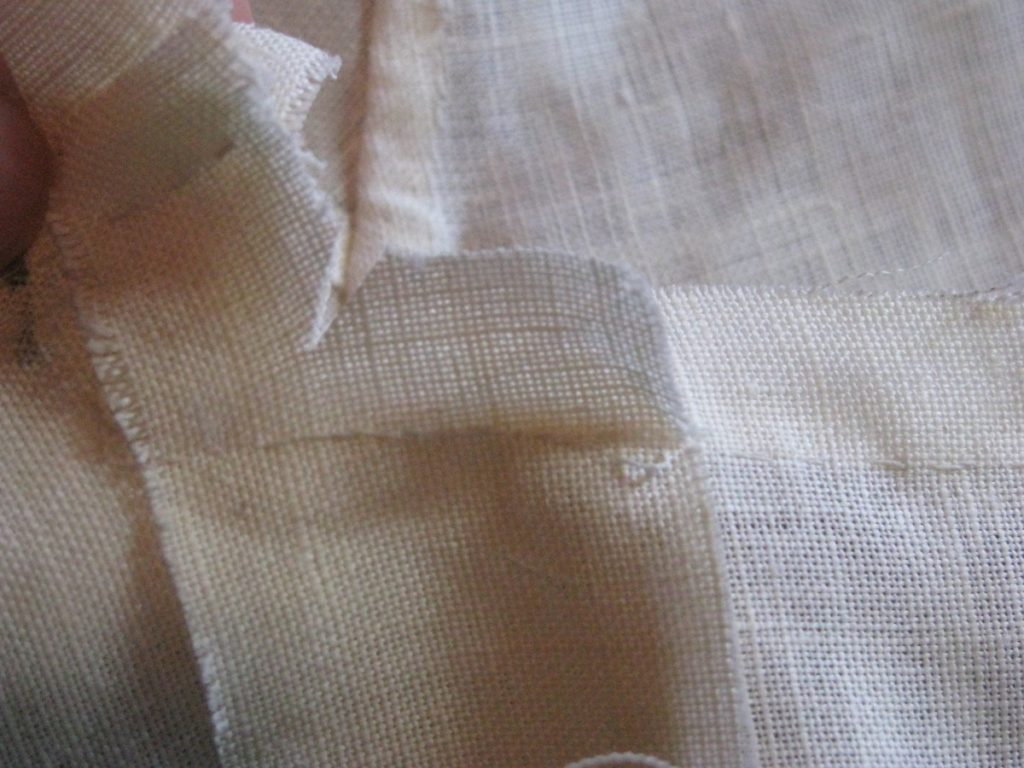
Now fold over the rest of this seam allowance up to the cut, baste, and fell closed. When felling, have the needle enter the seam perpendicularly, catching only a couple of threads of the outer fabric.
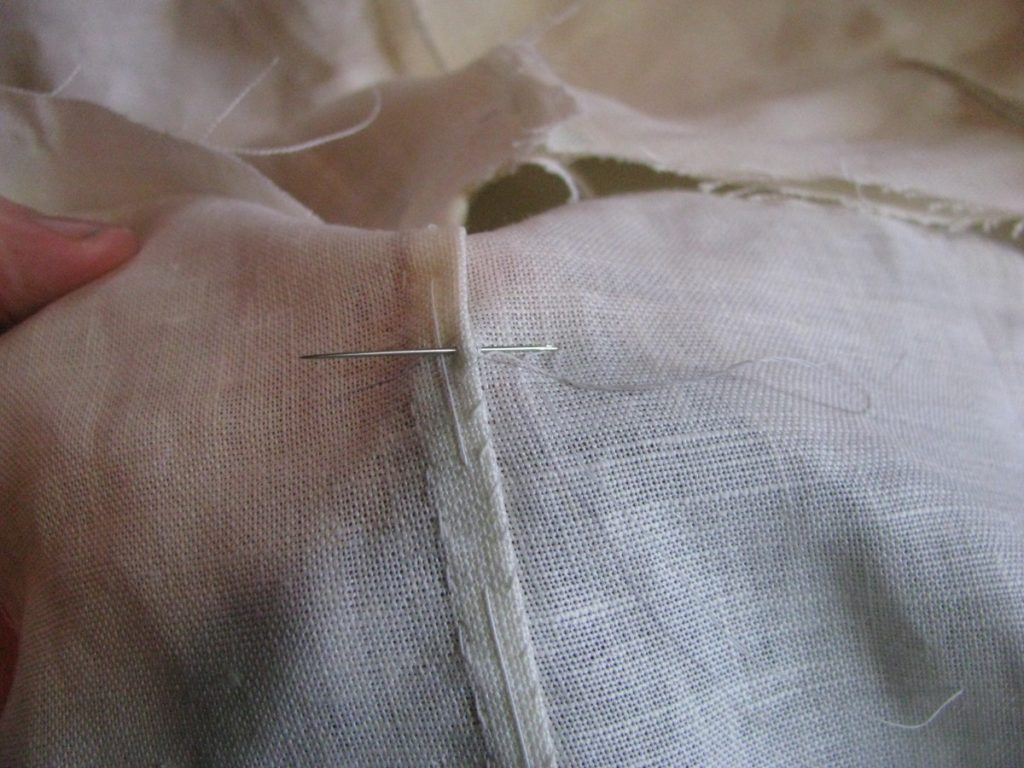
Here’s what the completed seam in that area will look like. Don’t worry, all of that ugliness at the waist will be covered up by a facing eventually.
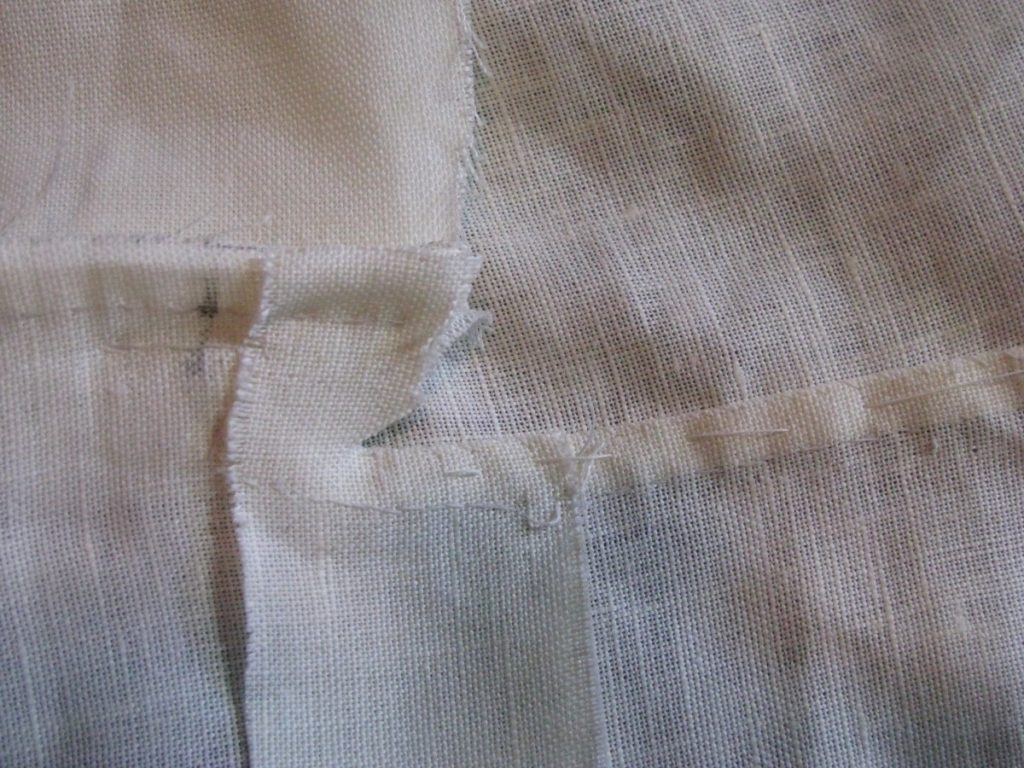
Now it’s time to finish up the lower skirt area. On the right side of the pocket (the back side), fold under the 1/2″ seam allowance along the length of the pocket. Baste this closed and fell, being sure only to catch the top half of the pocket underneath. You don’t want to end up sewing your pocket closed! Below the pocket opening, fell through all layers to give extra strength to this area.
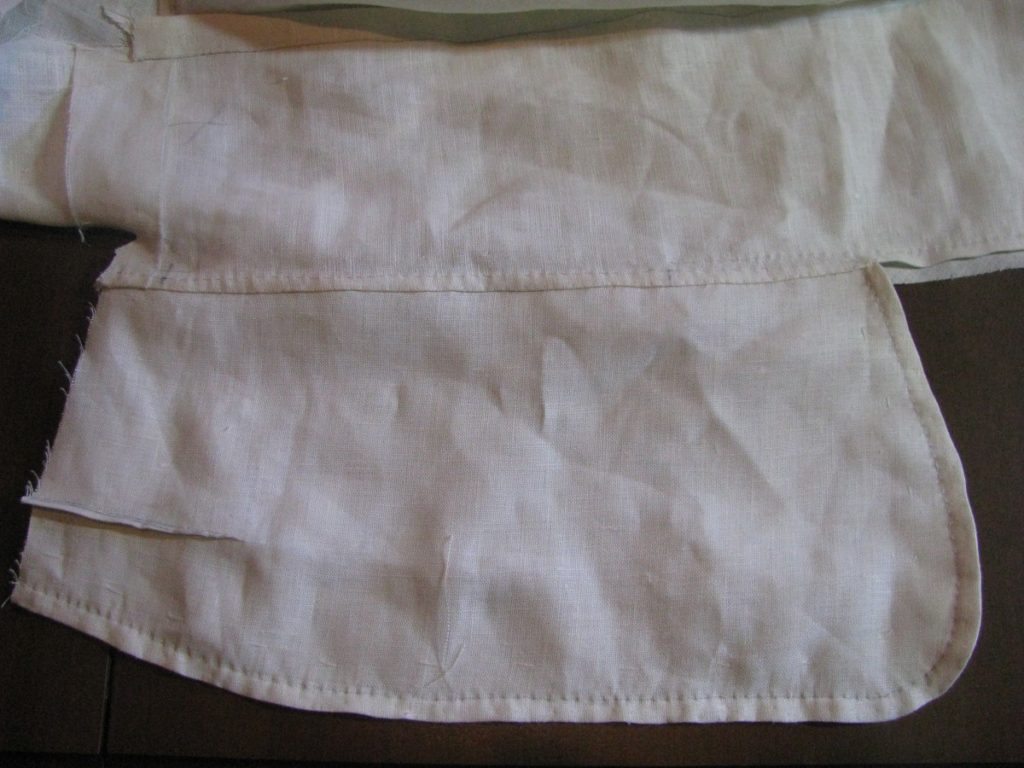
The felling goes from the top of the pocket . . .
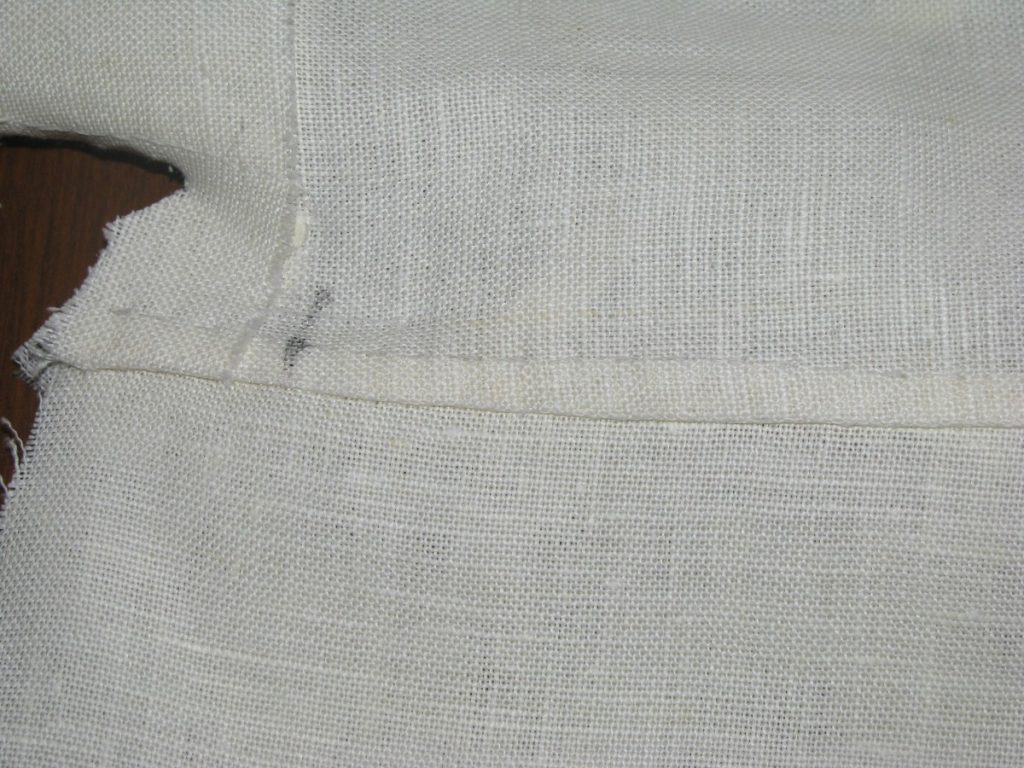
To the bottom of the pocket. Don’t sew any further, just continue folding the back seam allowance under.
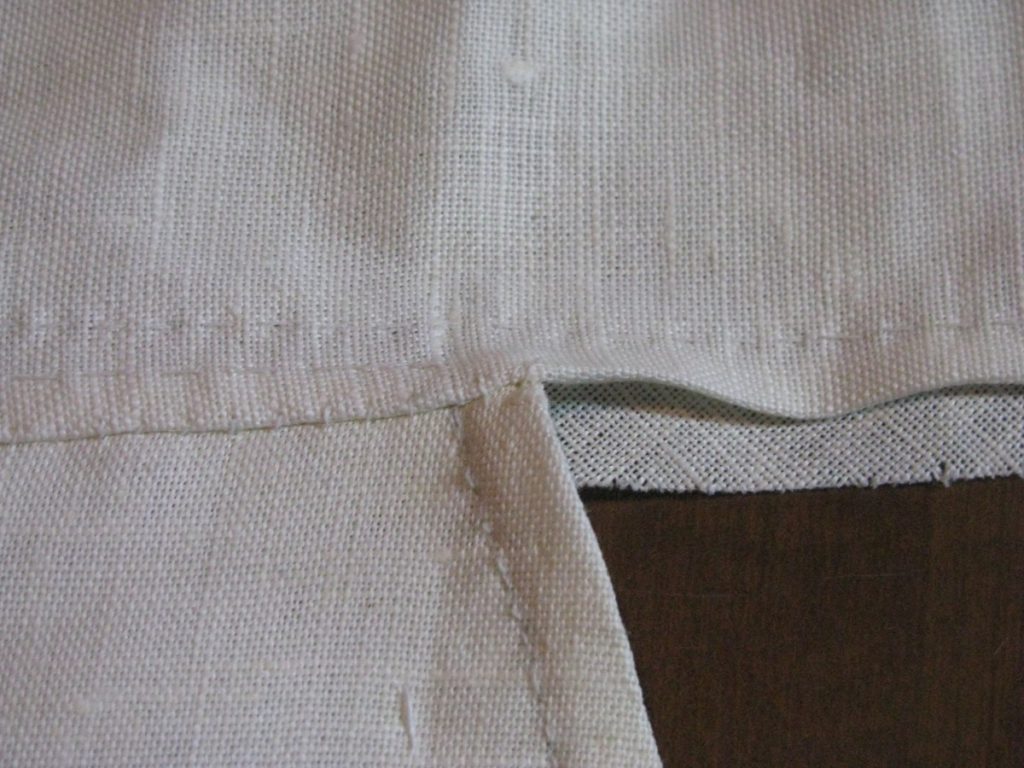
Here’s the rest of the back seam allowance, folded under and pressed with the fingernail.
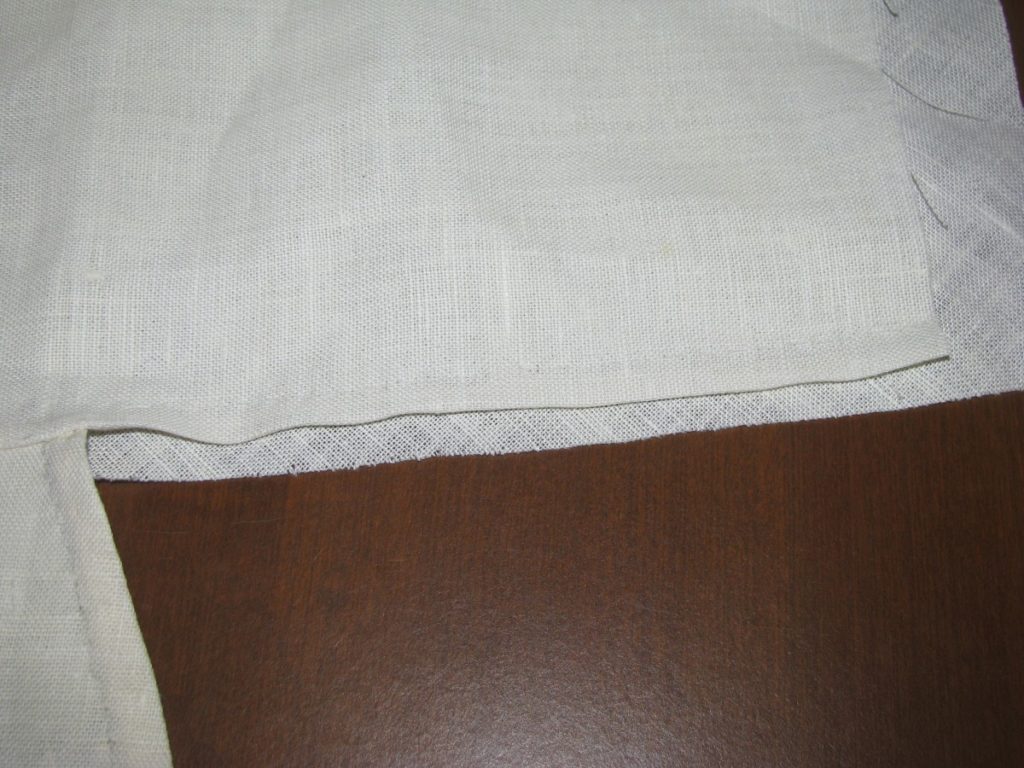
Turn to the wrong side, or skirt side of the pocket, and fold the other half of the seam allowance under, allowing the top seam to extend by 1/16″ extra. Fell.
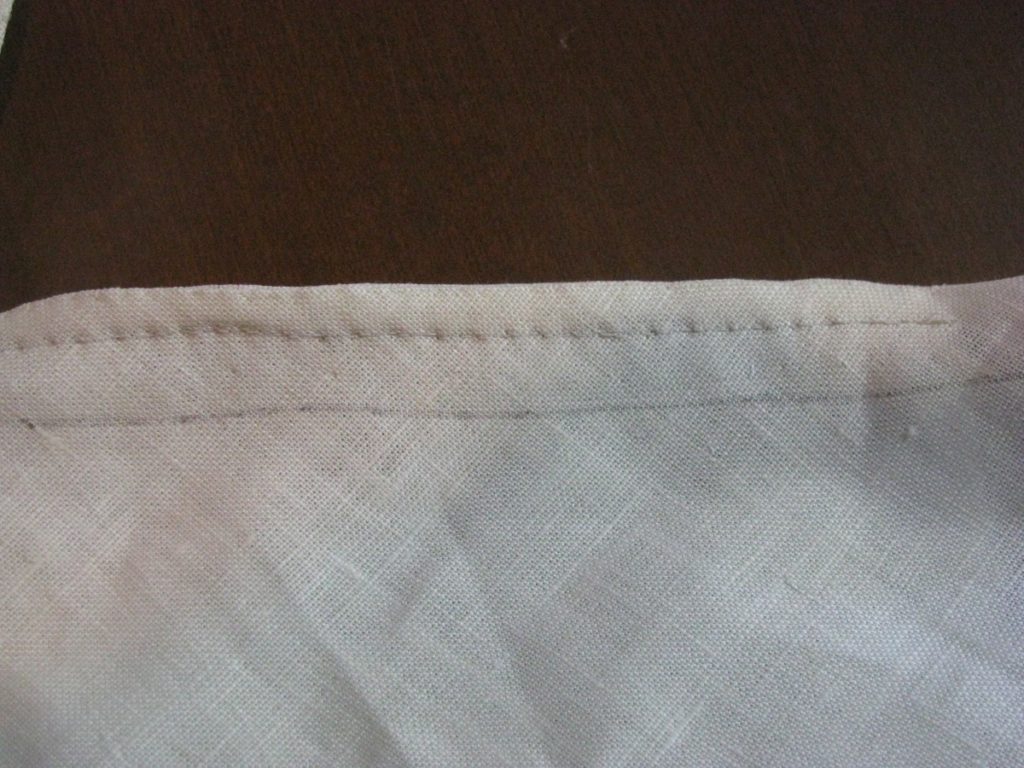
Continue folding and felling until you get to the bottom of the pocket opening. Up to this point, the stitching can go through multiple layers of the pocket, for extra strength – just don’t go all of the way through. Continue felling across the pocket opening, being sure not to close the pocket. I like to keep my hand inside as I’m doing this.
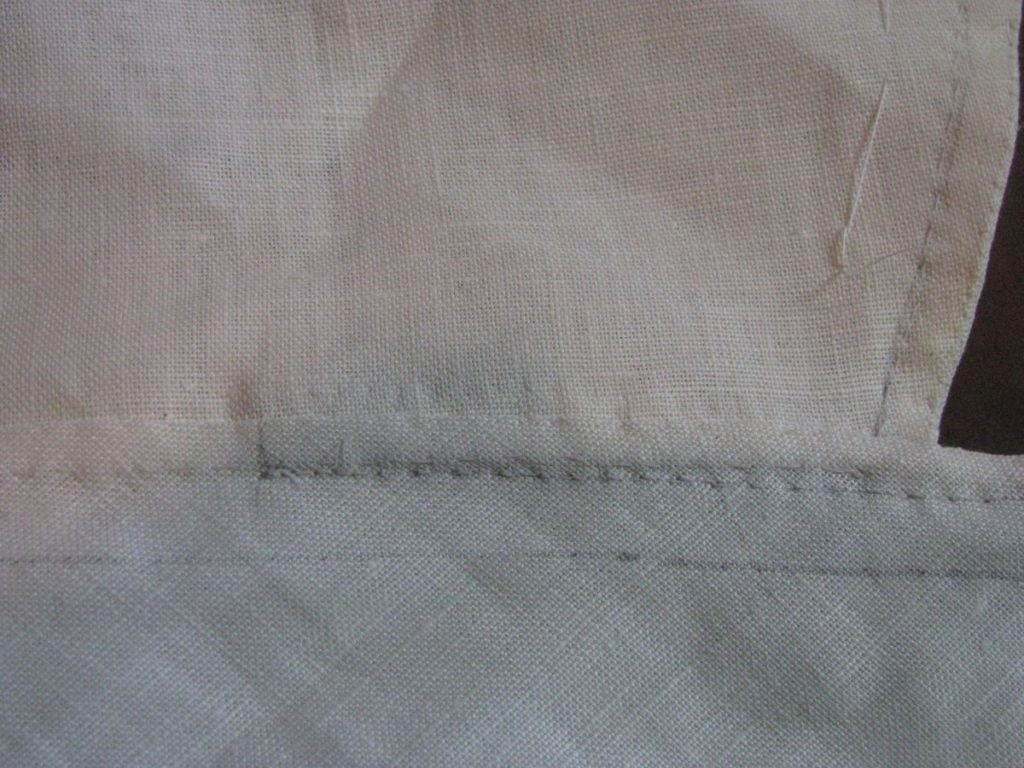
Keep felling all the way to the top of the pocket.
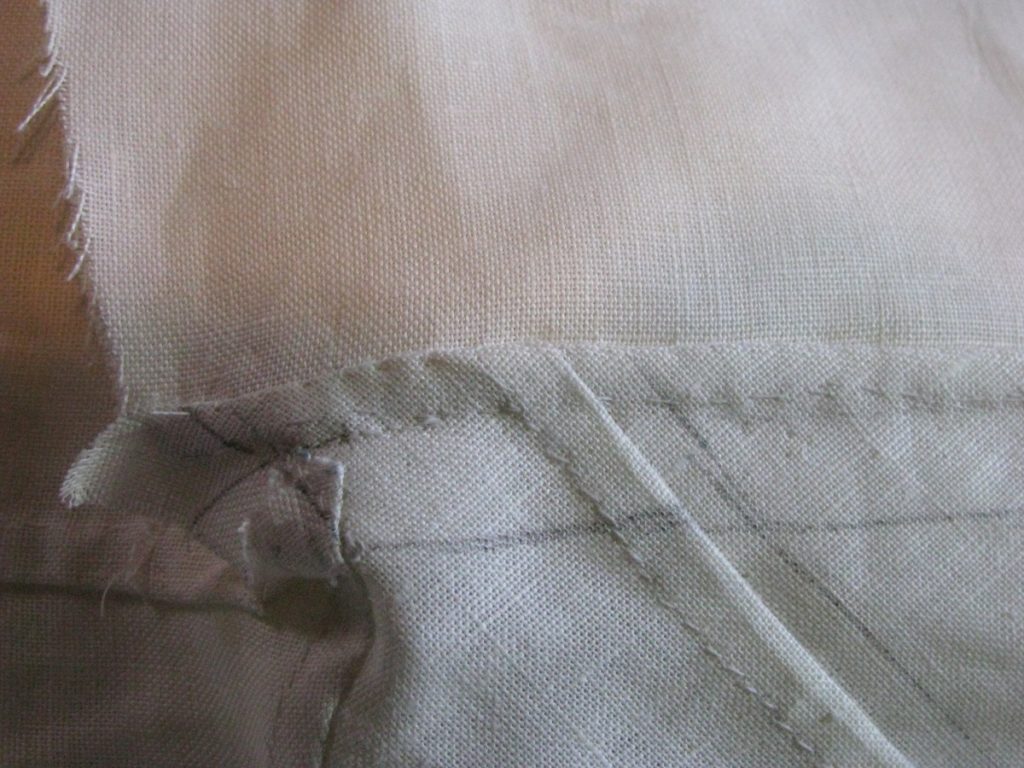
For extra security, it’s a very good idea to put in two stays, or rows of stitching, at the top and bottom of the pocket mouth. This will prevent the seams from tearing with repeated use of the pocket. Open up the coat so that the pocket is isolated to the side, and stitch through all layers.
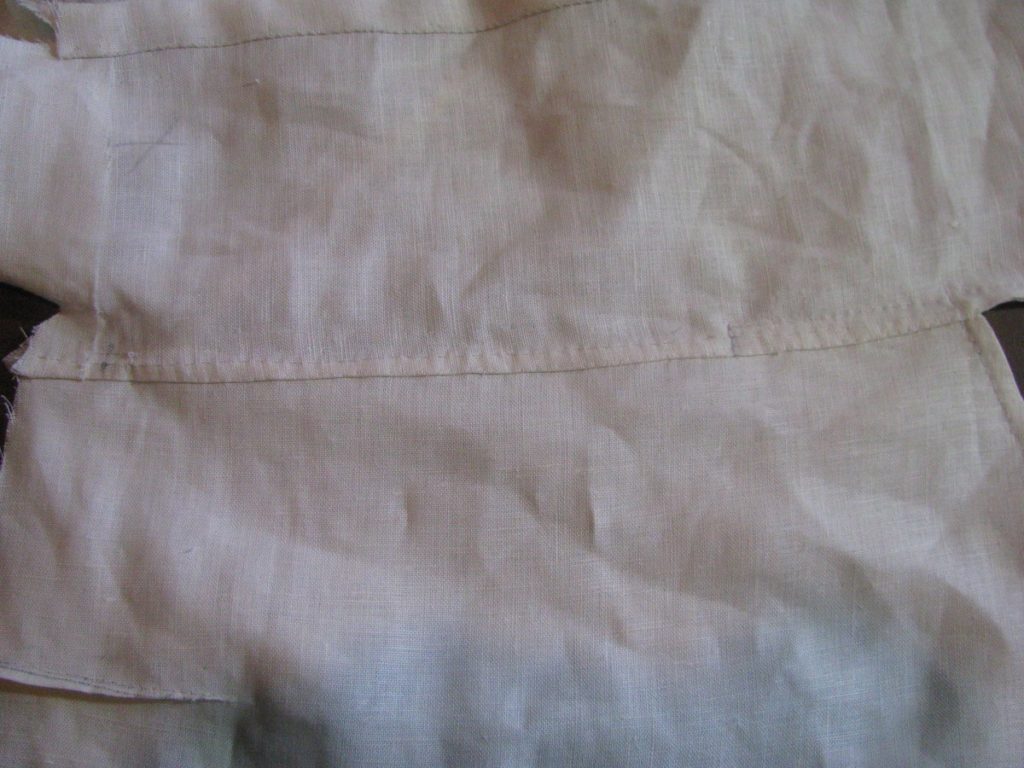
Here’s the first stay at the bottom of the pocket. I just stitched three or four rows of backstitching on top of each other, from the edge of the folded seam, to the edge of the stitching.
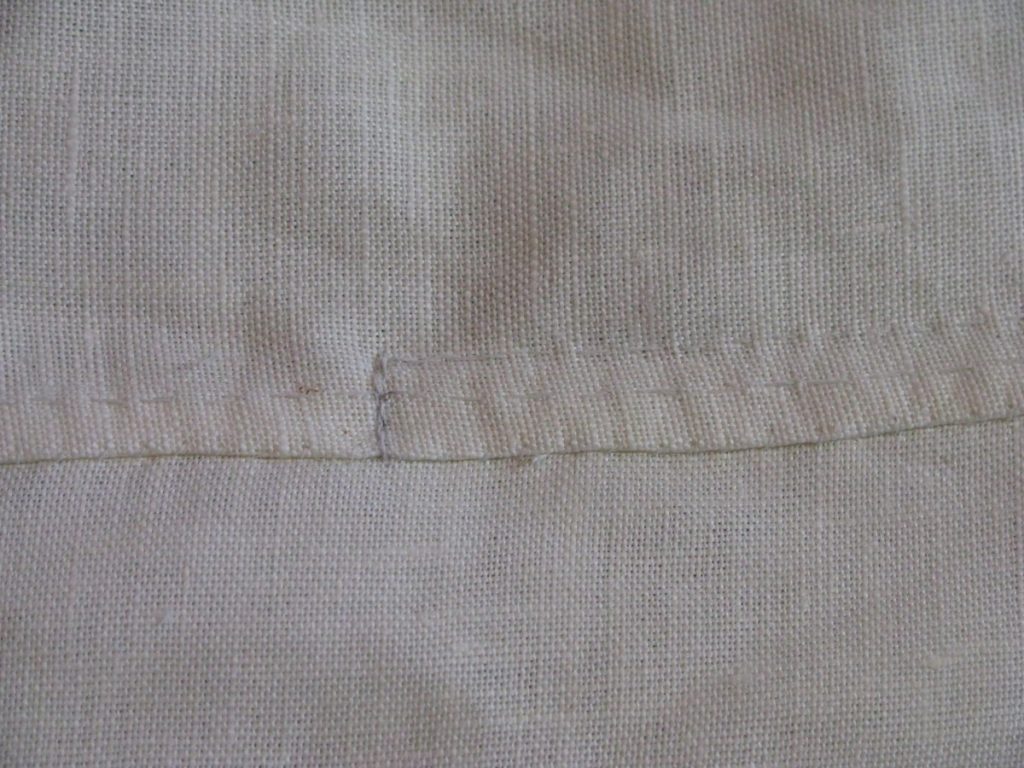
And repeat for the top of the pocket mouth.
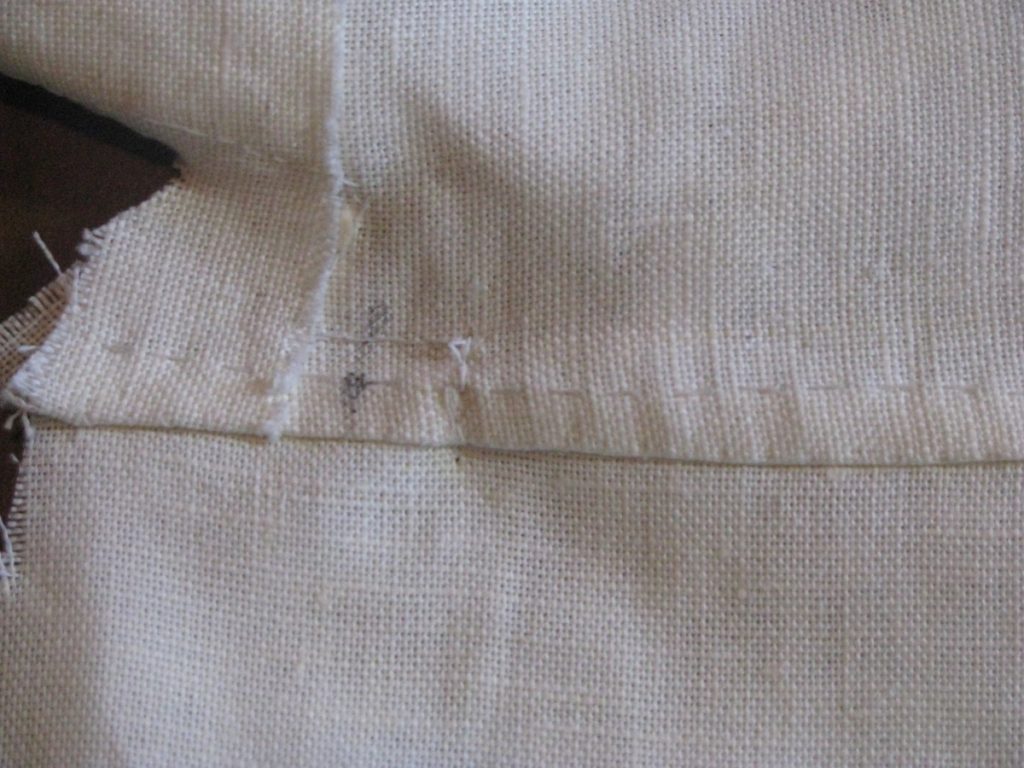
Now it’s time to secure the tops of the pockets. It’s important that the pockets hang in such a fashion so that they do not interfere with the drape of the coat. Adjust the position of the pockets, so that there is a bit of excess in the skirt below.
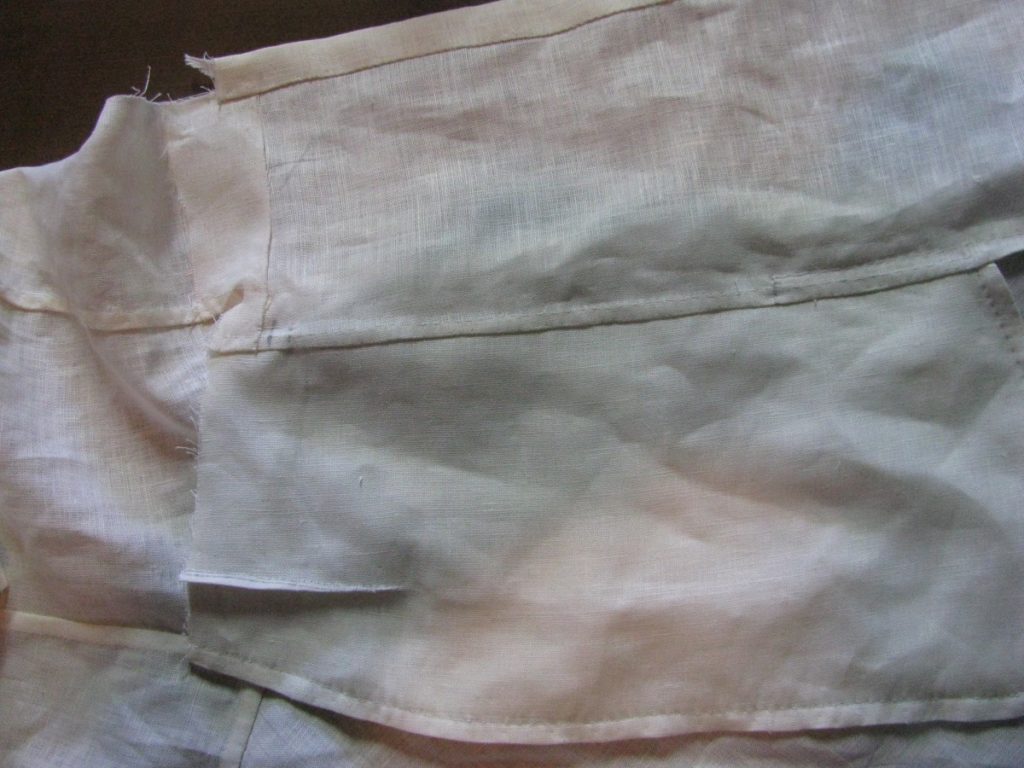
Baste in place, just below the waist seam. At this point you should hold up the coat and check that the drape is to your liking. If you notice any tension or pulls, pull out the basting and adjust as necessary.
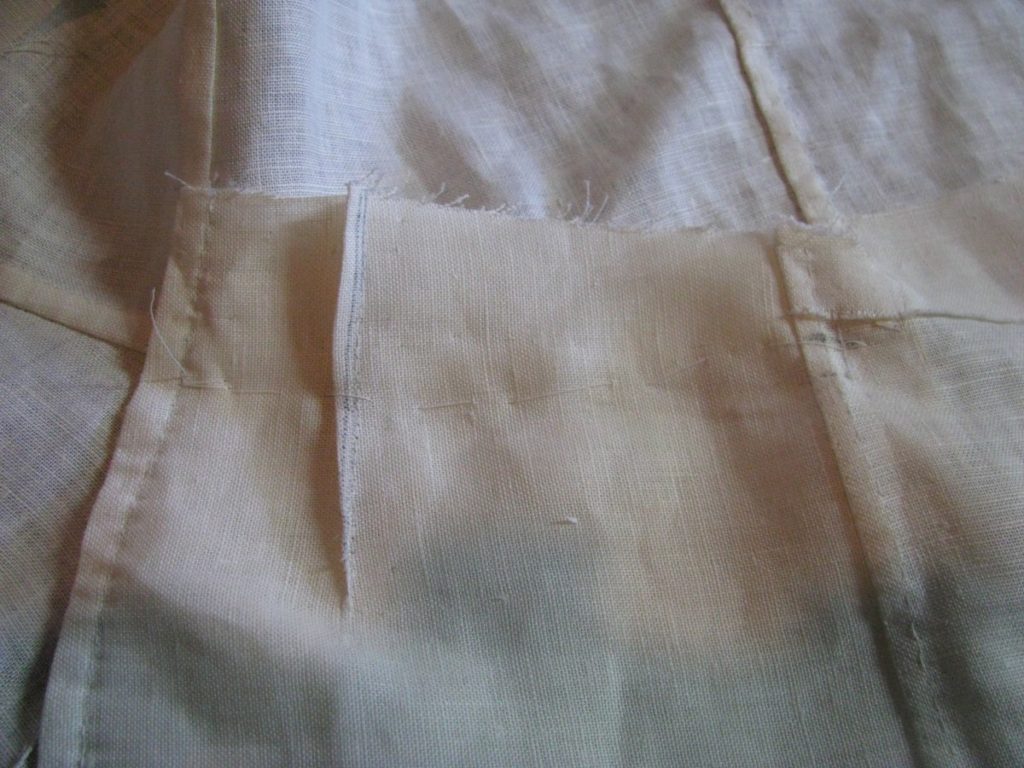
On the right side of the coat, be sure that the pocket is pulled back enough so that there is a sharp crease at the top of the pleats. There is a lot of fabric here so it is easy to have too much fabric here.

Once you are satisfied with everything, trim the top of the pocket to about 1/2″ above the waist seam. Careful, there is no turning back from here!
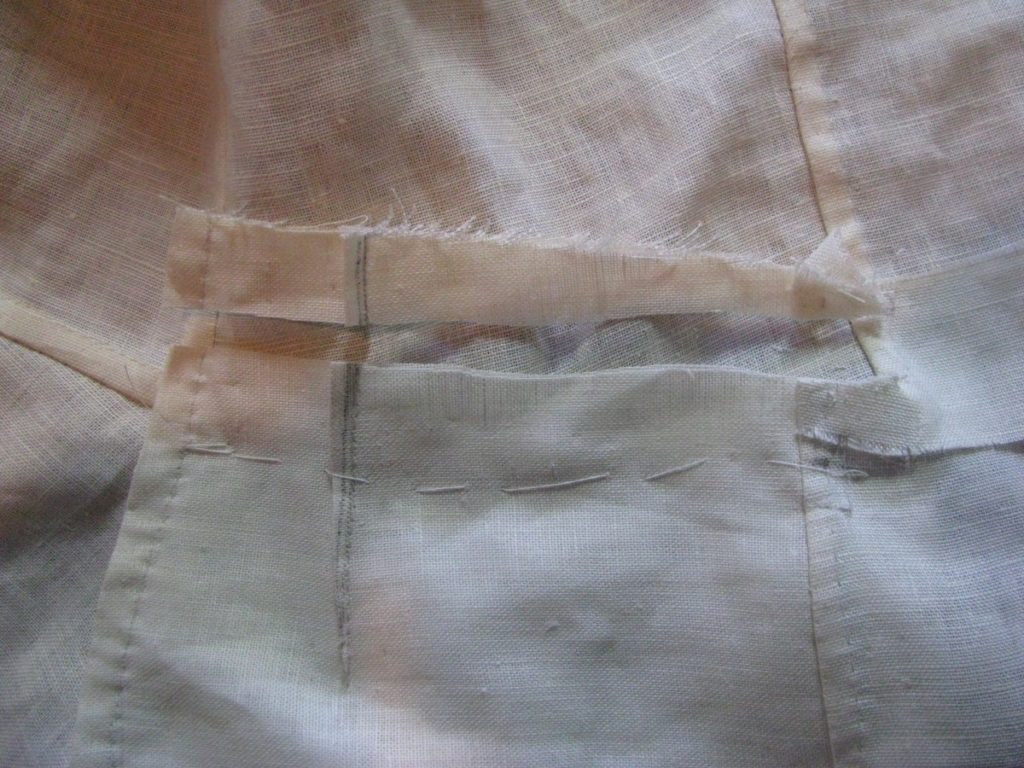
Cross stitch across the top of the pocket, being sure to catch only the seam below it. The stitching should follow the waist seam.
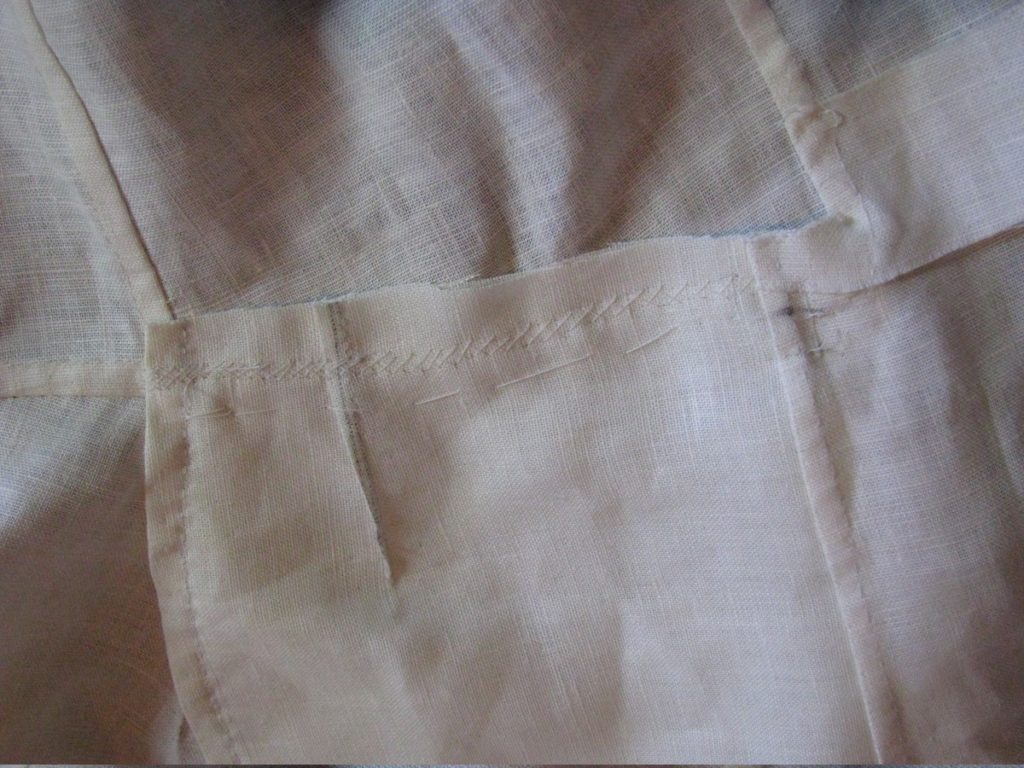
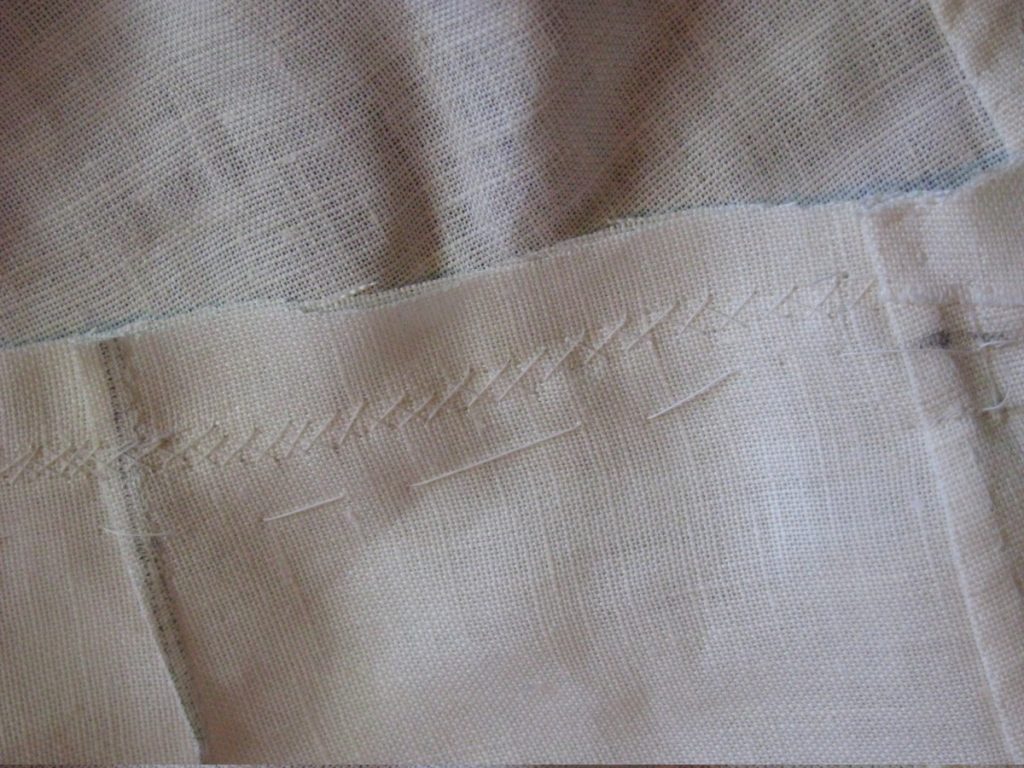
At the outer edge of the pocket, fell down the edge to the seam allowance, for a little extra security.
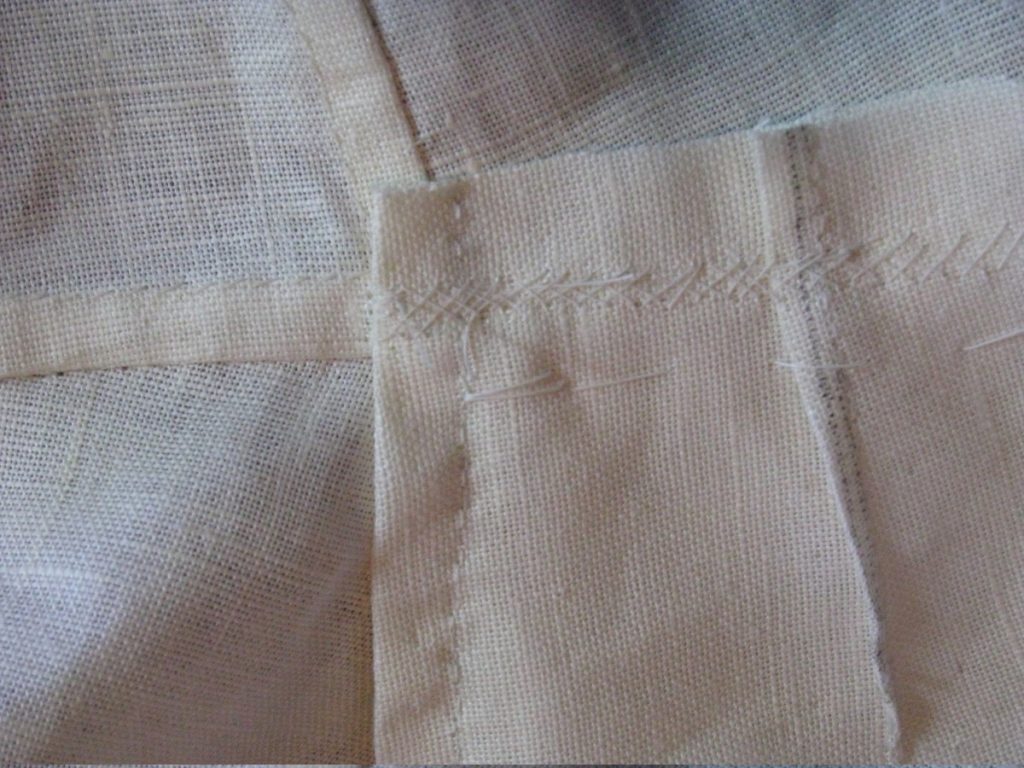
Finishing the Pockets
Now we’ll finish up the pockets and enclose the seams, as they will be visible on the finished coat.
Begin by basting the two halves of the pockets together.
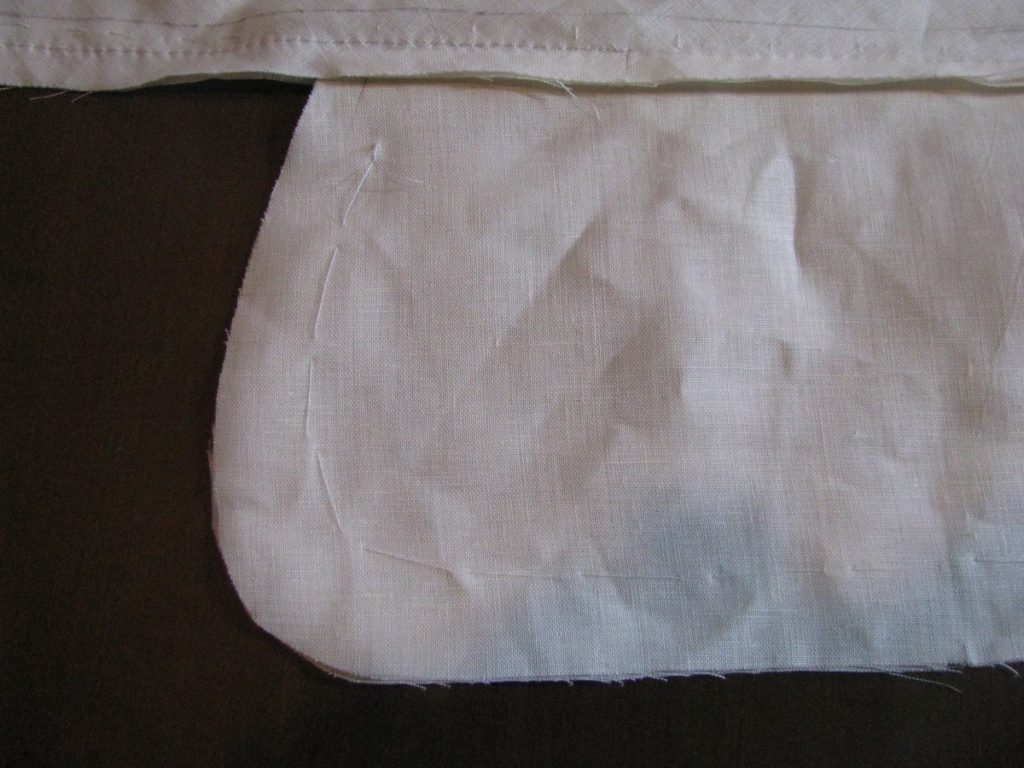
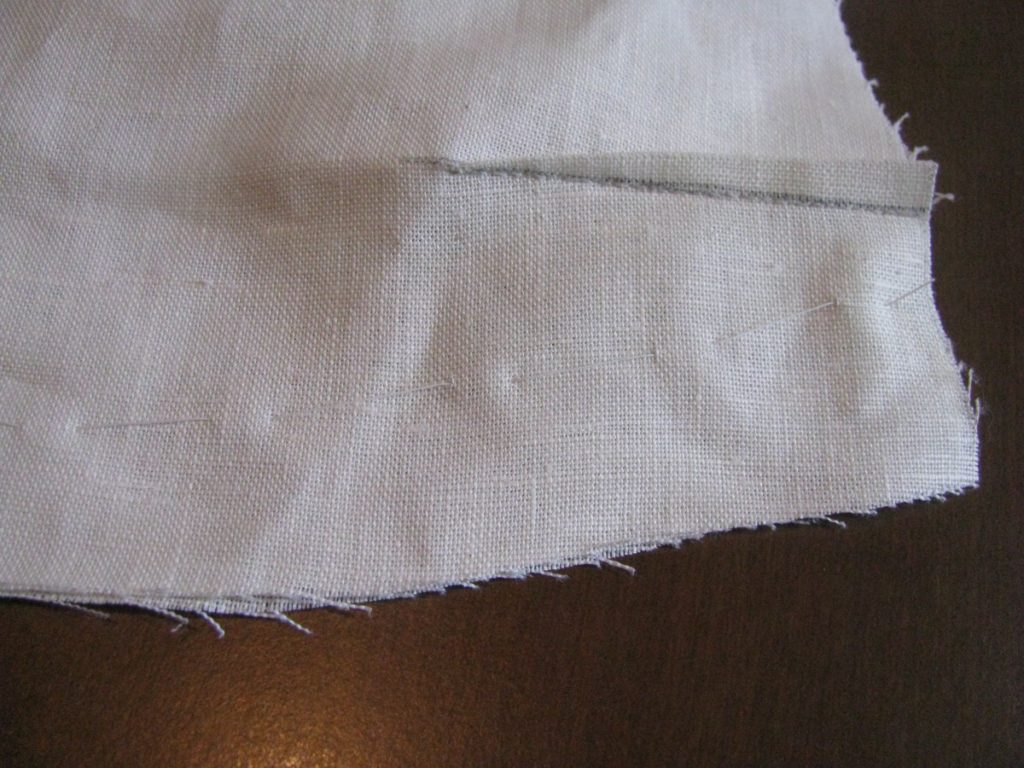
Sew the pockets closed around the outside edges, making sure that the ‘right’ side of the stitching is on the same side as the back of the coat body.
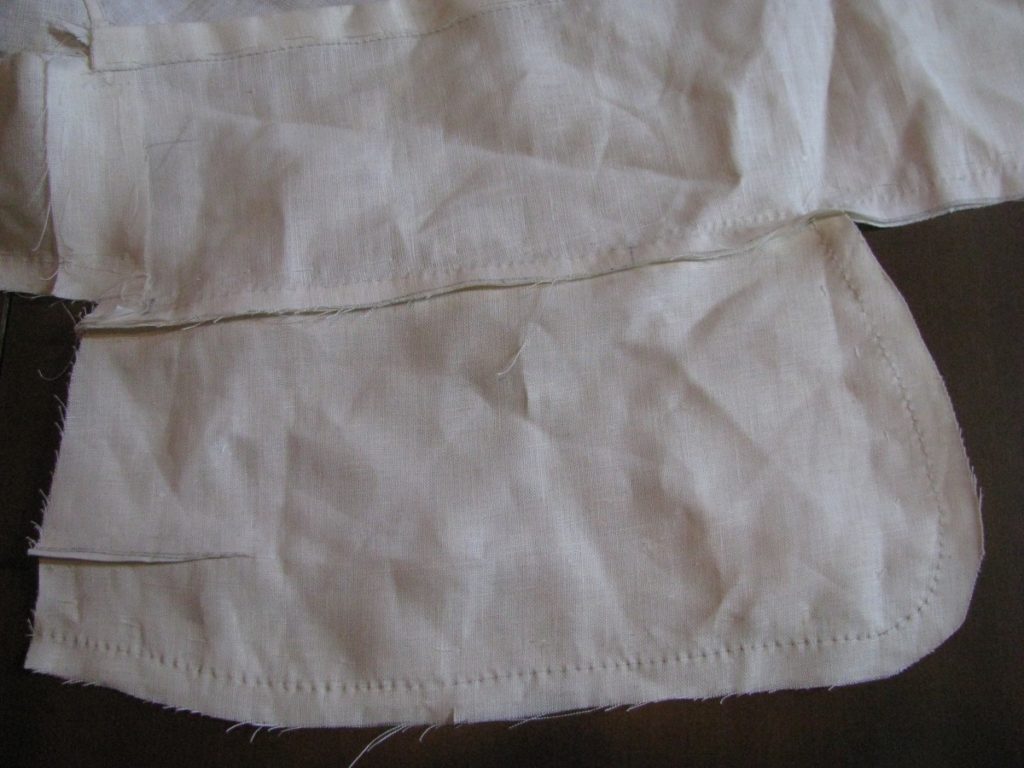
When you get to the bottom of the pocket, the stitching should meet the original line of stitching that attached each pocket half to the skirts. Avoid catching any of the seam allowances.
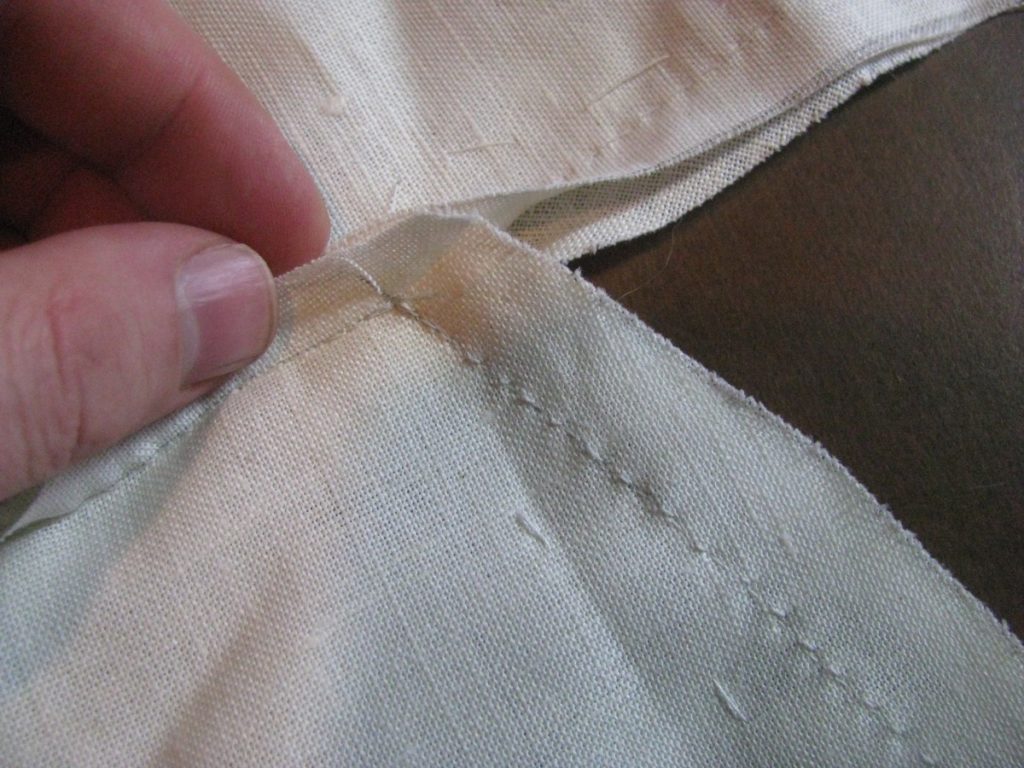
Now trim the seam allowances of both pocket halves to 1/4″. Make sure you are cutting the pockets, not the skirts!
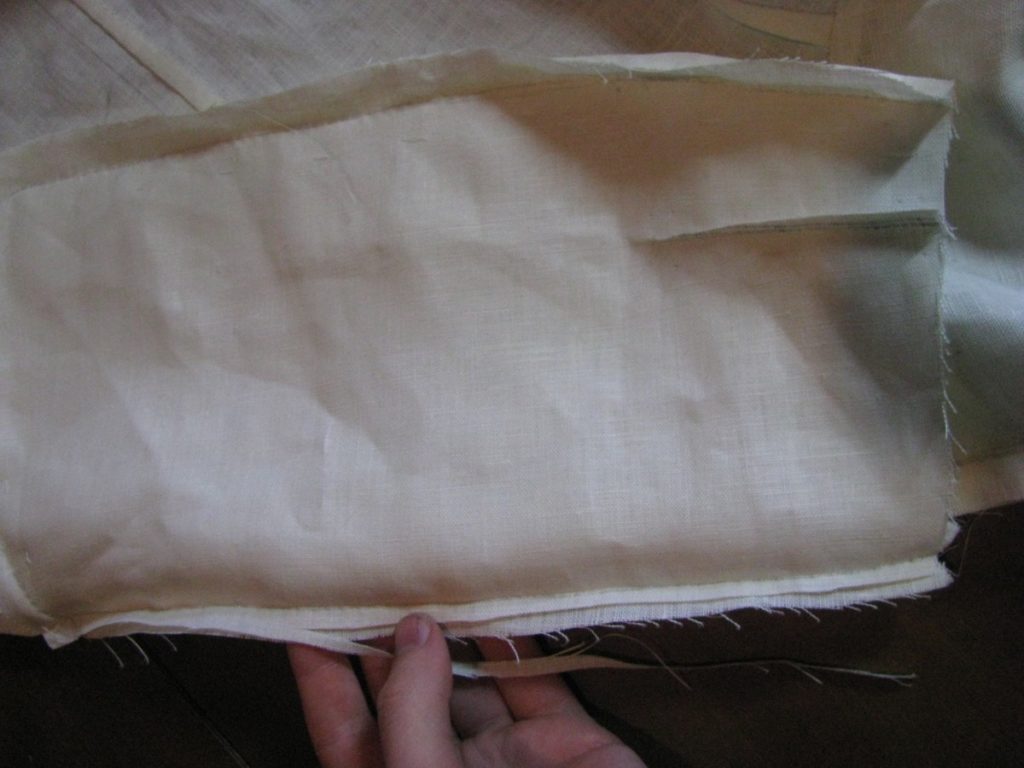
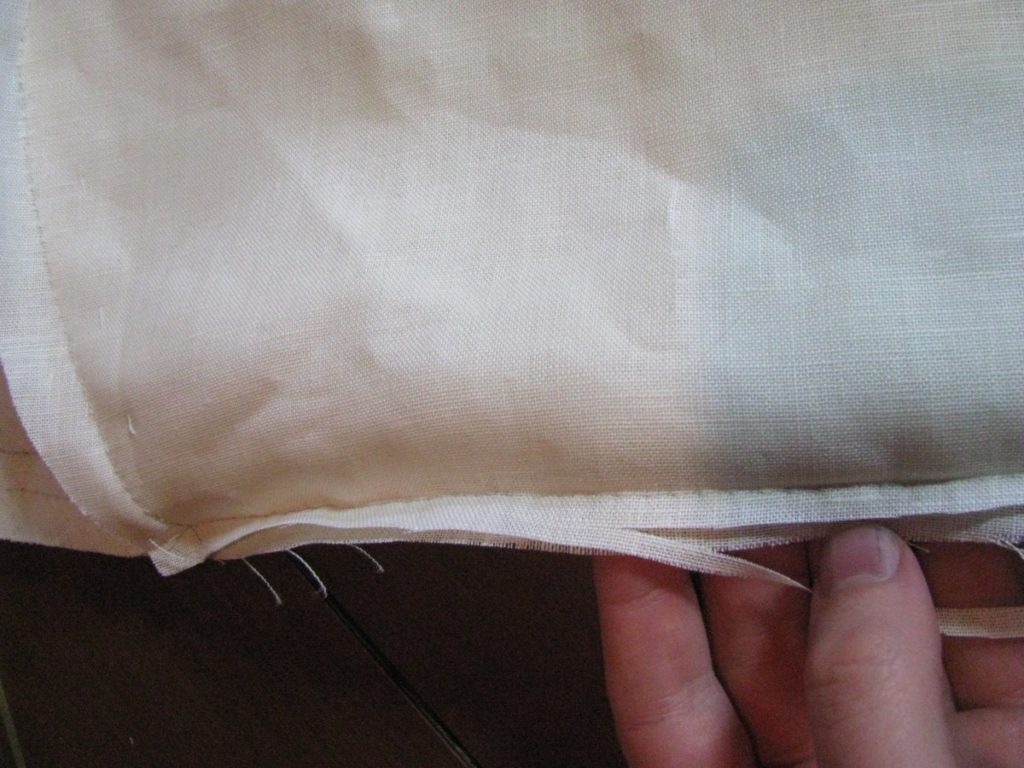
Working on the outer edge of the pockets, fold under, creasing with your fingernail, the lower seam allowance. This is the one that’s on the same side as the main skirt, which will be hidden later.
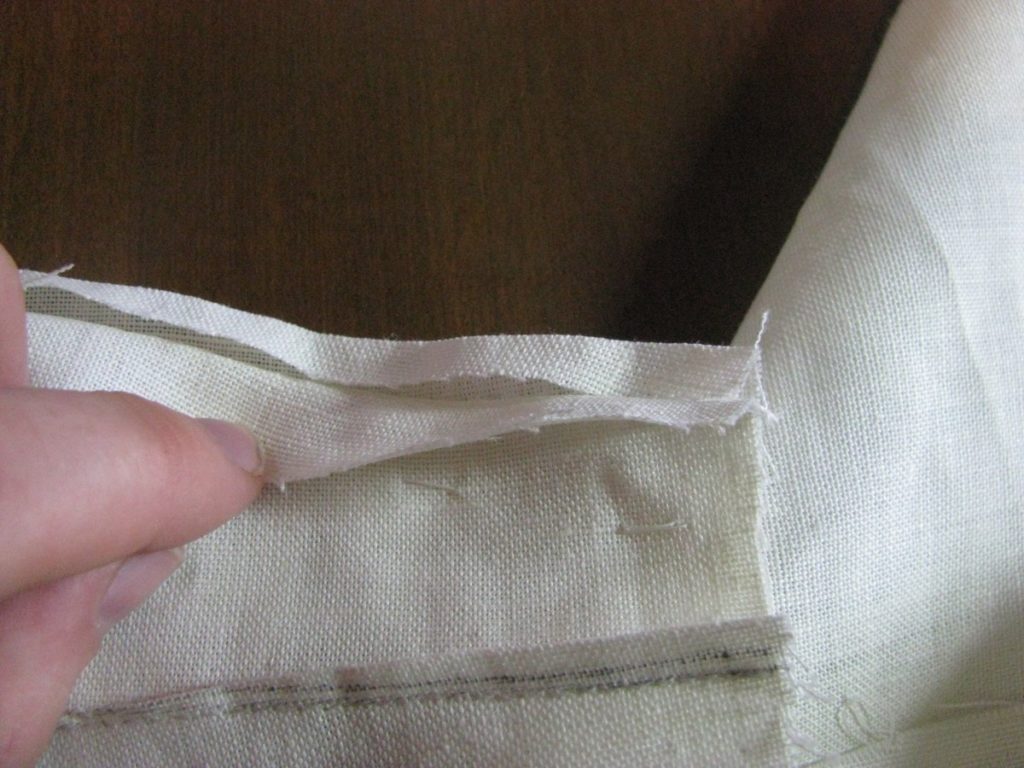
Fold over the top seam allowance of the pocket, overlapping the bottom by about a 16th of an inch. Baste.
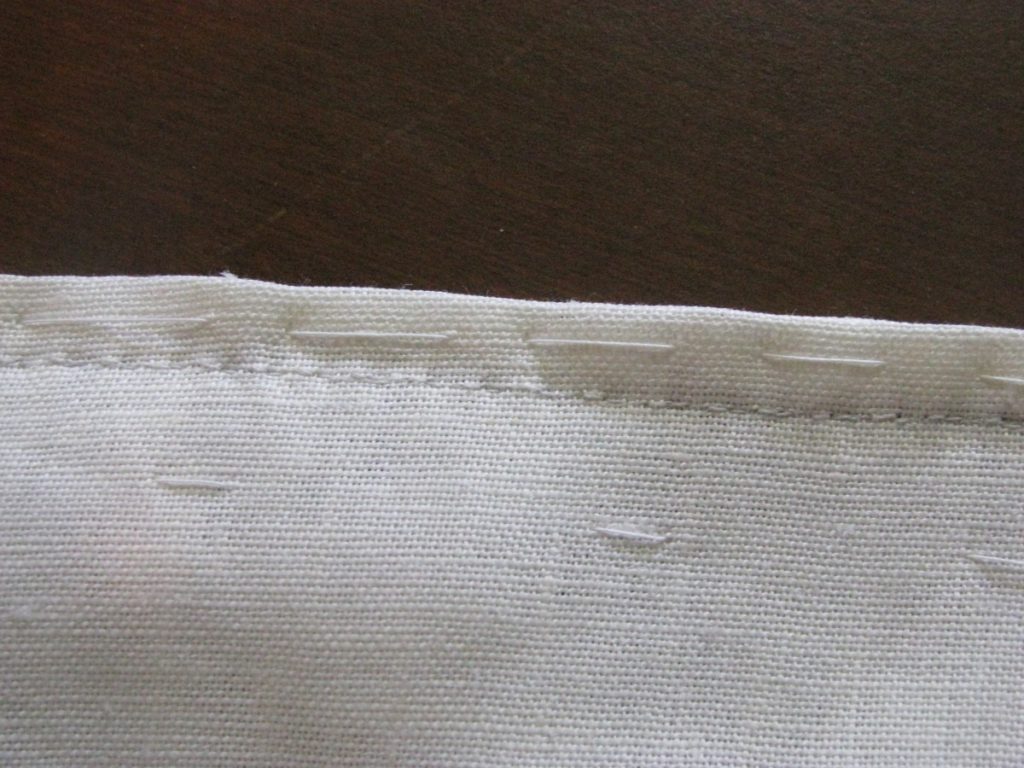
Here’s the view from the underside of the pocket. Note the overlap, ensuring the wrong side will be hidden from view.
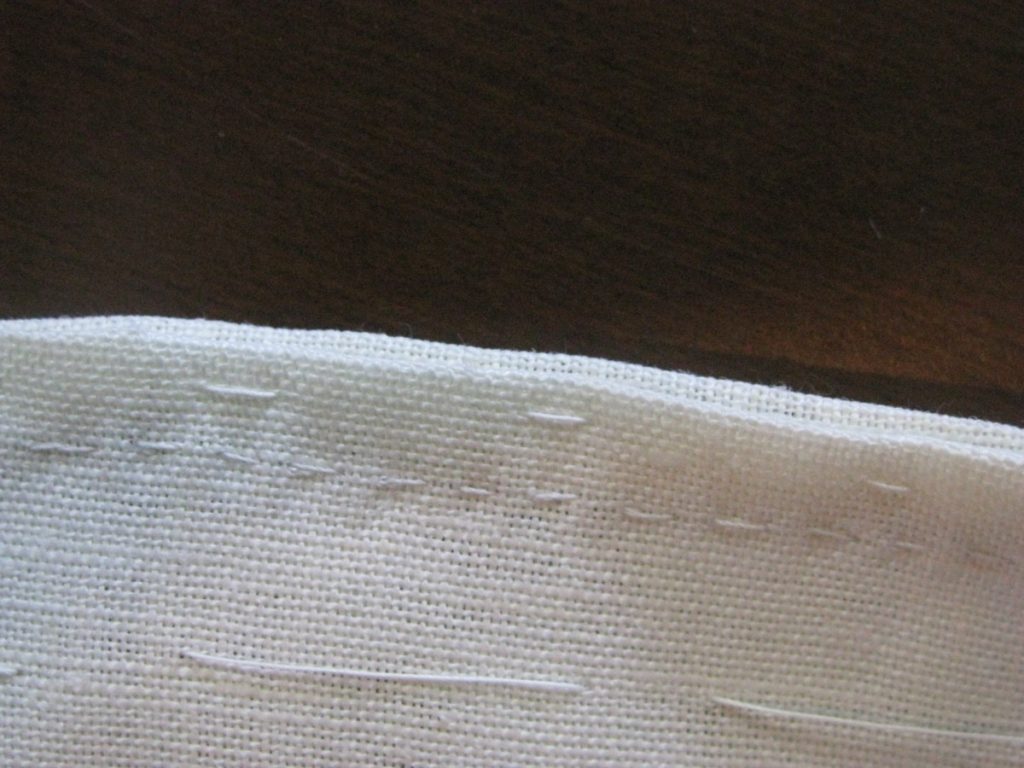
Here’s the pocket with the seam allowance fully basted in place. This hides all of the raw edges on the pocket. Working from the underside, fell down the seam allowance and remove the basting stitches.
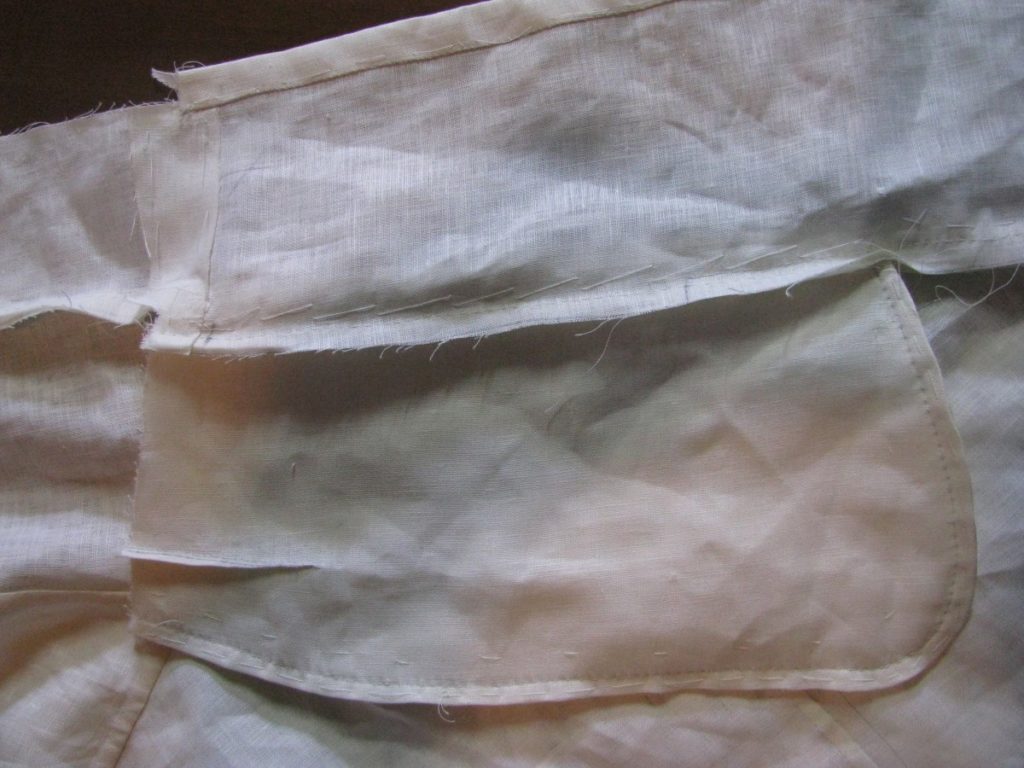
The Back
It’s time to attach the back of the coat to the forepart assembly. Begin by laying the back piece right sides together to the forepart. Pin together with a single pin at the top of the pleats.
The pockets should align at the top. I’m not sure why they don’t in this photo, but apparently I fixed the error before moving on!
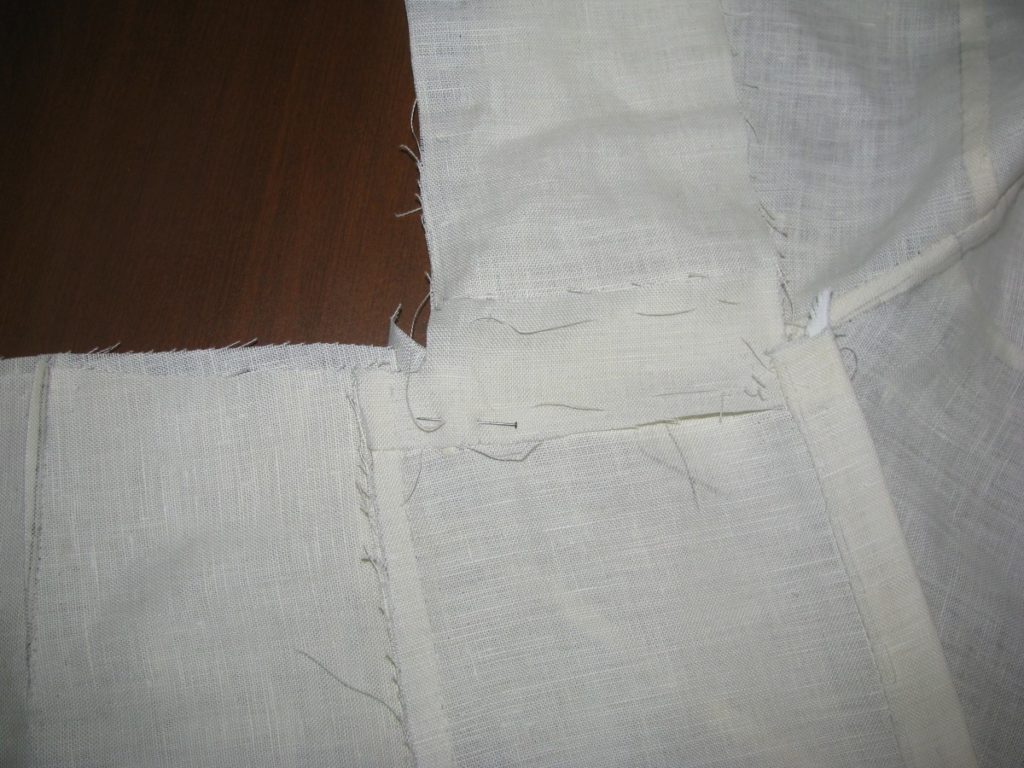
Starting at the top at the armscye, align the back and side-body together with a half-inch seam allowance. Begin basting these together, and as you are working your way towards the waist, work the extra fullness in with your fingers just before you baste it. If you feel the need, you can pin this seam beforehand, but I believe with a little practice, you can do without. It makes for much quicker assembly and actually gives a smoother appearance, I’ve found.
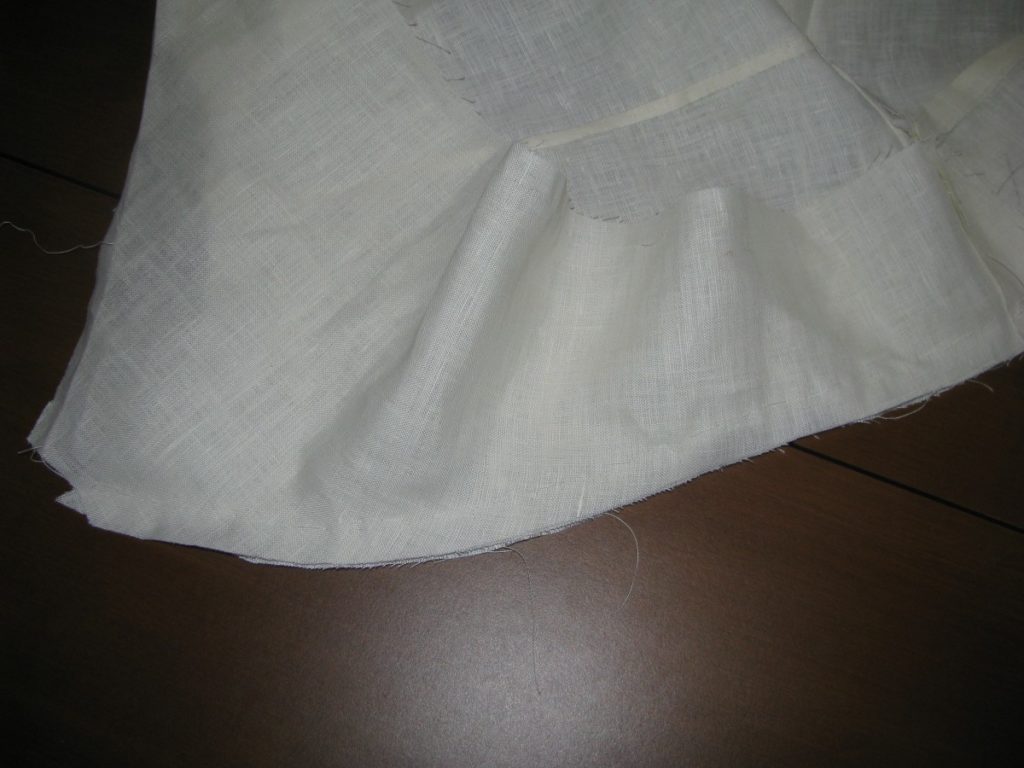
This step is difficult to explain in words, so I made a quick video of it. Hopefully this is helpful to you.
Baste around the top of the pleats, following the edge of the back piece.
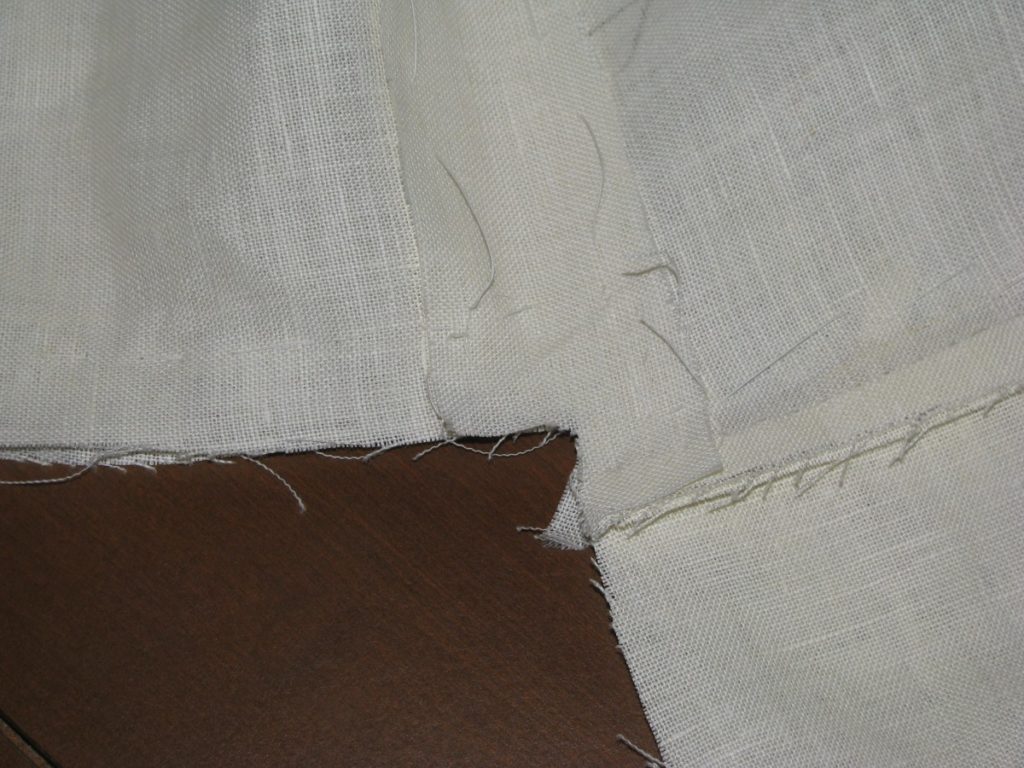
When you get to the pin, do a back stitch in place for security, and move the pin to the bottom of the pockets, making sure they are aligned.
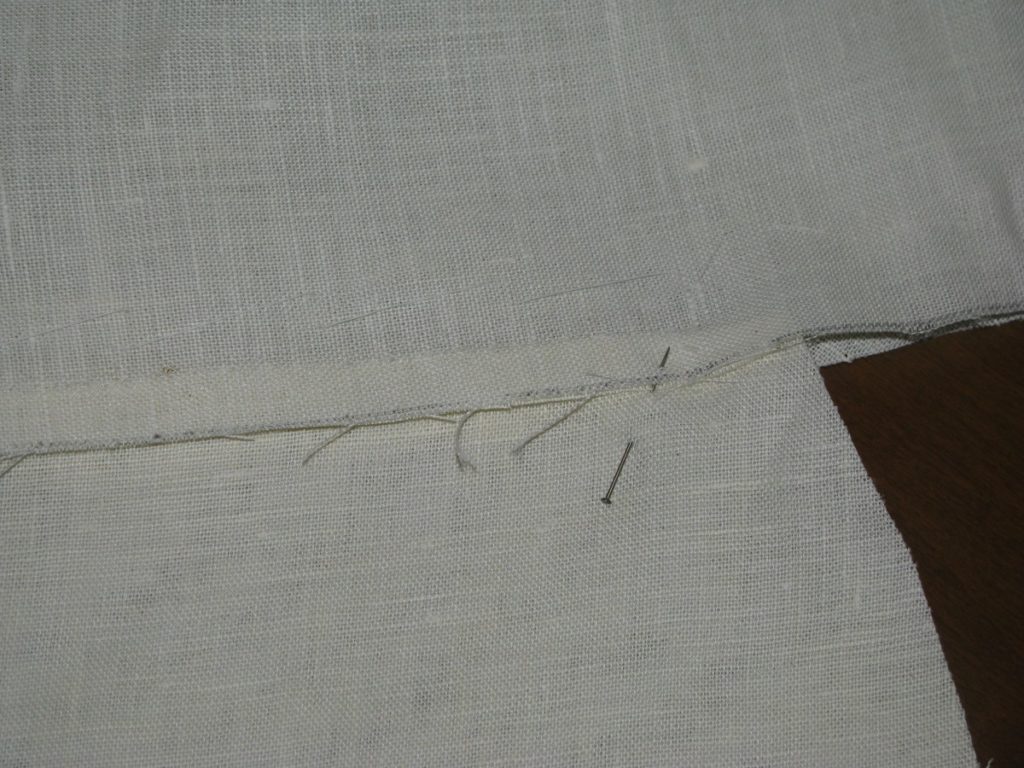
Continue basting along the back skirt. You need to make sure it is aligned perfectly with the front skirt below it, but this is difficult as the pockets are blocking your view. What I do is feel for the pressed back edges of the pocket and align those instead, while I’m basting.
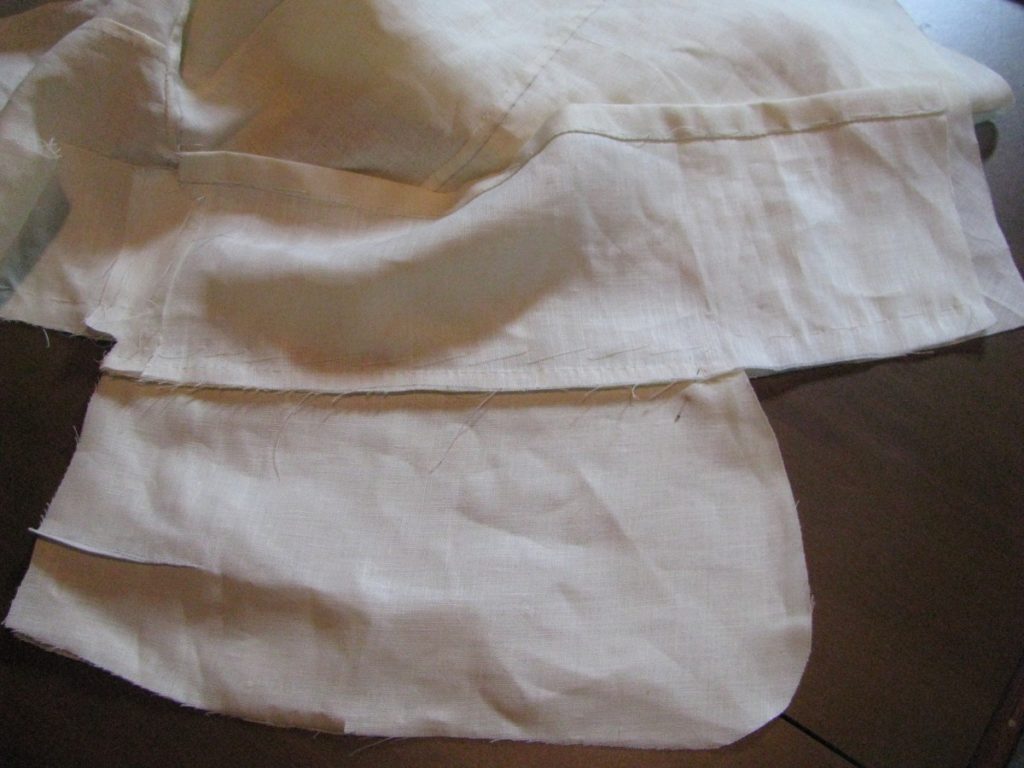
About 1 1/2″ from the top of the pleats, mark a line signifying the top of the pocket opening. The ruler says 1″ in the photo but I later changed that after realizing it wasn’t enough room.

About 8″ below this, mark the bottom of the pocket opening. I’ve found 8″ gives me comfortable access to the pocket, but if you have smaller hands or a smaller coat, you could reduce this by up to an inch.
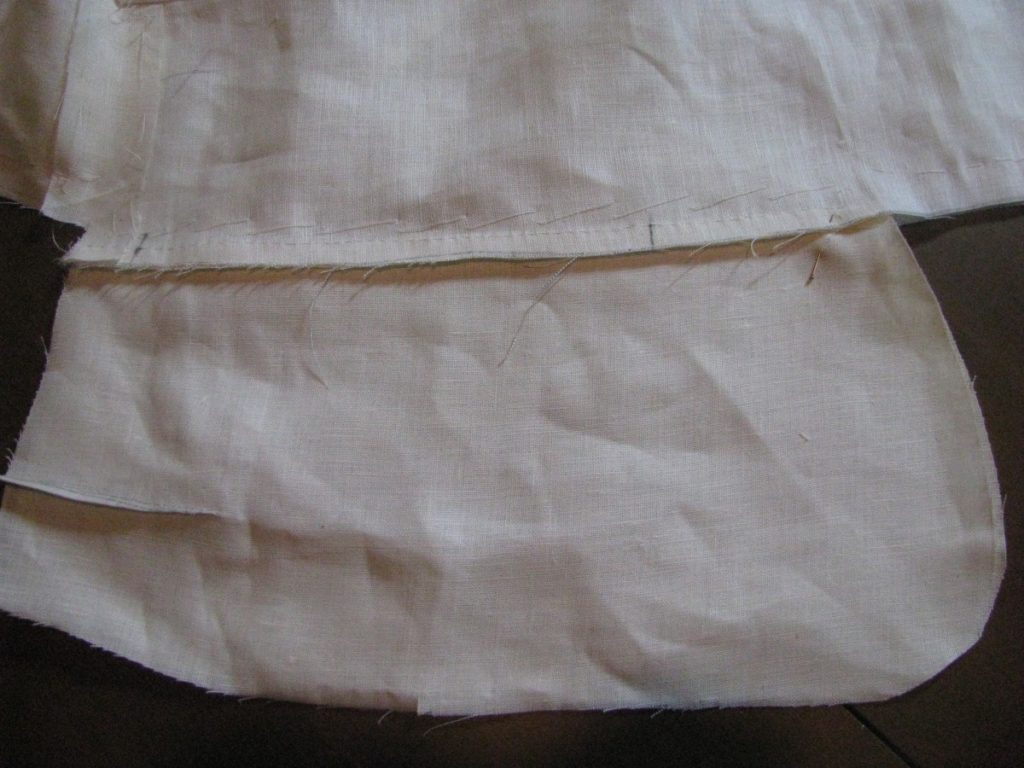
Now that the back has been completely basted, hold the coat with the side body facing up and begin sewing the seam 1/2″ from the edge, from the armscye to the top of the pocket mouth. The ‘right’ side of the stitching should be on the side body, so that we can press it towards the back piece, where it will lay better.
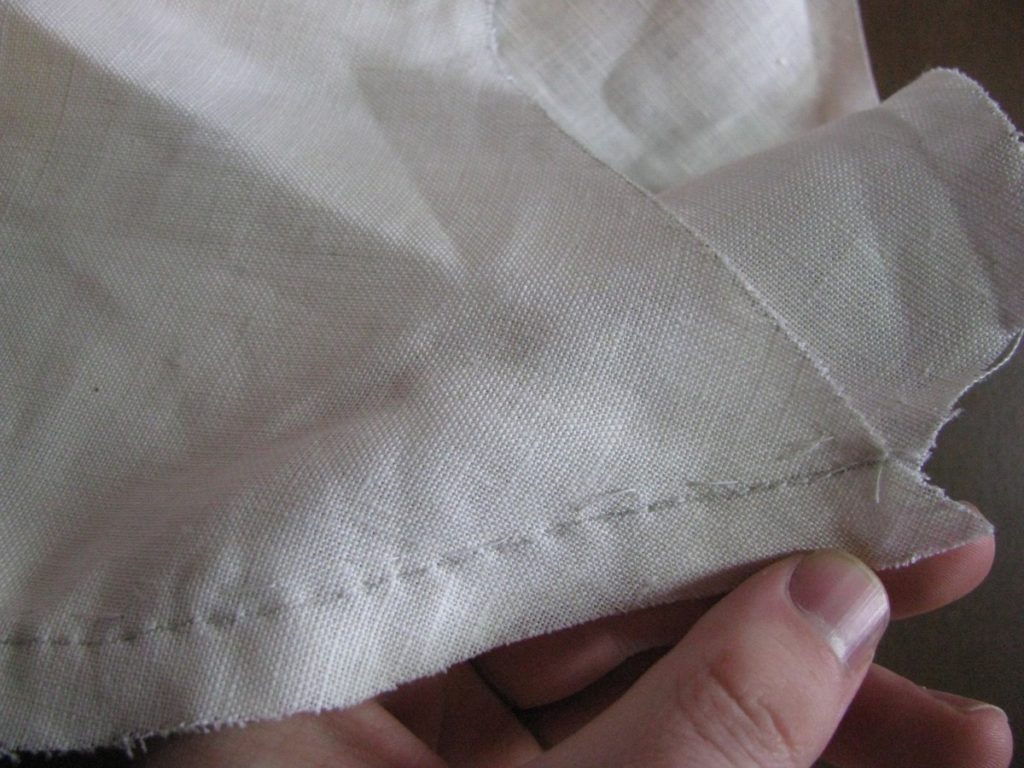
When you get to the top of the plait, remember to follow the contours, remaining 1/2″ from the edge at all times. End the stitching at the top mark with a few stitches in place. Sorry this photo is such a mess.
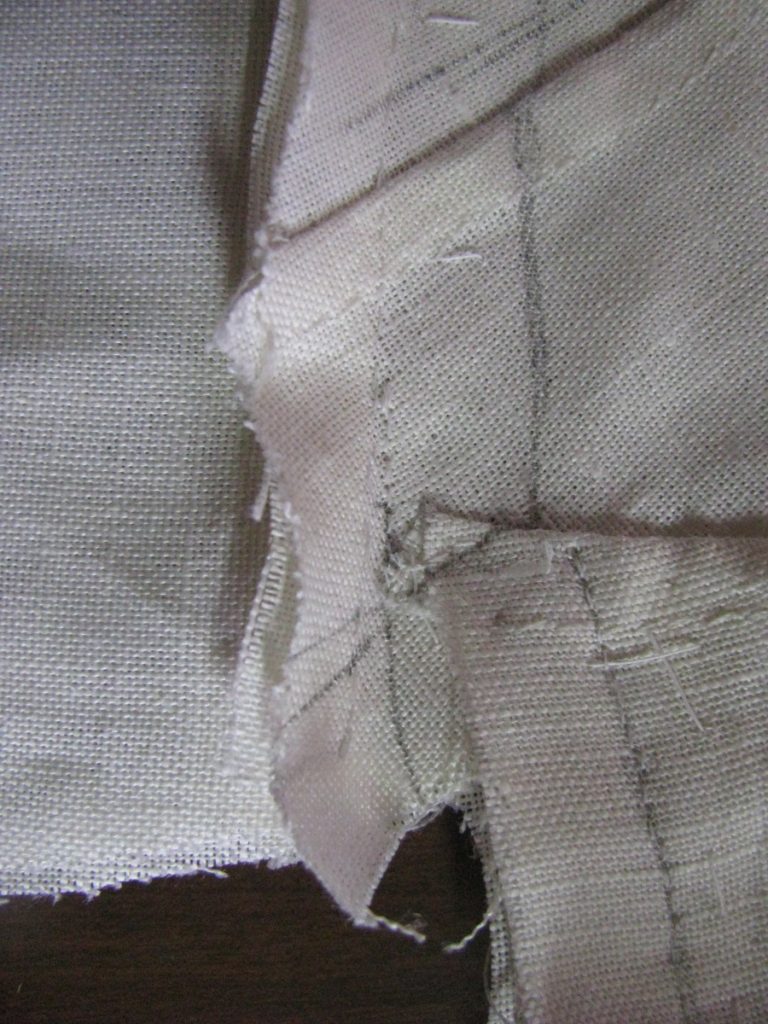
Beginning at the bottom of the pocket opening, continue stitching all the way down to the bottom of the skirt. The seams of the pocket should be just inside the seam allowance, so as to be hidden from the outside view.
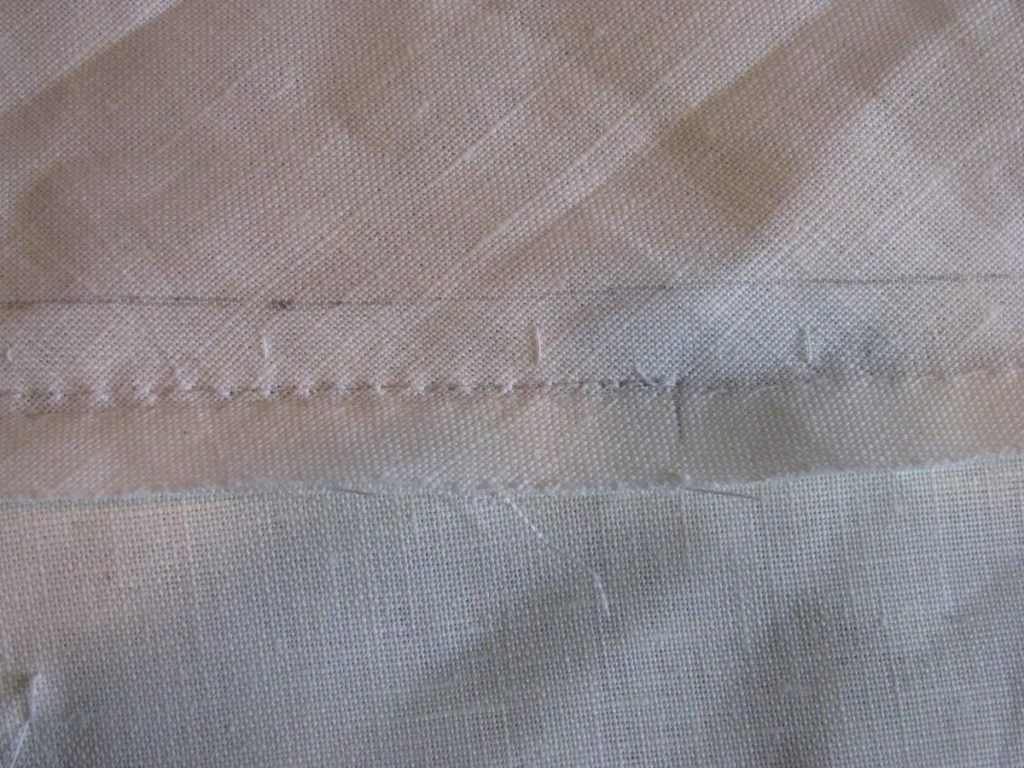
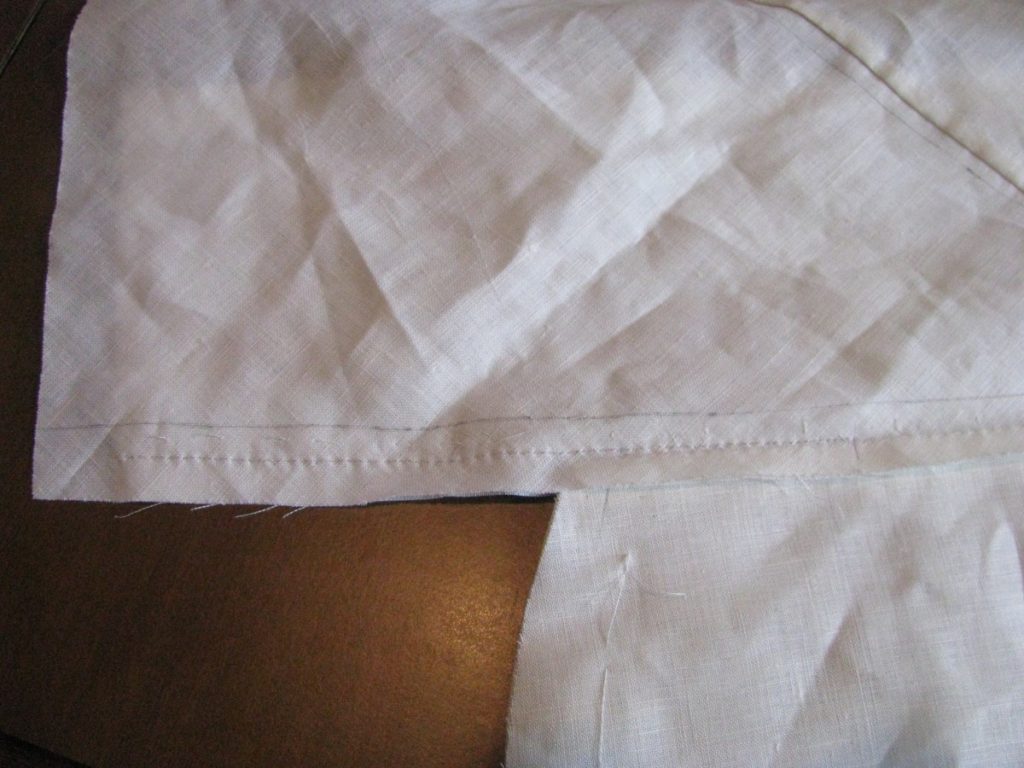
Plait Pockets
Having drafted and cut out the pockets, we are ready to begin the construction and installation process. It is somewhat involved, as the pockets are integrated into the back seam and have to be installed at the same time.
To begin, the darts must first be sewn into the pockets. These darts help the coat sit better around the seat, and allow the skirt to drape more freely. The darts are sewn as before, and pressed in opposite directions, so that the bulk of the material is distributed more fully.
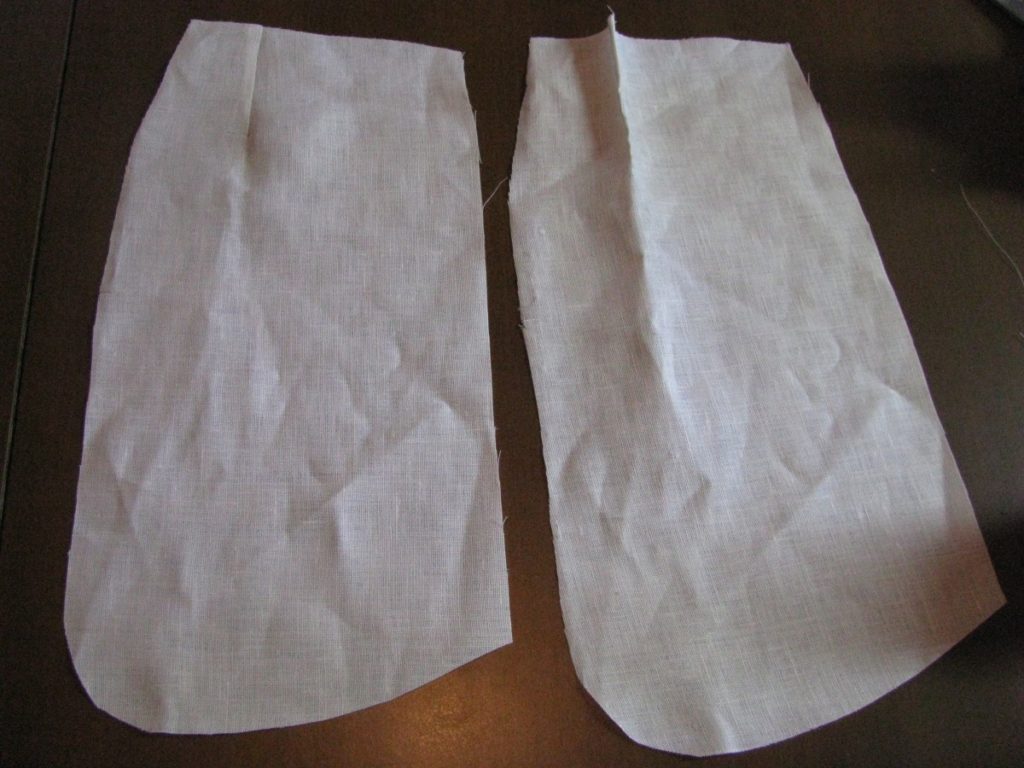
There’s an option to think about here: you can place the darts on the wrong side of the pockets, which would mean they are visible when the coat is completed. The inside of the pockets would be free of any obstructions caused by the darts. On the other hand, you can place the darts on the right sides of the pockets, which would mean they are hidden from view on the finished coat, yet you would feel them when placing items into the pocket. I chose to have my darts on the wrong side.
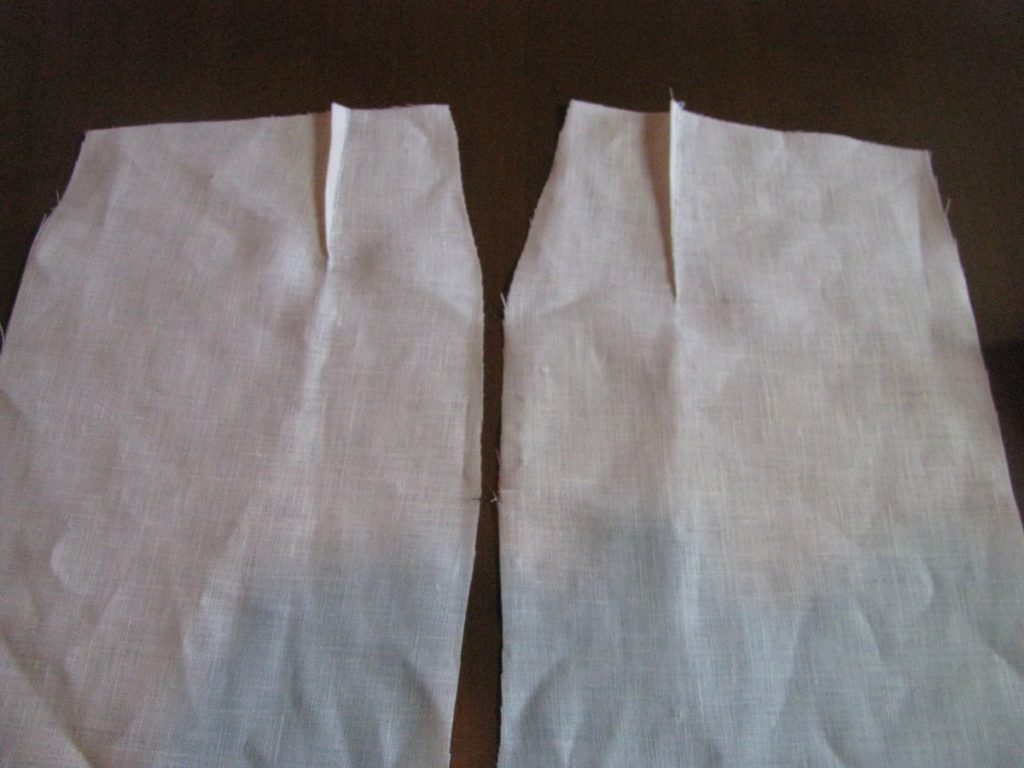
With right sides together, carefully lay the back piece over the forepart assembly, being sure that the inner corner of the pleats lines up properly.
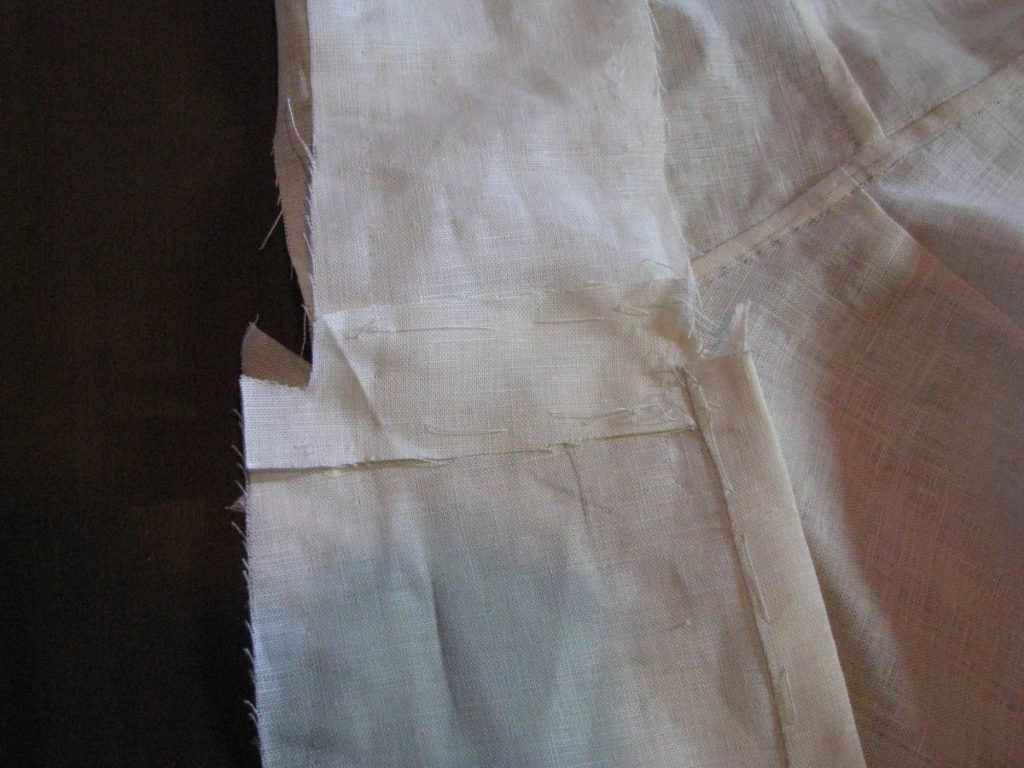
The angles of each pleat are most likely different.

Using the angle of the back piece as a guide, draw a line across the top of the pleat as shown. This marks the position of the top of the pockets.

Lay one of the pocket halves onto the skirt, aligning the top of the pocket with the mark at the point where it meets the edge of the cloth. You can do right sides or wrong sides together, as noted above. Baste the pocket in place along the edge, about 5/8 from the edge.

Here’s a closeup showing the alignment of the pocket.
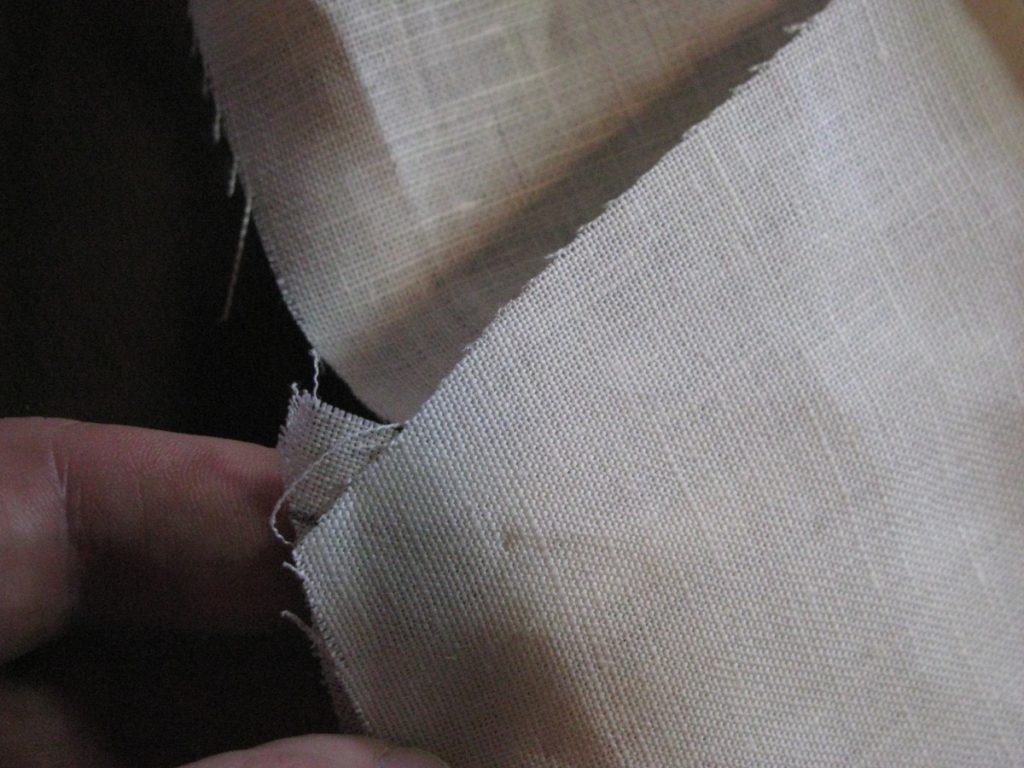
Repeat the process, attaching the other half of the pocket to the back of the coat. The pocket should align with the top of the pleat. Baste into place.
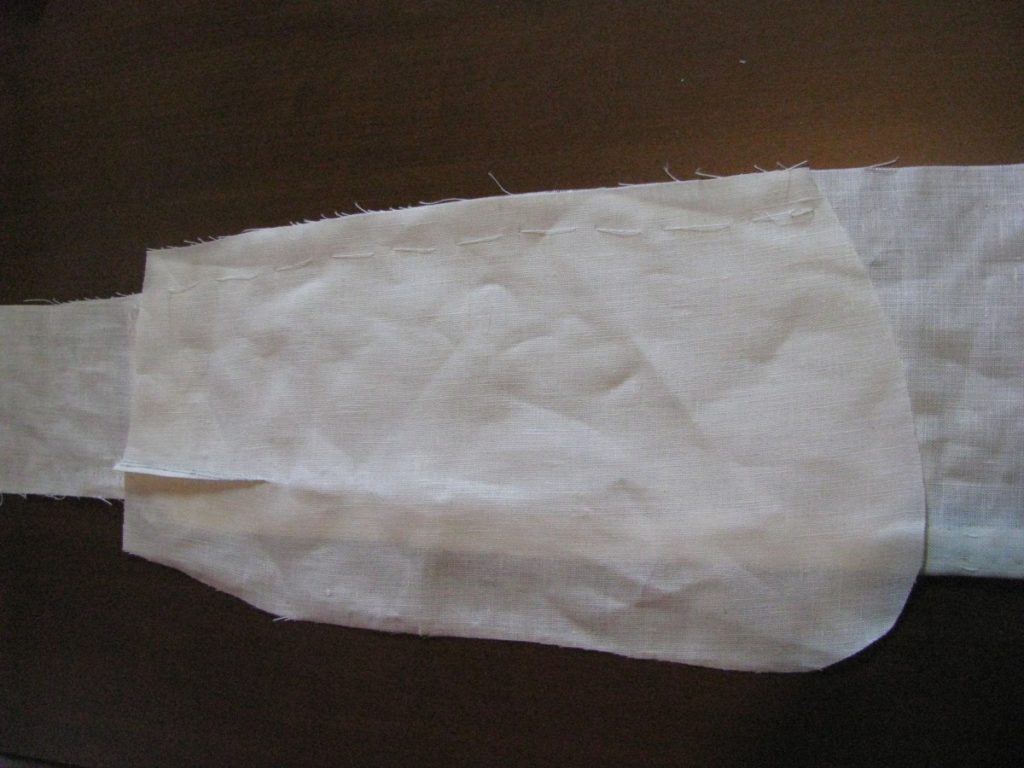
Here is the alignment of the pocket at the top. You may wish to lay the back onto the forepart again to check the alignments of the pockets, especially at the bottom. They should all line up if you worked with accuracy.
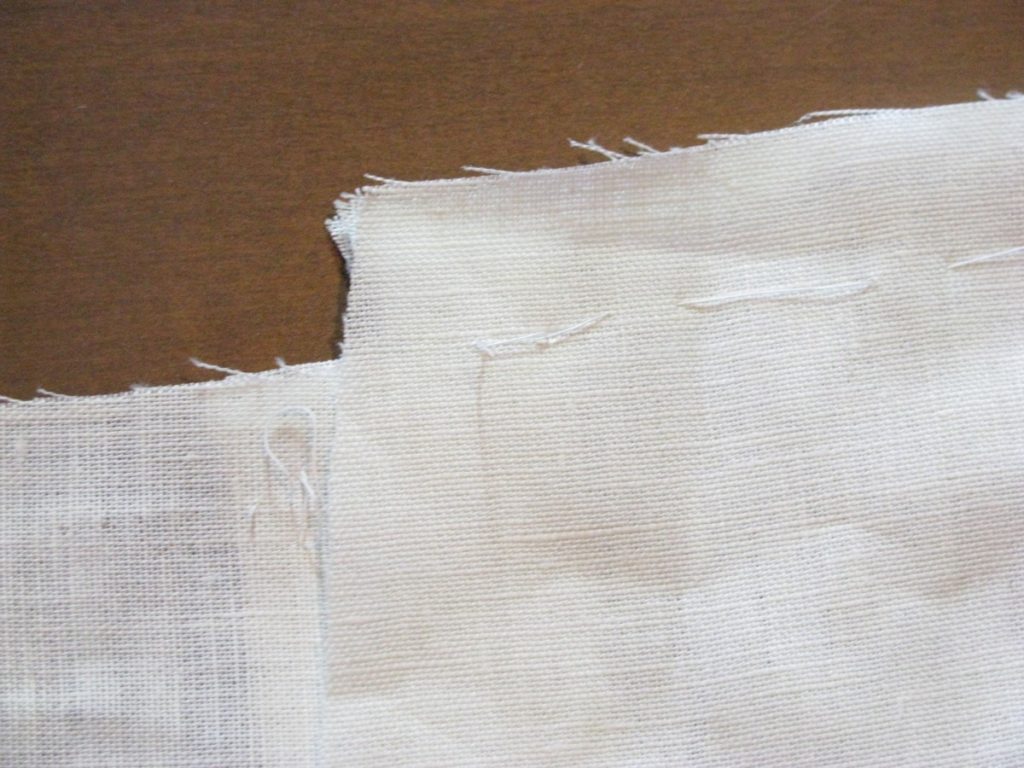
Now mark out a seam allowance just slightly under 1/2″ away from the edge, or 7/16″. This seam needs to be slightly smaller than normal so that it will be hidden from view when the back is sewn to the main skirt. The seam starts at the very top of the pocket . . .
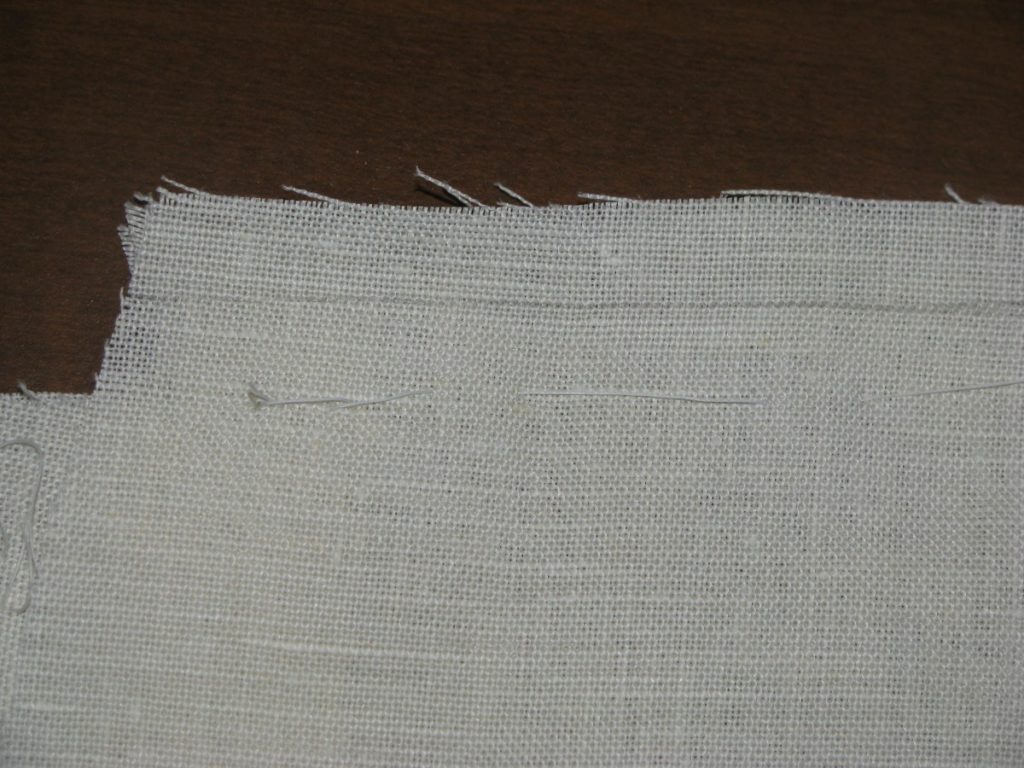
and ends 1/2″ from the bottom. This gives room to turn in the raw edges later.
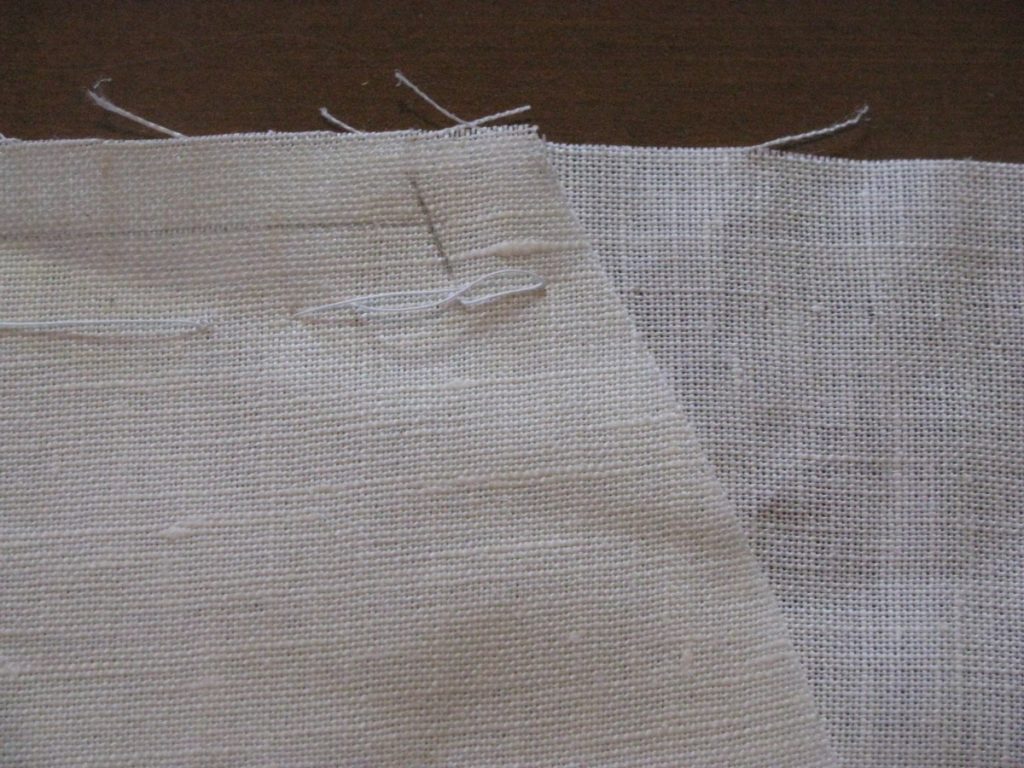
Sew the seam with a backstitch or back and fore stitch, and press the pocket back.
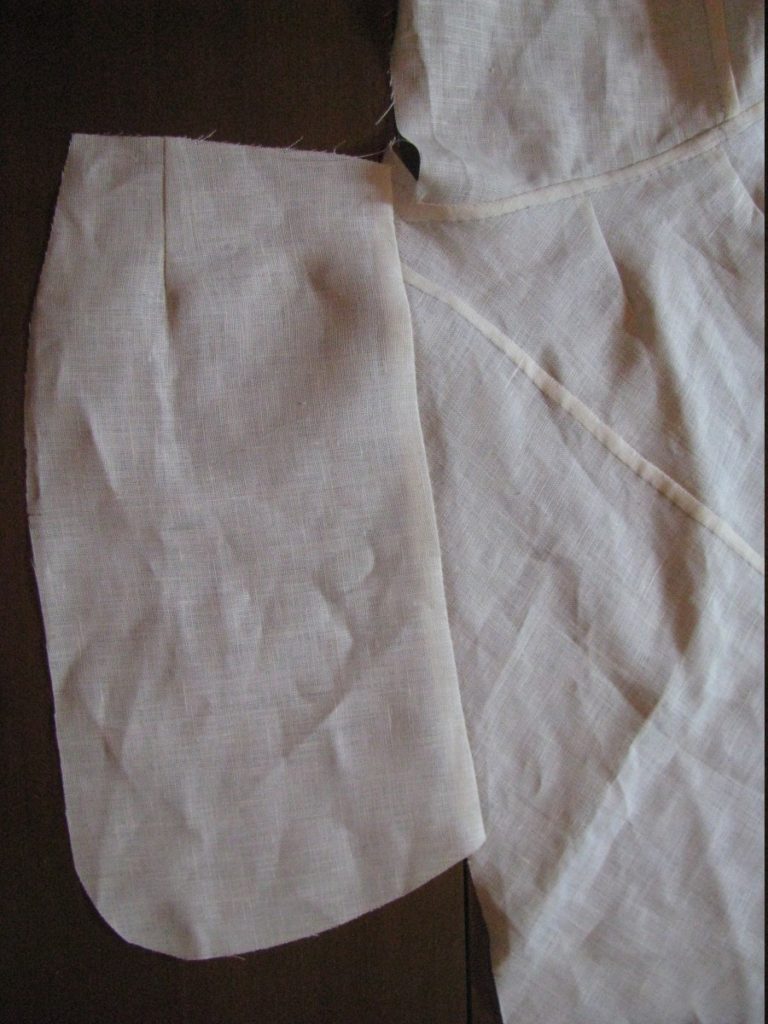
Repeat the process for the other half of the pocket.
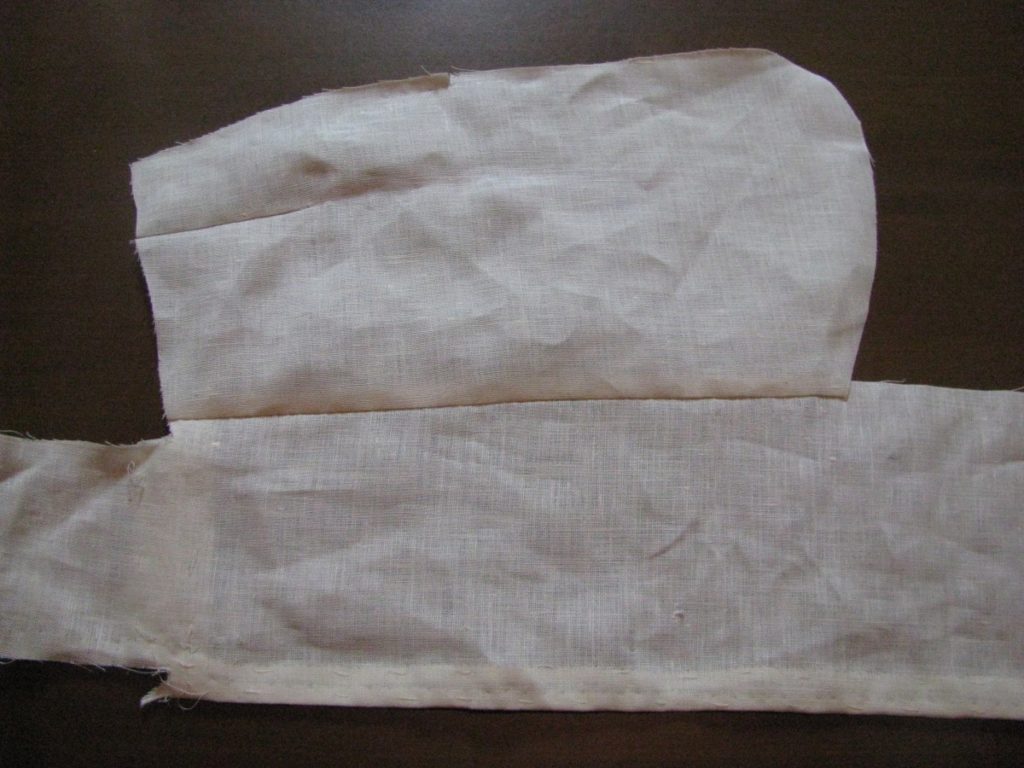
Here is the inside view. Note that the pocket is merely pressed back – the seam is not opened.
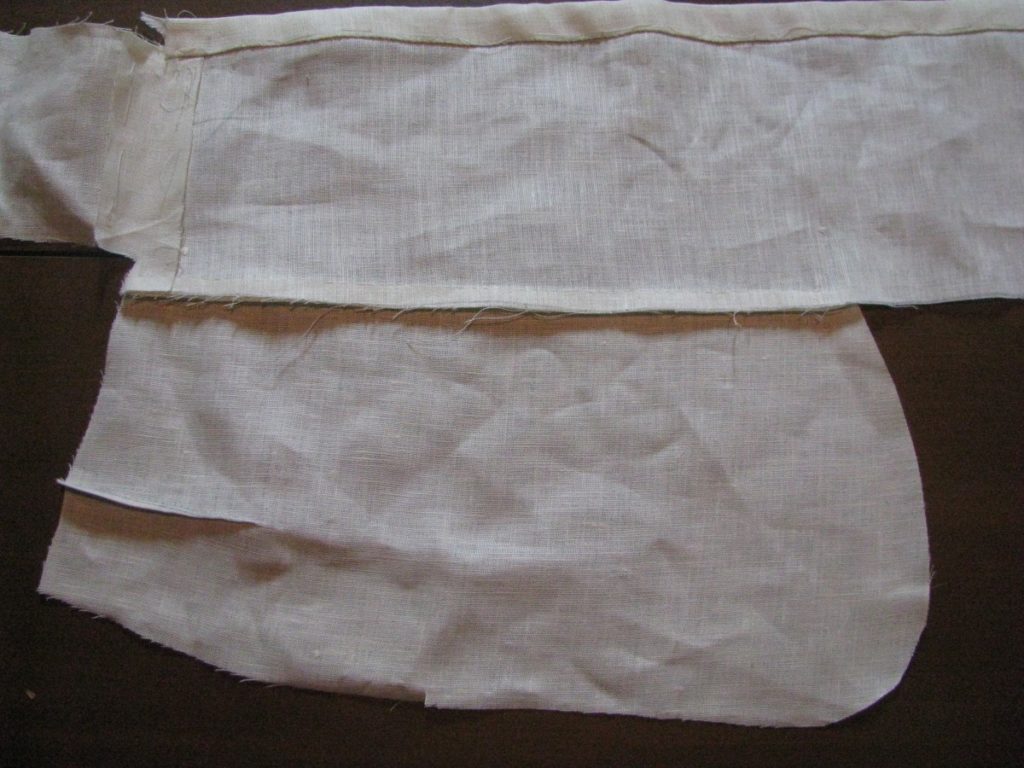
Drafting the Plait Pockets
Begin by drawing a vertical line 14 inches long. On the right, or bottom of the pocket, square out another line 6 to 7 inches wide. These numbers are both variable according to how long your skirt is, and how large your coat is, but this is a good starting point. Also include the seam allowances in this measurement, so an extra 1/2 inch total.

On the left, or top of the pocket, draw a line square across that is about 1/2″ to 1″ smaller than the bottom width. Connect the two end points with another line, extending this line past the top of the pocket.
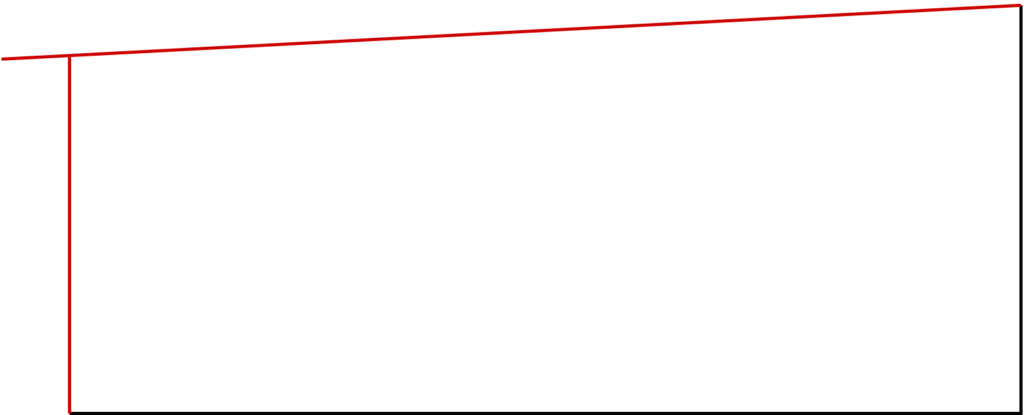
At the top, extend the first line about 1 inch, and redraw the top line at an angle.

At the top and right sides, add curves to each. This will add fullness to the pockets, and allow them to hang freely without affecting the drape of the skirts.

Again at the top, add a dart to the pattern. This should be placed roughly in the middle of the pocket. The construction line of the dart comes down vertically about 2 to 4 inches. The total width is 1/2 inch. Finally, redraw the top seam so that the seams of the dart agree in length.

Finally, round the bottom outer corner to give a pleasing look and make it easier to retrieve items from the pocket.

Finally, curve the bottom of the pocket as shown, if desired. This shaping allows items in the pocket to roll down, away from the pocket opening, which in turn gives a better drape to the skirts.

Here is my completed pattern, and one pocket cut out. Cut two halves for each pocket. Note that as before, I did not cut out the dart from the cloth.
